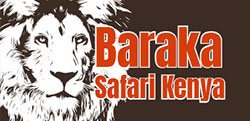

Quanto costa un Safari in Kenya? Come risparmiare senza sorprese!
Vuoi fare un safari in kenya e sei alla ricerca di prezzi ed informazioni utili in questo articolo, cercheremo di fornirti una panoramica completa sui costi per visitare i vari parchi del paese, aiutandoti a compiere la scelta migliore ed a tutelarti dalle insidie che potresti incontrare . sei pronto benissimo, allora buona lettura.
Per comodità abbiamo suddiviso i Safari in Kenya per numero di notti.
- Safari 1 notte – scopri il costo
- Safari 2-3-4 notti – scopri il costo
- Safari 5-6 notti – scopri il costo
- Safari Aereo – scopri il costo
- Viaggio di Nozze – scopri il costo
Vai alla tabella dei prezzi
Soggiorni a Watamu? Ecco il Safari che fa per te! Parco Tsavo Est da 200€ (1 notte)
Il Parco è estremamente accessibile per i viaggiatori che soggiornano nella zona di Watamu e Malindi, infatti si raggiunge in Jeep in 2/3 ore (stanno asfaltando la strada che conduce al parco, quindi i tempi si accorceranno ulteriormente), è possibile visitare il parco in giornata, ma noi consigliamo di passare almeno 1 notte nei meravigliosi Lodge interni o appena fuori dal parco, il pernottamento può essere nella classica camera + bagno o in campo tendato (esperienza fantastica da provare). Tutti i Lodge offrono un servizio di buon livello, alcune strutture sono veramente notevoli con piscine, saune e la possibilità di svolgere attività di fitness.
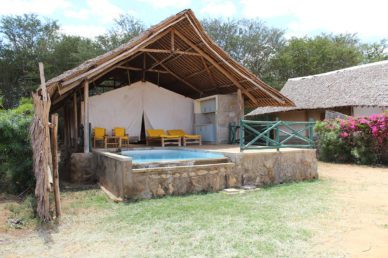
Il costo parte da 200€ a persona adulta , ci sono agevolazioni per bambini e gruppi. Consigliamo in ogni caso di consultare il programma e richiedere sempre un preventivo dettagliato, il costo potrebbe essere più accessibile in determinati periodi dell’anno e dipende principalmente dalla struttura in cui deciderete di pernottare.
IMPORTANTE – Scegliere la Jeep (non il pulmino) per vari motivi. Le strade del parco sono talvolta tortuose e quindi la Jeep è più adatta e confortevole, ma sopratutto perché solo con la Jeep si possono raggiungere punti di avvistamento e sentieri più nascosti e fruttuosi!
ATTENZIONE – Prenotate il safari con anticipo! Per chi fa la classica vacanza mare a Watamu , consigliamo di organizzare il Safari nei primi giorni della settimana per poi terminare la vacanza in relax. Inoltre, prenotando prima potrete godere di una maggiore scelta per quanto riguarda i Lodge ed i campi tendati.
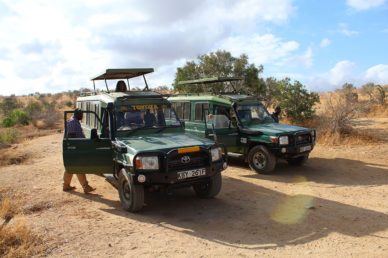
Il migliore Safari in Kenya? Vola al Masai Mara! Parco Masai Mara da 700€ (1 notte)
Facciamo riferimento sempre ai turisti che soggiornano a Watamu e Malindi, punto di partenza per il 90% dei safari che organizziamo. Possiamo dire con assoluta certezza che il parco Masai Mara offre l’esperienza più appagante per chi vuole fare un safari di pochi giorni in Kenya, il costo del Safari Masai Mara è più impegnativo per via del volo aereo , (si parte dall’aeroporto di Malindi) il parco si trova a circa 700 km verso nord-ovest e per raggiungerlo in Jeep sarebbe necessario un giorno intero di viaggio da Malindi-Watamu.
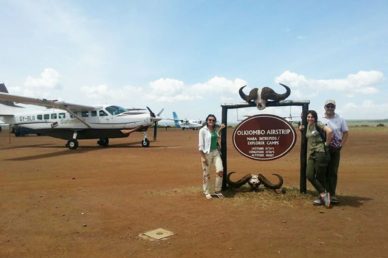
Il Masai Mara è l’estensione in Kenya del famosissimo parco del Serengeti della Tanzania, è una riserva molto ricca di animali con la più alta concentrazione di Leoni. Nel periodo compreso tra luglio ed agosto è possibile assistere ad un fenomeno estremamente affascinante: la migrazione degli Gnu . Migliaia di capi attraversano il confine dalla Tanzania al Kenya in cerca di pascoli più abbondanti… la sosta degli Gnu all’interno della riserva del Masai Mara dura circa 2 mesi, in questo periodo molti animali predatori approfittano della grande quantità di bestiame per cacciare. E’ estremamente probabile assistere a scene di caccia con rincorse ed agguati da parte di Leoni, Leopardi, Ghepardi ed altri animali predatori.
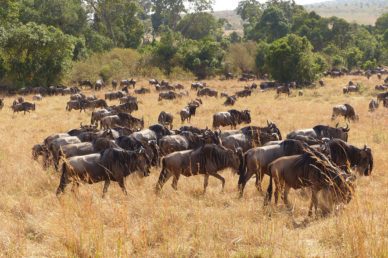
IMPORTANTE – Consigliamo di dedicare almeno 3giorni e 2 notti a questo safari , per ammortizzare il viaggio aereo, ma sopratutto per godere a pieno delle moltissime opportunità che offre questo Safari in relazione a quantità di animali e luoghi da visitare.
ATTENZIONE – Il volo interno è operato con velivoli ad elica di piccole dimensioni, in Kenya i trasferimenti interni negli ultimi anni sono stati pesantemente ridotti ed esistono poche compagnie veramente affidabili, consigliamo di richiedere con largo anticipo un preventivo , per beneficiare di eventuali raggruppamenti in aereo (i velivoli in genere hanno 6-8 posti) e prenotare con le compagnie più affidabili.
Safari di 3 giorni e 2 notti. Costi alla portata di tutti! Parco Tsavo Est + Tsavo Ovest Parco Tsavo Est + Amboseli Parco Tsavo Ovest + Amboseli costi a partire da da 370€
Il parco Tsavo Est, il Parco Tsavo Ovest ed il Parco Amboseli si trovano nella stessa area geografica del Kenya , lo Tsavo si può definire un parco unico diviso in Est ed Ovest dal fiume Galana, l’Amboseli invece dista circa 100 Km verso nord ovest.
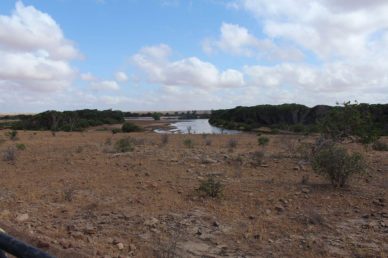
Il punto di partenza di questi Safari è sempre Watamu , l’itinerario prevede di raggiungere e visitare per primo il parco Tsavo ed il giorno seguente trasferirsi in uno dei due parchi adiacenti. Anche per questi Safari consigliamo di preferire la Jeep , anche se con il pulmino si potrebbe risparmiare qualcosa… qui sotto il dettaglio dei costi. Ogni parco necessita di almeno 1 giorno per poterlo visitare, quindi il costo di questi safari comprende 2 notti di pernottamento. I costi variano, anche in questo caso, in relazione alle strutture dove si decide di passare la notte , per completezza riportiamo i costi base per un Safari in Kenya di 3 giorni e 2 notti nelle varie combinazioni:
SAFARI CON JEEP Costo Safari in Kenya di 3 giorni (2 notti) con Lodge di Categoria Superiore: 400€ a persona (4 stelle o più) Costo Safari in Kenya di 3 giorni (2 notti) con Lodge di Categoria Inferiore: 380€ a persona (3-4 stelle)
SAFARI CON PULMINO Costo Safari in Kenya di 3 giorni (2 notti) con Lodge di Categoria Superiore: 385€ a persona (4 stelle o più) Costo Safari in Kenya di 3 giorni (2 notti) con Lodge di Categoria Inferiore: 370€ a persona (3-4 stelle)
IMPORTANTE – Sebbene il famoso Kilimangiaro si trovi in Tanzania, in linea d’aria dista circa 20 km dal parco Amboseli, consigliamo di scegliere il safari con questo parco per chi vuole vedere il leggendario vulcano più alto d’Africa e fotografare Zebre, Giraffe ed Elefanti con sullo sfondo la sua vetta innevata.
TAITA HILLS – Sempre per chi sceglie il safari con il parco Amboseli è possibile visitare la riserva naturale di Taita Hills (è necessario aggiungere all’itinerario 1 giorno e 1 notte). Taita Hills è una zona molto suggestiva del Kenya a nord del parco Amboseli, si trova in un area montuosa immersa nel verde molto ricca di animali. La particolarità di questo parco, oltre al paesaggio estremamente suggestivo e diverso dalla savana è la possibilità di fare un safari notturno.
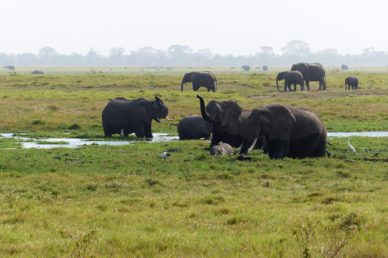
Safari in Kenya di una settimana. Un esperienza indimenticabile
Safari di 6 giorni (5 notti).
Masai Mara + Nakuru Lake + Amboseli + Tsavo Est
Safari di 7 giorni (6 notti)
Masai Mara + Nakuru Lake + Amboseli + Tsavo Est + Tsavo Ovest
costi a partire da 1220€
Nairobi è il punto di partenza di questi 2 Safari , la famosa capitale si trova al centro di un triangolo immaginario che collega i parchi Nakuru, Masai Mara e Tsavo, risulta quindi più agevole e (vedremo in seguito) anche meno costoso , partire Nairobi rispetto che da Mombasa o Malindi.
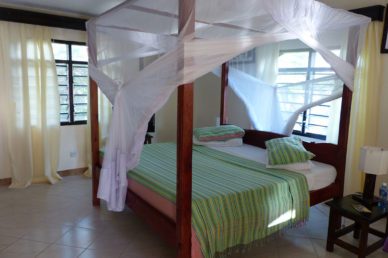
L’itinerario prevede di iniziare il safari dal parco Masai Mara , in questo caso da Nairobi con solo 3 ore di Jeep si arriva all’ingresso del Parco, da Mombasa o Malindi sarebbe necessario un trasferimento aereo, in quanto sarebbero necessarie 12 ore di Jeep. Abbiamo già detto che il Masai Mara è il parco che offre un esperienza unica nel suo genere per l’enorme quantità di animali che lo abita, si passano 2 giorni in questo parco e poi si procede a Nord verso Nakuru Lake , questa riserva prende il nome dall’omonimo lago che contraddistingue il paesaggio verdeggiante e ricco di vegetazione ed animali d’acqua come i bellissimi fenicotteri Rosa. Questo parco è abitato anche da Rinoceronti ed una vastissima varietà di uccelli. Terminata la visita di un giorno al Nakuru Lake si parte per l’Amboseli, il trasferimento è piuttosto lungo e si arriva verso l’ora di pranzo, (circa 6 ore), da questo parco è visibile a poca distanza il famoso Kilimangiaro . Il giorno seguente si riparte per il parco Tsavo, nel caso del safari di 6 giorni si visita solo lo Tsavo Est, per il safari di 7 giorni si attraversa il fiume Galana e si visita anche lo Tsavo Ovest.
IMPORTANTE – Il grande vantaggio di questi 2 itinerari, sta proprio al termine del safari, infatti l’utlimo parco previsto dal programma è lo Tsavo che si trova circa a metà strada tra Nairobi e Malindi, poche ore di trasferimento per chi rientra , ma i più attenti hanno già intuito che diventa estremamente interessante terminare il viaggio nella costa e passare qualche giorno di relax nello splendido mare di Watamu.
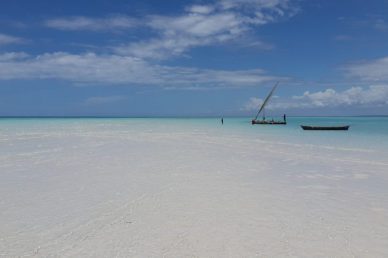
Nella tabella qui sotto tutte le opzioni disponibili, cliccate sui link di vostro interesse per vedere il programma completo e richiedete il vostro preventivo personalizzato.
CONSIGLI FINALI
Siamo giunti al termine del nostro racconto, speriamo di essere stati chiari ed esaustivI. Vogliamo darvi ancora qualche consiglio utile per vivere al meglio il nostro meraviglioso paese:
- Consultate il medico prima di partire per il vostro Safari in Kenya, vi consiglierà di prendere dei fermenti prima e durante il viaggio e vi darà indicazioni su come affrontare imprevisti ed il tema della Malaria (tratteremo questo aspetto nei prossimi articoli, seguiteci!)
- Portate con voi lo stretto necessario, l’ideale per viaggiare in safari è un trolley piccolo, non dimenticate un cappotto e qualche indumento “pesante” talvolta la sera fa un po freschino.
- Non dimenticate obbiettivi e macchina fotografica, per favore non affidatevi agli smartphone, certi scatti potrebbero essere disponibili solo una volta nella vita 🙂
- E per finire, ma non per ultimo, attenetevi strettamente alle regole ed ai consigli delle guide, è estremamente importante osservare diligentemente le istruzioni e le precauzioni che vi verranno impartite alla partenza dei safari, vi ricordiamo che state visitando luoghi selvaggi abitati da predatori ed animali pericolosi.
Grazie per la vostra lettura, speriamo di esservi stati utili… non esitate a contattarci per qualsiasi informazione, oppure commentate qui sotto le vostre esperienze… a presto!
82 Commenti
fuck google
yandanxvurulmus.NW0vSXjDyJ7w
preregistration
xbunedirloooo.K4VH4unzdrA4
reinciting xyandanxvurulmus.ETj8qn6aMUZR
calibrator xyandanxvurulmus.WjNIbZWR26oB
bahis siteleri child porn vurgunyedim.OBAcvD1YFMZH
craft porn yaralandinmieycan.M9GEhzdBUUkF
fuck citixx.8s6Iyv3pwXtL
house porn hyuqgzhqt.pDSTPxyucWHU
bahis siteleri child porn
bahis siteleri porn ewrjghsdfaa.huBqgYpAxqA6
bahis siteleri incest category
craft porn wrtgdfgdfgdqq.Cj42UtKu5Xsw
amciik siteleri
porn sex wrtgdfgdfgdqq.PpqGqaKMLJSK
eski rahatiniz olmayacak
bahis siteleri sikis wrtgdfgdfgdqq.kSSnQQxmu7cs
porno deneme bonusu
Porno keyfini Evooli ile daha iyi çıkartıp hazzı doruklarda yaşamaya hazırsan, hadi durma HD Porno Filmlerini ücretsiz izle.
sektor benim zaten amin evladi pompadirha.JrytxqAoPCbr
seks siteleri asillartaklitler.KLggDgPAFvkl
fuck google hephupx.0JAVwM9INJgH
seksi siteler
am siteleri hepxhupx.VklO10RydJgk
fuck google juljulfbi.1i9Ujet9fSYM
childrens sex
porn sex bjluajszz.vvE3OjtF0B6h
escort bxjluajsxzz.rJqArY0ONzFD
bahis porno
BİZİ SİK BİZ BUNU HAK EDİYORUZ 0qbxjluaxcxjsxzz.r69Qnnw7k3BO
Delhi Escorts
Delhi Escorts Services has gorgeous females who provide Independent Escort Services in Delhi call girls at 100% satisfaction with VIP models. Provided Delhi escorts at our agency are professional and are eager to serve you at your place.
Online bahis dünyası sürekli olarak gelişmekte ve bahis severler için yeni fırsatlar sunmaktadır.
deneme bonusu
senin bacini sikiyim
Hello from Happykiddi.
Fake Rolex Hulk
can nps assist in surgery
Ankara Web Tasarım
erkek parfüm
Sitedeki indirimler gerçekten çok cazip, her zaman buradan alışveriş yapmayı tercih ediyorum, herkese tavsiye ederim, teşekkürler.
İstanbul nakliyat
İstanbul şehirlerarası nakliyat
İnstagram düşmeyen takipçi satın al
thanks good.
fenomenyerim
thanks very good. wow.
Thank You for the Useful Content It Was Beneficial
takipçi satın al
Beğeni satın al, youtube abone satın al, tiktok izlenme satın al, instagram takipçi satın al, bayan takipçi satın al, fenomenyerim.com, dusmeyentakipci.net, takipçi hilesi.
hot porn download
pron download hd gghkyogg.MIaXj7TDIip
April Costa
I just like the helpful information you provide in your articles
super clone rolex
you porn hd videos
porn k hd ggjennifegg.6I6ZK7eD1Yv
porn video free download in hd
full hd pron videos download ggjinnysflogg.Eoqq57e5JuU
Andrea Flynn
Nice post. I learn something totally new and challenging on websites
Fake Rolex Watches
Salvador Edwards
İstanbul Personel Taşimacılıgı
Amanda I. C. Rose
Your ideas and insights are unique and thought-provoking I appreciate how you challenge your readers to see things from a different perspective
Ana Y. Rowe
Hocam Ellerinize Sağlık Gastronize bardak yıkama hakkında Detaylı ve Güzel Makale Olmuş.
Kane Rodriguez
I very delighted to find this internet site on bing, just what I was searching for as well saved to fav
Griffin H. Morton
Your posts are so thought-provoking and often leave me pondering long after I have finished reading Keep challenging your readers to think outside the box
Cannon Banks
Hocam Ellerinize Sağlık Joseph Campbell Hakkında Detaylı ve Güzel Makale Olmuş.
hesap social
Whyper sosyal, steam key satın al.
can nurse practitioners assist in surgery
Azariah Small
Hocam Ellerinize Sağlık, köpek oteli hakkında Detaylı ve Güzel Makale Olmuş.
Antwan Mejia
For the reason that the admin of this site is working, no uncertainty very quickly it will be renowned, due to its quality contents.
Personel Taşımacılığı
Kasey Clarke
I hope these messages are helpful!.
Amiya Lynch
This is really interesting, You’re a very skilled blogger. I’ve joined your feed and look forward to seeking more of your magnificent post. Also, I’ve shared your site in my social networks!
Heidy Mercer
I really like reading through a post that can make men and women think. Also, thank you for allowing me to comment!
pendik escort
Emmaline M. Beasley
Every time I read a new post, I feel like I’ve learned something valuable or gained a new perspective. Thank you for consistently putting out such great content!
Roland Arellano
fashionflag www.hd pirn
fashionflag porn com full hd fashionflag.75dK02cnx5X
goodhere Random porn
goodhere Fetish porn vurucutewet.emzdVbYf1HU
ladyandtherose Funny Porn
ladyandtherose Hardcore porn backlinkseox.lQESmXlxO9k
jenniferroy ハードコアポルノ
jenniferroy 三人組ポルノ japanesexxporns.1oXKrckWMFj
landuse Big cock porn
landuse Mixed porn lancdcuse.7cFS7Zz4grh
falbobrospizzamadison Man Masturbating porn
falbobrospizzamadison Random porn jkkıjxxx.bnhmQS5y8gq
tuzla escort
बड़े स्तन अश्लील
वी आर अश्लील qqyyooppxx.KCwnkUJqHPy
अंतरजातीय अश्लीलता के बारे में बतावल गइल बा
एशियाई अश्लीलता के बारे में बतावल गइल बा hjkvbasdfzxzz.YFzb0qdo1OI
शौकिया अश्लीलता
छोटे स्तन अश्लील txechdyzxca.yYbHb4NPdST
Desirae Daniel
Awesome! Its genuinely remarkable post, I have got much clear idea regarding from this post
Save my name, email, and website in this browser for the next time I comment.
- Destinazioni
Safari in Kenya: prezzi, quando andare e dove
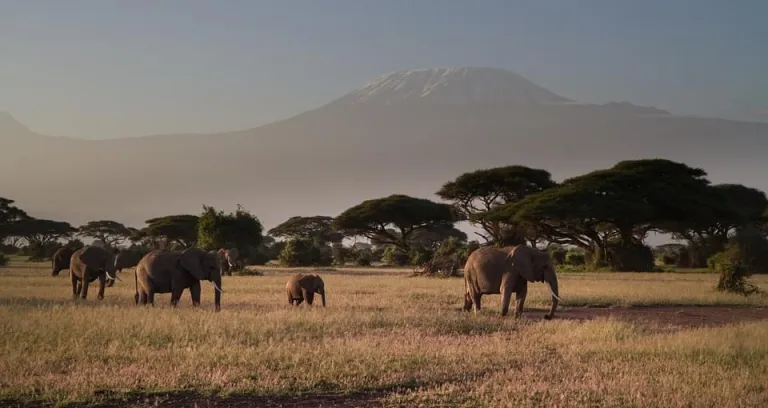
Quando andare: periodo migliore per un Safari n Kenya
- Tsavo National Park Est
- Tsavo National Park Ovest
- Lago Turkana
Quanto costa?
Cosa indossare e cosa mettere in valigia, documenti e vaccinazioni, viaggiare informati: altre info utili, richiedi un preventivo personalizzato.
Una di quelle avventure indimenticabili, il Safari in Kenya permette di esplorare i paesaggi dell'Africa, godendo dello spettacolo della natura e ammirando animali esotici come i Big 5 : elefanti, leoni, leopardi, rinoceronti, bufali. "Vivere" un Safari in Kenya è un'occasione unica per trascorrere una vacanza alternativa e in totale relax, con la tranquillità e il silenzio che solo questi posti sanno dare. Ovviamente, per fare un viaggio di questo tipo bisogna organizzarsi bene e specialmente conoscere le condizioni climatiche. Per questo, di seguito ho raccolto per voi diverse informazioni utili per pianificare al meglio il vostro Safari in Kenya .
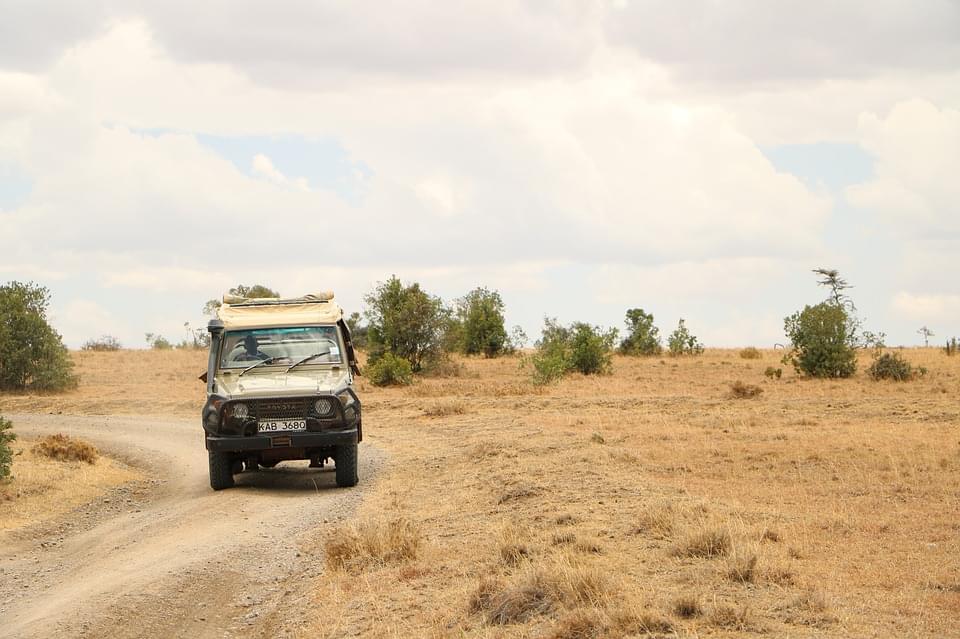
- caldo e umido lungo la costa (medie di 26/27°C), la stagione delle lunghe piogge è da aprile a giugno, mentre agosto/settembre mesi migliori; la temperatura del mare è sui 27/28°C tutto l'anno;
- temperato nelle zone in cui si trovano parchi e altipiani (medie 24/25°C), la stagione delle piogge è tra marzo e maggio, di conseguenza gennaio/febbraio e da giugno a settembre sono i mesi più favorevoli;
- torrido nella parte settentrionale , con temperature medie sui 27gradi, le piogge sono irregolari e sporadiche (la maggiore probabilità si ha marzo/maggio e ottobre/dicembre). I mesi relativamente più freschi sono luglio ed agosto.
Periodo migliore
- giugno/settembre per migrazione gnu Masai Mara;
- metà agosto/fine ottobre per vedere elefanti e rinoceronti al parco Amboseli;
- luglio/settembre e gennaio/marzo per osservare fenicotteri rosa al Lago Turkana;
- giugno/agosto e gennaio/febbraio per le zone costiere e spiagge.
Periodo da evitare
- marzo/maggio sugli altipiani e parchi nazionali, in misura minore ottobre/dicembre poiché stagioni di piogge;
- aprile/giugno è il periodo più piovoso sulle zone costiere;
- per la zona settentrionale non ci sono dei veri e propri periodi sfavorevoli, il clima è sempre torrido.
Migliori Safari
1 - masai mara.
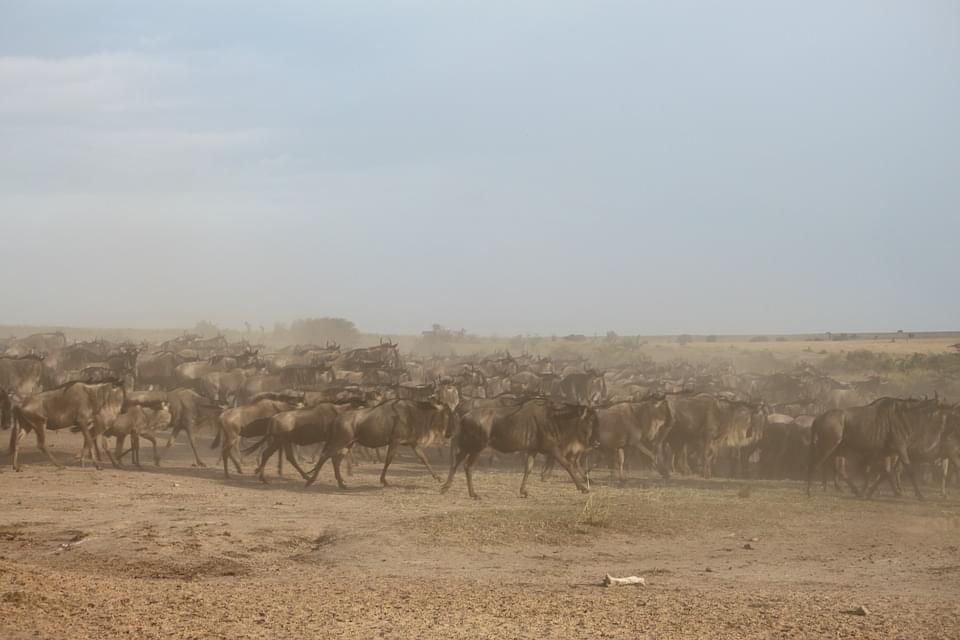
- Periodo migliore da giugno a settembre
- Durata consigliata almeno 3 giorni e 2 notti
- Prezzo medio a partire da €800,00
- Safari consigliato Masai Mara: safari di 3 giorni da €590,00
2 - Amboseli
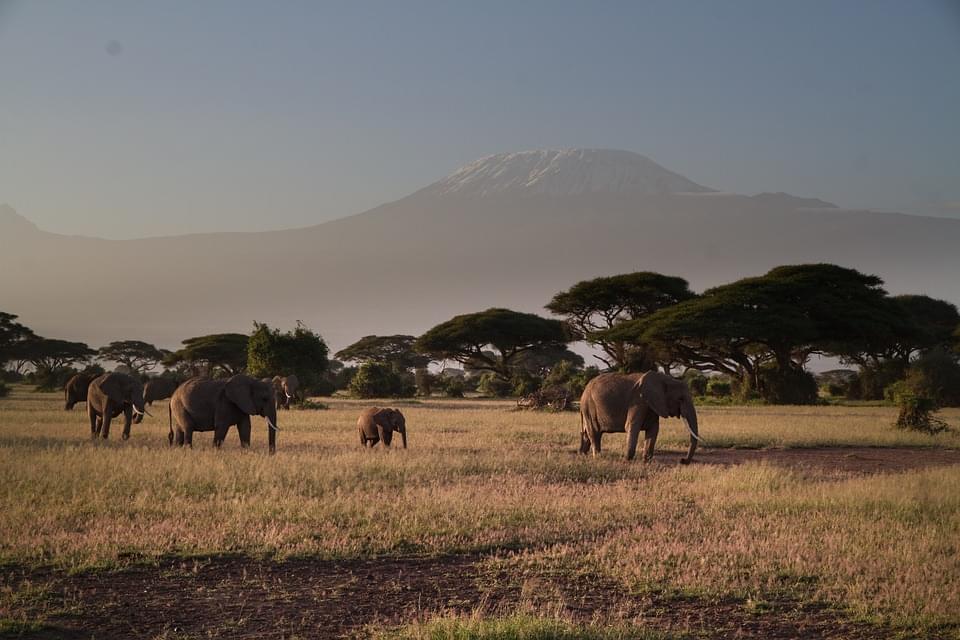
- Periodo migliore luglio/settembre, gennaio/marzo
- Durata consigliata 2 giorni e 1 notte
- Prezzo medio a partire da €300,00
- Safari consigliato Safari di 2 giorni al Parco Amboseli da €350,00
3 - Tsavo National Park Est
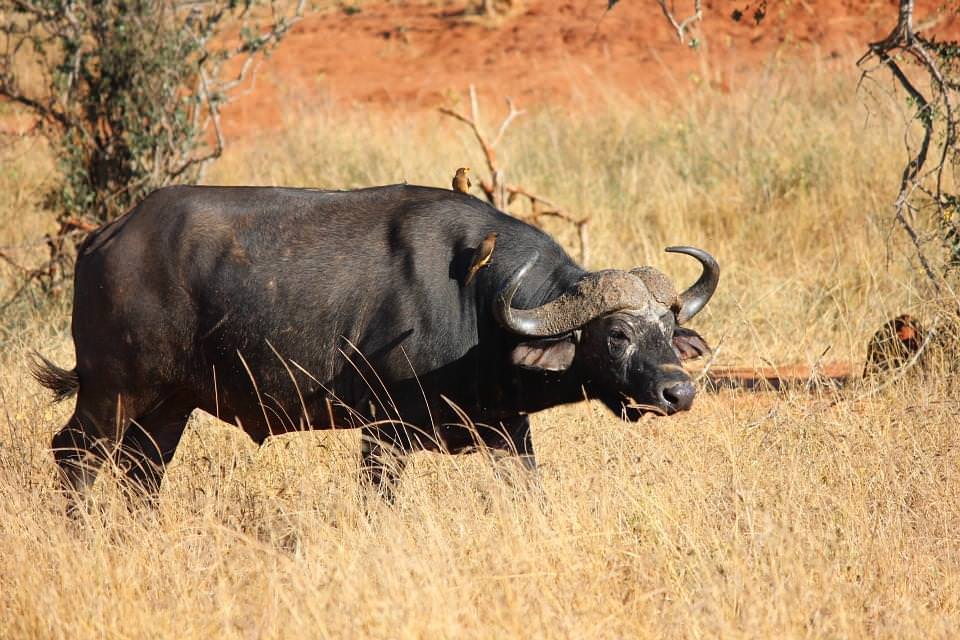
- Periodo migliore da agosto a febbraio
- Durata consigliata 1 notte e 2 giorni / Park Est + Ovest consiglio 2 notti e 3 giorni
- Prezzo medio a partire da €200,00 / Tsavo Est + Ovest da €400,00
- Safari consigliato Da Mombasa: Safari di 3 giorni a Tsavo East e Salt Lick da €590,00
4 - Tsavo National Park Ovest
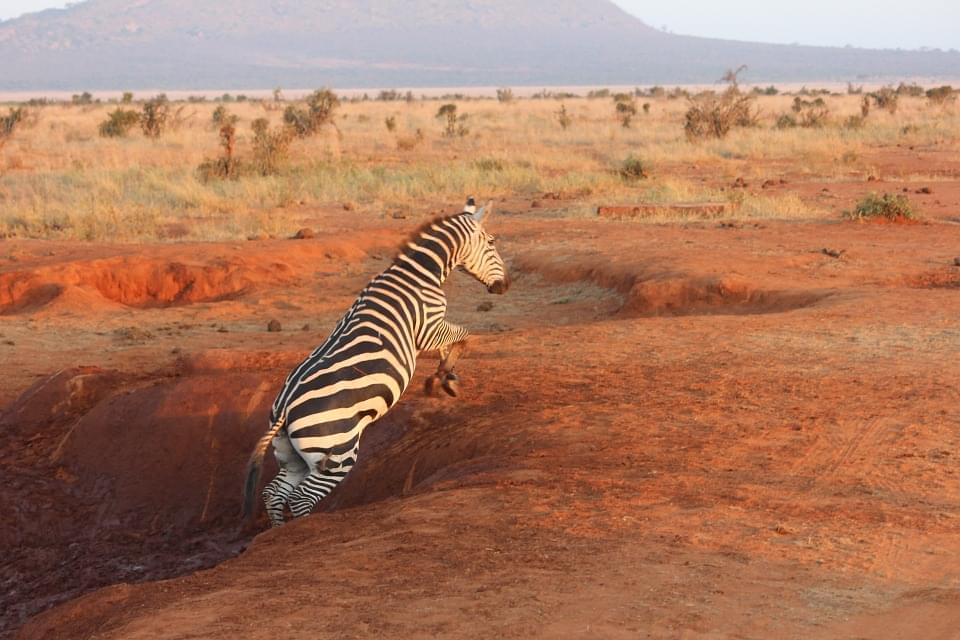
- Periodo migliore da luglio a ottobre
- Safari consigliato Quattro giorni di safari a Amboseli e Tsavo da €690,00
5 - Lago Turkana
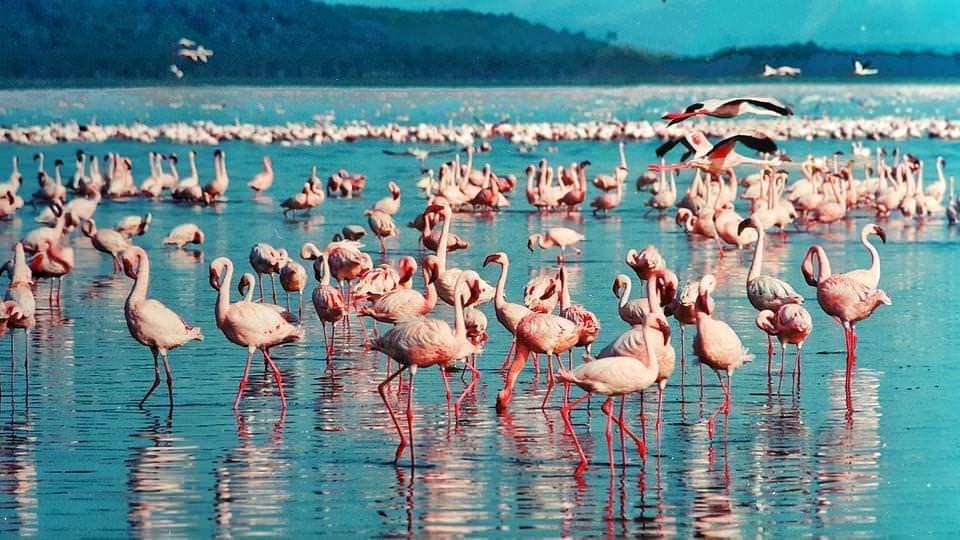
- Periodo migliore luglio/settembre e gennaio/marzo per fenicotteri / Novembre per uccelli migratori
- Durata consigliata 2 notti e 3 giorni
- Prezzo medio a partire da €600,00
Tutto dipende dalla durata, dalla tipologia e da quanti parchi vengono inclusi nel safari. Volendo optare per una soluzione low cost, un safari di una settimana costa circa €700,00 (per la visita di due parchi + un lago). Questo prezzo è da considerarsi per un safari prenotato in loco , escluso quindi qualunque sia il volo dall'Italia che altri tipi di servizi come trasferimenti, pernottamenti e altro. Un viaggio dall'Italia che comprenda volo, safari, pernottamenti e altri servizi inclusi parte da circa €3.000,00 a persona per circa 10-12 giorni - Richiedi un preventivo personalizzato . Soggiornare in una struttura turistica con standard medi costa circa €100,00 al giorno , il costo del cibo è di circa €10,00 a persona a pasto . Nel costo del viaggio bisogna comprendere anche i farmaci per la profilassi contro la malaria, anche se non è obbligatoria: ad esempio il Lariam può essere acquistato a €1,00 a confezione dietro prescrizione medica. Per i voli considerare prezzi di partenza da €400,00 .
La regola è quella di indossare abiti con colori vicini a quelli della natura , come il kaki, il marrone, il verde scuro, il beige. Evitate colori sgargianti perché potrebbero spaventare gli animali . Portate sempre con voi un cappellino per proteggere la testa dal sole, protezione solare, occhiali da sole. Di giorno va bene t-shirt, bermuda, scarpe chiuse; per la sera un k-way e felpa leggera. Se andate sugli altopiani, portate qualcosa di più pesante per il freddo. La sera indossate maniche lunghe e pantaloni lunghi per evitare i morsi di zanzara. In generale, per l'altopiano raccomando vestiti a strati e impermeabile per i possibili rovesci. Per le riserve, vestiti di colore neutro e scarpe comode di tela. Per le montagne indossate scarpe da trekking e, per la cima del Monte Kenya (tutto l'anno), un abbigliamento adeguato per il freddo. Non dimenticate un repellente per le zanzare .
- Abbigliamento consigliato vestiti di colore neutro, leggeri e traspiranti, felpa leggera per la sera, scarpe chiuse
- Accessori utili berretto, occhiali da sole, ombrello, repellente, crema solare, binocolo
Per poter entrare in Kenya regolarmente è necessario possedere il passaporto con validità di almeno sei mesi ed il visto d'ingresso della durata di tre mesi (può essere richiesto online ad un costo di circa €80,00). Appena passati i controlli, sul vostro passaporto verrà apposto il classico timbro, che indicherà anche il periodo in cui rimarrete nel Paese: controllate con attenzione che la data sia esatta! Per ottenere il visto effettivo all'arrivo è sufficiente il biglietto d'imbarco, mentre potete richiedere e pagare il visto d'ingresso già in Italia, presso l'Ambasciata del Kenya a Roma oppure in aeroporto. Per recarsi in Kenya non è obbligatorio effettuare nessuna vaccinazione , anche se viene consigliata la profilassi antimalarica . Portatevi i classici farmaci come analgesici o antipiretici, antidiarroici, antistaminici e sali reidratanti, un abbigliamento leggero e non aderente al corpo ma anche pesante se vi recate sugli altipiani. Attenzione alle zanzare : dotatevi di prodotti contro le punture di questi insetti e dei capi di abbigliamento che coprono la pelle da utilizzare di notte.
- Abitanti 48,46 milioni
- Capitale Nairobi
- Lingue swahili e inglese
- Moneta locale Scellino keniota (Ksh o Kes) / Cambio: €1,00 = 118,14 Kes (1 Kes = €0,0085)
- Distanza dall'Italia circa 10.000 km da Milano (10-11 ore di volo)
Assicurazione di viaggio: il nostro consiglio

Compila il form, un agente locale di Evaneos ti contatterà per darti informazioni sul preventivo e per pianificare il viaggio secondo le tue preferenze
Accetto termini e condizioni e l'informativa sulla privacy i
Ok, potete inviarmi aggiornamenti e comunicazioni

Hai dei suggerimenti?
Orari, prezzi e altre informazioni cambiano spesso, grazie ai tuoi feedback puoi aiutare migliaia di viaggiatori come te.
Kenya safari prices & cost factors
Renowned as a luxury safari destination, Kenya offers prime game viewing with the incredible Great Wildebeest Migration of millions of wildebeest, stunning scenery and beautiful beaches, reflected in the excellent safari experience visitors have come to expect.
Correspondingly, Kenya safari prices tend to be higher compared to other African nations. Visitors often wonder about the approximate cost of a Masai Mara safari and Amboseli National Park safaris and whether affordable Kenya safari packages are possible.
Below, we have listed the various elements that impact Kenya safari costs and detailed the price averages for each.
Table of Contents
Elements that influence Kenya safari tours price
The flight to kenya.
Kenya is well connected with international flights from Europe, Asia and North America however flight distances are typically long to the capital Nairobi, thus adding to the overall cost. Most international flights arrive into Kenya via Jomo Kenyatta International Airport (NBO) for visitors wondering how to get to Kenya .
Tourists will typically have to obtain a Kenya visa including citizens of the U.S, U.K, EU, India and Canada. For safaris, safari lodges and Kenya beach holidays, visitors can travel to Kenya by flying into Nairobi (NBO), Mombasa (MBA), Kisumu (KIS) and Eldoret (EDL).
Due to the length of travel, flights to Kenya can be expensive. The prices of flights from the U.K. or U.S. can vary according to the dates of the stay and the chosen airline.
Several transport options are available in Kenya but not all offer the same experience and speed of connection visitors want when travelling between parks and reserves.
Intercontinental flights
Arriving into Kenya will typically involve taking a connecting flight from Johannesburg in South Africa, Harare in Zimbabwe, Cairo in Egypt, Entebbe in Uganda, Accra in Ghana and more international connections via Dubai-UAE, London-UK with British Airways, Amsterdam-Netherlands and Mumbai-India.
Local transport
Due to this, private charter flights are commonly used to quickly access isolated private reserves and concessions, sometimes the only way to access them.
Others choose to go on self drive safaris and rent their own cars/4×4’s and use the roads of the national parks. This is a more affordable option and offers visitors the comfort of staying as long as they wish in each location.
Accommodation
The quality of accommodation options available in Kenya is generally quite high. There are many luxurious lodges available, some of which can only be accessed by plane transfer however, thus adding to the costs.
More budget friendly accommodation options include camping options, of which many parks have at least 1-2 designated areas.
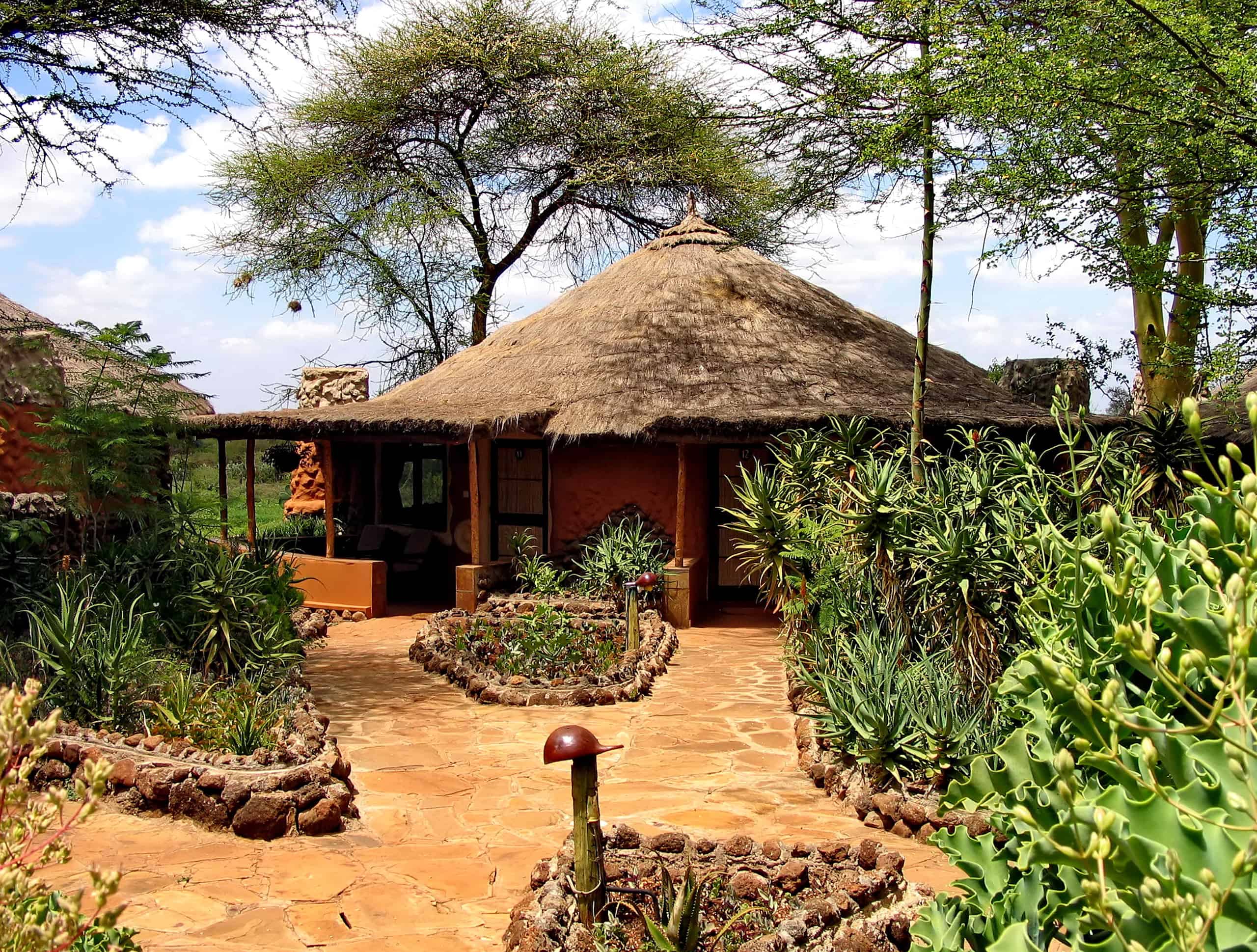
Food/Dining
Supermarket food prices are similar to those in Europe however there are fewer restaurants in Kenya other than those run by lodges and meal prices at these lodges are relatively expensive.
Parks and reserves
National parks and reserves charge park fees per person including entrance fees for guides, as well as vehicle entry fees.
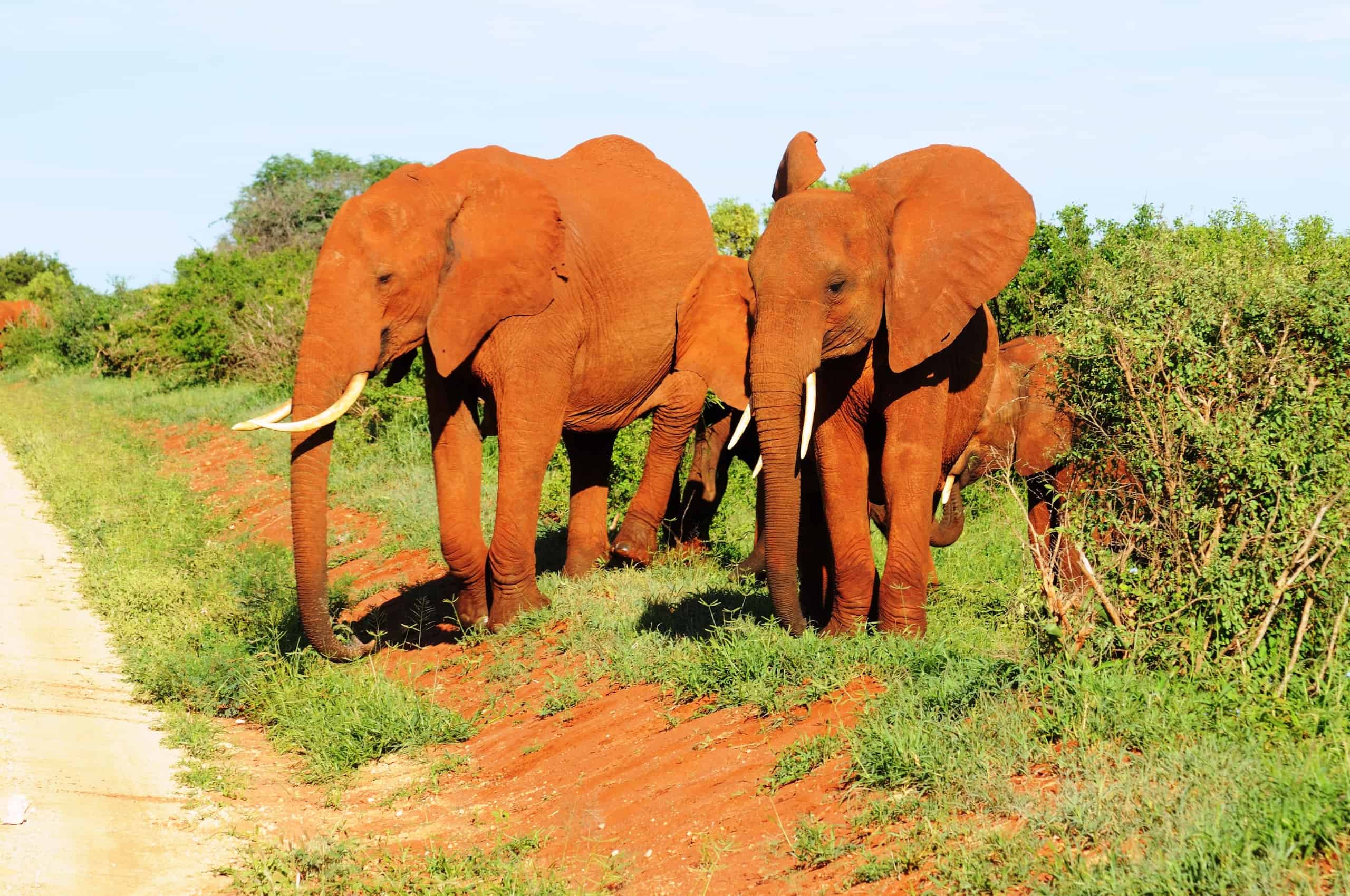
Best activities in Kenya
Many visitors will also be interested in other activities beyond the main safari and wildlife excursions including walking safaris, mountain biking or quad biking adventures, all of which add to overall costs. Comparable to Europe, the price of things to do in Kenya are lower.
A one-hour chartered scenic flight over Mount Kenya can be purchased from $490 per person.
Guests will enjoy incredible views of the peaks of Batian, Nelion and Point Lenana and lunch at Lake Michelson.
Travel Insurance
Safari trips can result in unfortunate events happening, like contracting an illness from contaminated water or falling ill from a mosquito bite.
Visitors may need medical attention while abroad so it’s important to ensure an adequate travel insurance policy is in place which will cover you in the event of an accident or injury.
Visitors should check to see if they have already through their credit card company and workplace benefits. If not, it is recommended to ensure travel insurance is purchased prior to travel to cover:
- Medical expenses and hospital benefit
- Personal accident and liability
- Cancelling and cutting short your holiday
- Covid-19 specific cover
- Abandoning your trip
- Delayed departures
- Accommodation cover
- Personal belongings and baggage
- Personal money, passport and travel documents
- Legal expenses
Vaccinations
This is another expense which may need to be taken into consideration prior to the safari trip, especially if visitors are planning to visit Mombasa, an area with an increased risk of malaria.
Visitors are recommended to consult with their local doctor before arrival and consider antimalarial prophylaxis as recommended. Visitors can find further information on Kenya vaccine details here .
Other expenses
Gasoline, tips, souvenirs can also impact a visitors budget.
Budgeting for a trip to Kenya
Transportation.
For a flight to Kenya from the U.K, it will cost around £800/$1,060 per person, and more from the U.S. Prices can change and are certain to increase during the summer months.
If on a budget, visitors can save two thirds of their daily expenses on transport costs by opting for a car/4×4 rental compared to plane transfers.
Car rental costs start from £90/$115 for a package with basic insurance. Prices increase if visitors book a 4×4 safari vehicle or campervan.
Guests staying at lodges should note the lodges will likely pick up guests and drive them to the lodge, with prices often included in the accommodation.
Accommodation and food
This will vary significantly depending on the type of accommodation selected. Guests can budget £15/$20 a night and upwards for one night camping and can purchase groceries at local supermarkets.
For lodges, nightly rates will cost several hundred dollars, typically with meals included.
Park entrance fees
Comparably, Kenya does charge high prices for visiting its national parks. Average costs can expect to be around £36/$50 to visit many of Kenya’s national parks.
Maasai Mara charges USD $80 per person entry fee per day (24 hrs). Visitors staying at a safari camp or lodge within national reserve boundaries pay USD $70 per person (per 24 hours).
Access to private reserves and concessions is restricted to travelers staying at the lodge with prices typically already included in the concession entry and game viewing drives.
Is a cheap Kenya safari possible?
Safari prices in Kenya are more expensive in general, especially for accommodation. However, visitors can be smart and take measures to keep their bank balance in check including:
- DIY organize your own safari
- Sleeping in a campervan/van with a rooftop tent
- Drive yourself around the country
- Prepare your meals and limit eating out at restaurants
- Limit your activities other than the main safari excursions
Travel seasons
Visitors looking to avail of a cheap Kenya safari on a lower budget should travel in the low season which is January to March. Low season travellers save up to 15% on vacation costs.
Travelling in March to Kenya’s top destinations like Maasai Mara , Diani and Samburu means lower accommodation costs, uncrowded swimming pools and a chef hovering around your table to serve you the best food that there is in the kitchen.
Affordable lodging options
If budget is the primary concern, and visitors don’t mind camping, then there are some overland camping trips (called mobile safaris) available as well as budget Kenya safari packages.
Excluding international flights and plane transfers:
- Visitors planning a 6 night safari staying at two different tented camps can expect to pay around $3,600 – $4,300 per person
- Visitors planning a similar 6 night mobile camping safari can expect to pay around $2,200 per person, prices can vary
Affordable Kenya safari packages tend to be for longer safaris (7+ nights) whilst higher cost safaris are typical of a shorter 3 or 4 night safari.
Summary: The average price of a safari in Kenya
Estimating the cost of an average safari isn’t straight forward, given the range of factors noted above that can impact prices. However, two examples are provided below to give visitors an idea of average costs to expect.
Affordable Kenya safari prices
The cost of an affordable safari in Kenya includes:
- International flights
- 4 × 4 rental with a tent on the roof
- Campsite accommodation
- Parks entry for game drives
Based on the above, we can estimate prices of at least £340/$450 per person based upon a 10 day stay.
Luxury Kenya safari prices:
The cost of a luxury safari in Kenya includes
- International flights and transfers
- Transfers by plane and/or private drive
- Lodge accommodation
- Guided game drives
Based on the above, we can estimate costs of at least £940/$1240 per person based upon a 10 day stay.
This trip includes visiting the Maasai Mara National Reserve and Tsavo East National Park, during peak season. Prices are indicative only and may vary depending on travel conditions.
The following is a pricing summary of the main costs a safari visitor in Kenya can expect:
How much does a safari cost in Kenya?
Kenya is one of the more expensive African countries to go on safari, however it is possible to go on a safari budget friendly trip to Kenya. Average prices are difficult to calculate given the various elements of the trip to take into account.
Are credit cards and debit cards accepted in Kenya?
You won’t necessarily be able to use your card everywhere you go in Kenya. In large cities and tourist areas, credit and debit cards are likely to be accepted. Visa is the most commonly accepted, with Mastercard/Maestro/Cirrus and Amex also.
When to go on a safari in Kenya?
Overall, June to October is the best time to visit Kenya during the dry season for a safari trip to any of the national parks.
Kenya Safari Tours and Holiday Packages
Find and book your dream safari in magical Kenya. There are 851 Kenya safari adventures to choose from, that range in length from 1 days up to 21 days. The most popular month for these tours is October.
Best Kenya safari tours based on 1,331 reviews

- Christmas & New Year
7 Days 6 Nights Kenya luxury Safari
It was a trip our family will never forget. Your dedication, knowledge and excellent attitudes truly made the difference… When I asked our kids what they liked the most, their top answer was ‘the friendship we made with Simon and Isaac ’. Thank you for sharing so much with us! ~Jonas, NJ.
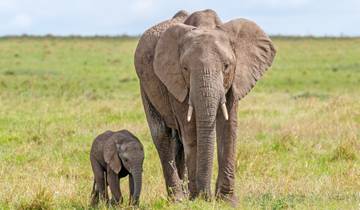
Kenya Wildlife Safari
Phoebe here... My experience together with my guy Jean was awesome.. No words can describe that feeling ..
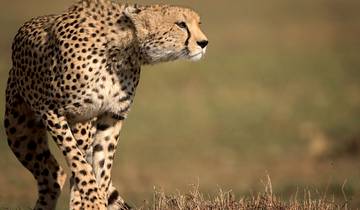
Kenya Camping Safari
It was more than what I expected. Every thing was well organised. The guide/tour leader is a important part of tour and I found the guide/ tour leader of both my trip with g adventure was good.

Premium Kenya

6 Days Kenya Budget Tours (with FREE NIGHT at Nairobi Hotel)
What an amazing 6 Days Kenya Budget Tours we had with Bon Voyage Kenya safaris. Well organized safari from start to the end. I enjoyed every minute of it. The fellow passengers in the 6-day joining safari were all wonderful, we made some wonderful friendships along the way. Faith was amazing in answering all our questions.
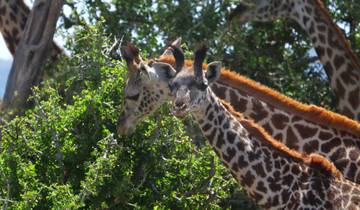
Kenya Family Safari
Your staff did an excellent job. We had a great time and I would recommend this trip for my friends.

Masai Mara Camping Safari
Our guide was great and interacted well with the group. He had lots of animal knowledge and found us some great animals. Our transport was a van but it made it there and back and wasn't too bad for game viewing. Plenty of space for the 6 of us. Accommodation is a basic tent with bed and mossie net but was all we really needed. Meals were good and there was always plenty. While the trip is advertised as 4 days, it's only 3. I would have enjoyed having an extra day to spend in the Mara.
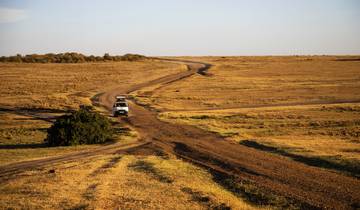
Kenya Safari Experience National Geographic Journeys
It is Tim and I first time at a safari and we had a fantastic experience because Lilian and Vincent the driver from G-adventure was knowledgeable in their work. We very much enjoy it and is looking forward for the next trip. Thanks.

5 Days Masai Mara and Amboseli Wildlife Safari
Our 5 day Kenya Masai Mara safari was fantastic. Everything was very good. Martin our driver guide, extremely hard-working, knowledgeable and helpful. From airport reception to on time performance all very good. Good company I can recommend.
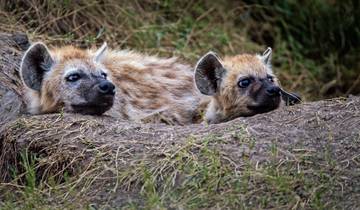
7 Days Taylor -Made Kenya Luxury Safari
This is one of the best tours ever just loved the experience
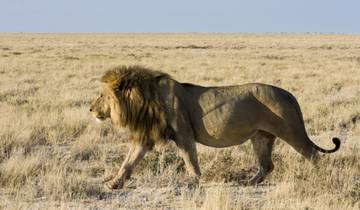
5 Days Kenya medium range safari for Amboseli and Tsavo Parks from Nairobi to Mombasa
I would highly recommend CKC Tours. John responded to all our queries promptly and went back and forth until we had an itinerary we were happy with. We were then met by John at the airport and given all the documentation for our trip which included lodges at Masai Mara and Amboseli and internal flights. It was all very easy and well organised. I also found it to be very competitively priced considering the service we received and the standard of accommodation.
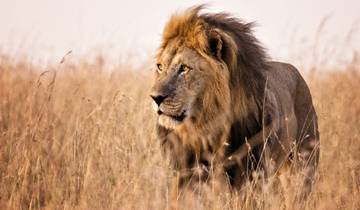
7 Days Kenya mid range Joining Safari
The communication with John was very good. He was very responsive and answered all of our questions. At first we were slightly hesitant to do a down payment but this is just how safari operators work and in the end was nothing to worry about, it all went fine. The safari was great! The 4x4 van was very comfortable and steady and brought us to the most remote places of the parks. Kennedy, our driver, was awesome and has a lot of knowledge on the animals, the country and is an amazingly skilled driver. He made our safari just as we wanted it and was as thrilled to see animals as we were. We saw all of the Big Five and managed to get very close to them. Thank you so much Kennedy and John!
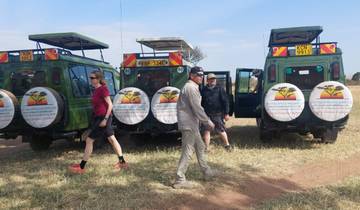
6 Days Kenya Budget Small Group 4x4 Jeep Safari
This safari was most excellent! Our driver/guide, Zack, was absolutely phenomenal! He was a wealth of knowledge about all the different wildlife, made every effort to ensure that we saw as much as we could and provided plenty of photo opportunities. I didn’t think it could get any better than the first day, but I was wrong! Overall, we saw 70+ species of wildlife in their natural habitat, to include a cheetah and 4 cubs! I truly enjoyed this unforgettable experience (including the food and culture)! Also, Albert was great at setting everything up, handled pre-safari hotel reservations, scheduled airport pickup and was very prompt with communication. If you’re looking for a safari adventure, I highly recommend Exciting Africa Holidays!
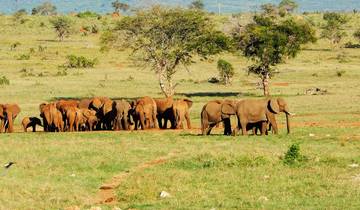
6 Day Kenya Cultural Safari
After seeing the Best Ever Food Tour visit at the Maasai Mara village in Amboseli, I was inspired to go! I contacted Emmanuel and he was instantly a wealth of knowledge. We communicated often about my trip so much that by the time we met, I felt as if I were amongst friends. Along with Emmanuel was Carlos Roy, our driver. Carlos and Emmanuel were incredibly knowledgeable about the Maasai people, the area and could answer all of my questions. Carlos is by far the best driver. He is considerate and has a great sense of humor. You definitely won't be bored as he introduces you to the "African massage"! On the tour, Emmanuel was able to translate my questions, arrange a time for me to personally interview the elder and much more! This tour was hands down one of my favorite experiences during my entire trip. I've been to another Maasai village and this by far was the most authentic. I felt as if I was truly able to experience the culture as well as gain an appreciation for their desire to keep up with today's technology while preserving their traditions and norms. I'm so glad I did this tour with Emmanuel and Carolos. I am a travel advisor and my goal is to send my clients seeking an authentic experience to tour with Emmanuel and Carlos in the future. My one piece of advice would be not to wait, book today because this is a really popular tour!!!

- Great Migration
3 Days Masai Mara Safari (in a 4x4 JEEP with FREE NIGHT at Nairobi Hotel)
Our 10-day group joining safaris to Kenya and Tanzania gave us a great experience of a number of national parks. The tour consultant Mr. John and the driver were great. Some days involved a bit of driving but that was expected. We also made new friends and the most amazing memories. Would definitely recommend this joining safari tour to any age group.
Kenya Safari Tour Reviews
I enjoyed the tour The good was good and the guide was sharp
Everything was Amazing
My first time camping and I had a blast! David was a fantastic CEO: helpful, patient, informative and good natured. The people, places and animals I’ve seen will stay will me for a long time.
Safari Tours
- Wildlife (258)
- Big Five (106)
- Great Migration (52)
- Flying Safari (14)
National Park
- Masai Mara National Reserve (127)
- Lake Nakuru National Park (81)
- Amboseli National Park (54)
- Amboseli National Park (33)
- Tsavo National Park (29)
- Samburu National Park (11)
- Lake Nakuru National Park (7)
Regions in Kenya
- Masai Mara National Reserve (137)
- Masai Mara (120)
- Lake Nakuru National Park (83)
- Amboseli National Park (55)
- Amboseli National Park (35)
- Mount Kenya (22)
- Central Kenya (17)
- Lake Nakuru National Park (9)
Travel Styles
- 10 Best Safaris in December 2024/2025
- 10 Best Safaris in August 2024/2025
- 10 Best Safaris in January 2024/2025
- 10 Best Safaris in November 2024/2025
- 10 Best Safaris in October 2024/2025
- 10 Best Safaris in September 2024/2025
- 10 Best Safaris in July 2024/2025
- 10 Best Safaris in June 2024/2025
- 10 Best Safaris in May 2024/2025
- 10 Best Safaris in April 2024/2025
- 10 Best Safaris in March 2024/2025
- 10 Best Safaris in February 2024/2025
- 10 Best Luxury African Safari Tours 2024/2025
- Kenya Travel Guide | All You Need to Know
- Best Time to Visit Kenya for a Ultimate Safari Experience
International Versions
- Deutsch: Kenia Safaris
- Français: Kenya Safaris 2024/2025
- Español: Safaris en Kenia
- Nederlands: Safari Rondreizen in Kenia

- Kenya safaris
Kenya safari guide – where & when to go, and what to see
Kenya safaris rock! Kenya is one of East Africa’s premier safari destinations, with massive open savannah regions hosting a huge breadth and depth of African wildlife. Over 10% of the country is protected in some form or other, and national parks in Kenya rate as some of the best in the world. A safari in Kenya almost guarantees you a sighting of the big five African animals of lion , buffalo , elephant , rhino , and leopard . Alongside these big-hitters are hundreds of other species of African animals, and some of the world’s most diverse bird-life.
Straddling the equator, Kenya is dominated by the Rift Valley – a huge range of valleys strung along a 5,000 km crack in the earth’s crust that runs through East Africa. Within the Rift Valley are Africa’s highest peaks – in Kenya these are the volcanoes of Mount Kenya and Mount Elgon. East of the Rift Valley are the coastal plains, whilst the north of Kenya is made up of arid wastelands. The prime Kenya safari destinations are the Central Highlands and areas within the Rift Valley. The south of the country hosts the great migration of plains animals and their predators each year between June and November. In short, Kenya safaris are up there with the very best in terms of wildlife and scenery.
Self-drive safaris are an option in many national parks in Kenya, though to enjoy full access to the most remote (and tourist-free) areas you’ll need a 4WD car or jeep. If you fancy taking a tour or arranging your own guide and/or driver have a look at our list of safari tour companies in Kenya before arrival in the country.
Alongside safaris and wildlife spotting, a visit to Kenya allows you to easily extend your safari with a visit to a resort on the Indian Ocean coast, or with activities such as trekking, hiking, sailing or diving .
Useful resources
- Book a Kenya Safari
- Kenyan Ministry of Tourism
- Kenya Wildlife Service
Kenya safari highlights
Experience maasai culture.
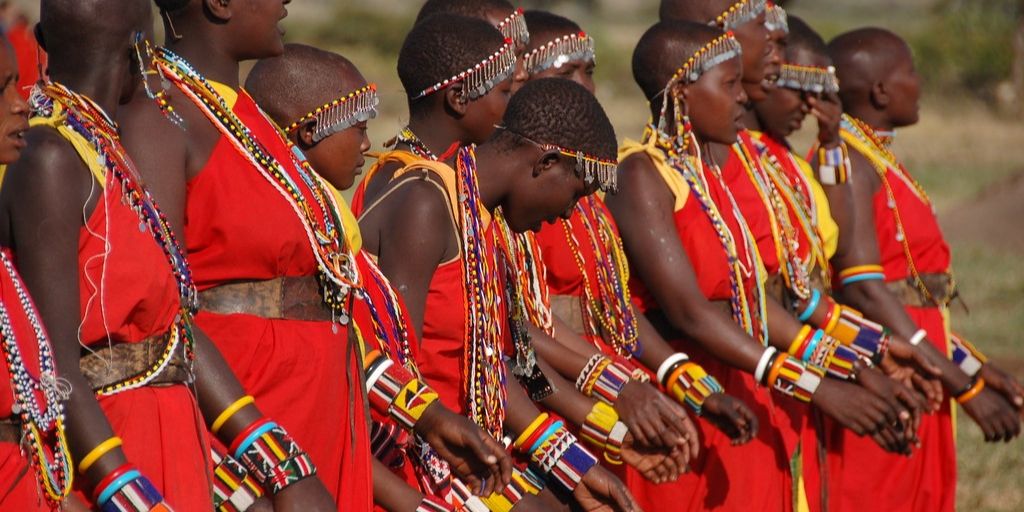
The Maasai are one of the few African tribes who have retained most of their traditions, lifestyle, and lore – along with their distinctive red robes. Many safari lodges and operators work with local Maasai on community projects. Experiencing some time in a Maasai village whilst in Kenya is a unique cultural experience that will help put your visit in context.
Big five spotting

Big five spotting in Kenya is high on most visitor’s safari checklist, and with Kenya’s superb network of national park gems seeing Africa’s biggest beasts up close and personal is a realistic goal. Destinations rich in lion, leopard, elephant, rhino, and buffalo are clustered in the south of the country, particularly Amboseli, Masai Mara and East and West Tsavo (for the Tsavo lions !) national parks.
Watch the ‘Great Wildebeest Migration’

Indian ocean beach perfection

Best time to safari in Kenya
The peak tourist season in Kenya is January and February when the weather is consistently warm and dry, with wildlife easy to spot in large concentrations. If you take a Kenya safari in peak season expect to be in company with crowds of tourists, and paying top dollar for your safari. If you’re specifically after catching sight of the annual great migration, June to October is the time to head to the Masai Mara National Park in southern Kenya.
The long rains hit Kenya through March, April and May, and the short rains from October to December. During the short rains, it generally rains only for short periods at a time, meaning your wildlife viewing will not be too disrupted. This is the time you can get some great deals on safari tours, or safari lodges if you’re travelling independently.
Flights To Kenya
Search, track and book flights to Kenya, from anywhere in the world.
Kenya Accommodation
Find safari accommodation in Kenya – from budget campsites to luxury lodges.
Kenya Car Hire
Considering a self-drive safari? Research and book car hire in Kenya.
Activities in Kenya
Search and book things to do in Kenya – tours, excursions and activities.
National parks in Kenya
With a stunning array of wildlife and more than 10% of the country given over to national parks and reserves, Kenya is undoubtedly one of the world’s best safari destinations. Whilst the world-famous Kenyan national parks such as Masai Mara and Amboseli National Parks can be uncomfortably heaving with tourists in January and February, Kenya has plenty of smaller, out of the way national parks that see only a trickle of visitors year-round. As such it’s well worth taking the time to consider whereabouts in Kenya to go on safari if you’re visiting during peak season.
Top Kenya national park picks
Masai mara national reserve.
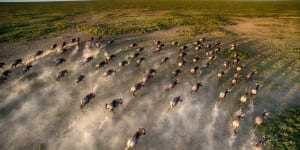
Situated in southwest Kenya, the Masai Mara is part of the northern section of the Serengeti National Park, and is generally recognised as one of the greatest wildlife reserves in Africa. The reserve is famous for the abundance of predators – particularly big cats – and the great wildebeest migration to feed these predators, as well as the Maasai people themselves.
- Lake Nakuru National Park
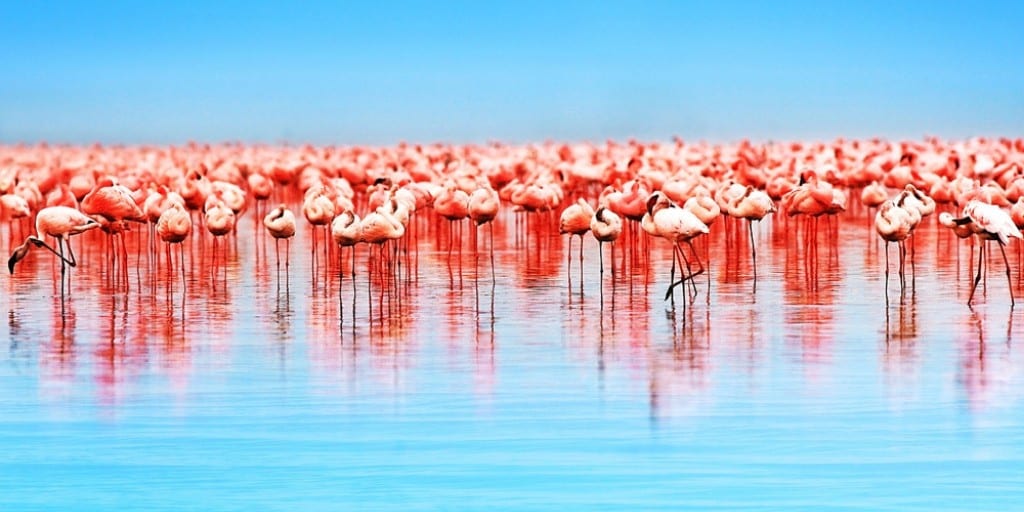
The stunning Lake Nakuru National Park is on the floor of the Great Rift Valley, surrounded by bushy grasslands and woods. There are 56 species of mammal in the park, but the star show are the thousands of flamingos, arriving in their millions some years.
- Amboseli National Park

Crowned by Africa’s highest peak, Mount Kilimanjaro, Amboseli is one of Kenya’s most popular parks . The name ‘Amboseli’ comes from the Maasai language and means ‘salty dust’… perfect for the large herds of elephants that roam the park.
- Meru National Park
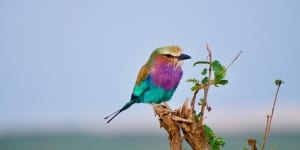
Meru National Park is a Kenyan park is located 350 km from Nairobi, featuring multiple landscapes including grasslands, swamp, jungle and rivers. It’s a birders paradise with over 427 recorded bird species, in addition to the big five .
All national parks in Kenya
Use the map below to locate all national parks in Kenya. Click the icons for more info.
Get Directions
- Aberdare National Park
- Arabuk Sokoke National Park
- Hell’s Gate National Park
- Kakamega National Park
- Lake Bogaria National Park
- Malindi Watumu National Park
- Masai Mara National Park
- Mount Elgon National Park
- Mount Kenya National Park
- Nairobi National Park
- Saiwa Swamp National Park
- Shimba Hills National Park
- Tsavo National Park
Kenya safari resources
Kenya safari companies.

There are plenty of companies offering safari tours around Kenya. The focus is on the high end, but there are some companies that specialize in mid and budget safaris. Check out our reviews of safari tour companies in Kenya .
Kenya safari lodges
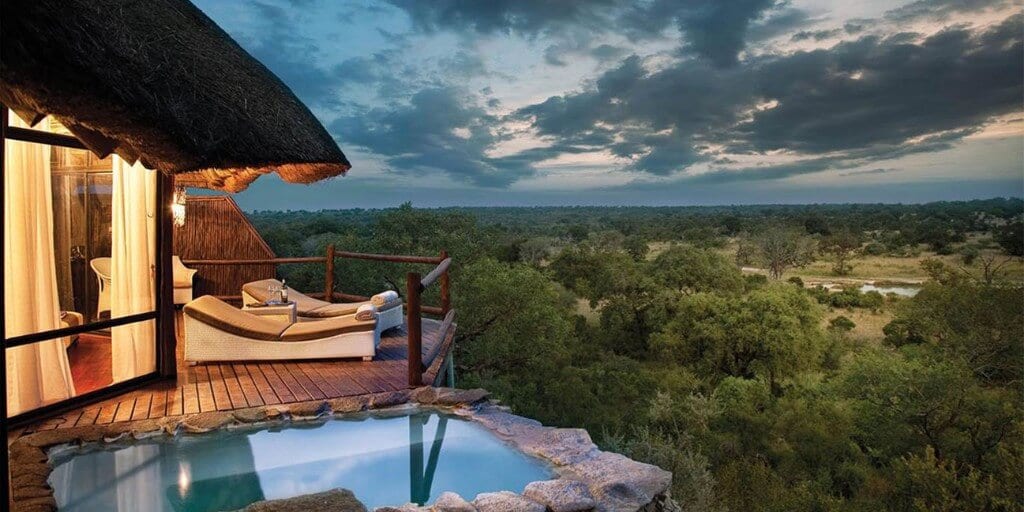
As a tourism-focussed country, Kenya has plenty of choice when it comes to safari accommodation. Lodge standards vary from rustic to modern, from the simple room to extreme luxury with en-suite private plunge pool. Search and book accommodation in Kenya .
For a trip to Kenya, travellers are required to apply for a visa. The easiest, most commonly used visa for going on a safari in Kenya, is the Kenya e-visa . It is valid for 90 days, and can even be extended once to 180 days once you arrive in Kenya. The visa can easily be applied for online and will save you the hassle of having to apply at an embassy or consulate.
Read safari guides to all countries
Botswana safaris , Namibia safaris , Rwanda safaris , South Africa safaris , Tanzania safaris , Uganda safaris , Zimbabwe safaris
Do you have any experience of planning or going on safari in Kenya?
We’d love to hear any feedback or tips you may have – please get in touch , or add to the comments below.
Top countries for safaris
- Botswana safaris
- Namibia safaris
- South Africa safaris
- Tanzania safaris
- Uganda safaris
Safari basics
- Safari animals
- How to find the right safari company
- When to go on safari
- What to take on safari
- Safari clothing – what to wear
- Safari rules & etiquette
- Wildlife spotting tips
Most read articles
- All about the ‘big five’ animals
- Collective nouns for animals
- Safari movies to watch before you go
- The world’s fastest land animals
- Apex predators
- 10 Fascinating African tribes
- The biggest animals in the world
- 17 Epic hybrid animals
- The world’s ugliest animals
- Why are flamingos pink?
Africa’s best game reserves
- Chobe National Park, Botswana
- Etosha National Park, Namibia
- Kruger National Park, South Africa
- Masai Mara National Reserve, Kenya
- Moremi Game Reserve, Botswana
- Okavango Delta, Botswana
- Serengeti National Park, Tanzania
Session expired
Please log in again. The login page will open in a new tab. After logging in you can close it and return to this page.
- Travel Planning Guide
The Best Safaris in Kenya
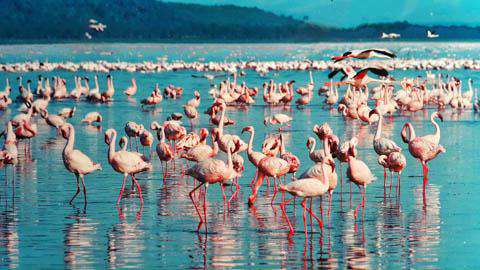
Seeking an extraordinary safari experience? We've meticulously examined various safari tours in Kenya from highly-rated companies, taking into account important criteria such as price, guest ratings, service, destinations, and activities. The result? A handpicked selection of the finest safaris in Kenya that will immerse you in nature's wonders and create cherished memories. So, pick out one of the safaris below for an epic journey into the wilderness, as we're confident it will be fantastic.
- 11 Days Gorillas & The Great Migration and Big Five 11 Days, $6403.00
- Eight Day Kenya and Tanzania Round Trip Budget Safari 8 Days, $3800.00
- Classic Luxury Masai Mara Migration with Mara Engai 4 Days, $1580.00
What are safaris like in Kenya?
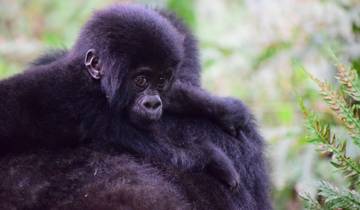
Here are the important factors:
- 198 trip options analyzed
- $402 average price per day (USD)
- 1 to 28 days in length
- 4.74 of 5 average rating
- 20 people or less on average
Curious about the diverse range of safaris? Prepare to be amazed by the array of options available to suit every traveler's preferences. It comes as no surprise that visitors adore these tours, given their exceptional average guest rating of 4.74 out of 5 stars. When it comes to group sizes, the average maximum capacity stands at 20 people, allowing for a comfortable and sociable experience. The shortest tour is 1 days, while the longest is 28 days. Looking at physical activity , the tours are easy, relaxing, moderate, and serious, with the most as easy. Regarding travel styles , the tours are categorized as family and honeymoon, with the majority being family. With a comprehensive analysis encompassing 198 safaris, you can rest assured that Kenya has something tailored to your interests and preferences, promising an unforgettable experience for all.
(All tour prices are in US Dollars before taxes, and come from a base price that is reported by TourRadar. Peak season prices can vary significantly, particularly in destinations where seasonal travel fluctuates dramatically.)
So, let's get to it and see...
The 10 Best Safaris in Kenya
11 days gorillas & the great migration and big five.
- High Quality: guest ratings are higher than average.
Set off on an extraordinary journey, visiting Tanzania, Kenya, and Uganda, that has been awarded a 4.8 out of 5 stars by previous guests. This terrific trip also highights wildlife and safaris. With a duration of 11 days, this safari adventure offers an intimate group setting, accommodating 80 individuals, while extending a warm welcome to travelers aged 15 to 75 years old. With 7 destinations to explore, you'll get the chance to see Maasai Mara National Reserve, Entebbe, Kibale Forest National Park, and Bwindi Impenetrable National Park, and more. Beginning in beautiful Arusha, you'll have a terrific journey that ends in Entebbe. Brought to you by GoExplore Safaris , this exceptional deal is an incredible steal at a mere $582 per day.
- Gorilla Trekking
- Great Migration
Eight Day Kenya and Tanzania Round Trip Budget Safari
With this option you can experience an unparalleled trip for 8 unforgettable days, visiting Kenya and Tanzania. It ensures an intimate group setting with 6 participants at most. Along the way, this journey encompasses 7 destinations, including Mto Wa Mbu, Lake Manyara, Serengeti National Park, and Amboseli National Park. You'll start and end your journey in beautiful Nairobi. Jeep Safaris and Tours , the organizer of this journey, extends a warm invitation to guests travelers aged 10 to 80 years old. You're in for an epic adventure with a strong emphasis on wildlife, family-friendly activities, and safaris. This extraordinary opportunity offers exceptional value at only $475 per day.
Classic Luxury Masai Mara Migration with Mara Engai
- Great Value: the daily price is lower than average for safaris.
This fantastic trip has a rating of 5 out of 5 stars. Nairobi marks the starting point, while Maasai Mara National Reserve stands as the final stop on your incredible journey. You'll love the emphasis on wildlife, family-friendly activities, and safaris, too. Lasting 4 days, the maximum group size is 100 people, and it's good for travelers aged 2 or older. Organized by Classic Journeys Africa Ltd , this is a great deal because it's only $395 per day.
7 Days, 6 Nights Safari To Masai Mara, Lake Nakuru, Lake Naivasha And Amboseli Safari With Complimentary First Night Accommodation at After 40 Hotel Nairobi.
With a stellar 5 out of 5 rating, this extraordinary safari is the perfect choice. With an emphasis on wildlife, family-friendly activities, and safaris, you know you'll have an amazing adventure. Immerse yourself in a travel experience that includes 5 destinations, featuring Maasai Mara National Reserve, Lake Nakuru, and Lake Naivasha. You'll start and end this amazing trip in Nairobi. Spanning across 7 days, the safari accommodates 20 individuals, and is suitable for travelers aged 2 to 95 years old. Offered by Perfect Wilderness Tours And Safaris , this remarkable safari is priced at just $231 per day. Don't miss out on this incredible experience.
3 Days Masai Mara Wildlife Safari
This exceptional trip offering by Jeep Safaris and Tours has received a 4.7 out of 5 rating. On this 3-day safari you can unwind while also making new memories. Nairobi will be both the start and end of your journey. With a group size of 6 people, it's suitable for travelers aged 10 to 80 years old. And since the priority is on wildlife, family-friendly activities, and safaris, this tour is a great choice. This remarkable trip is priced at an unbeatable $450 per day.
East Africa Highlights
Check out this journey that has received rave reviews, earning a stellar 4.6 out of 5 rating, visiting Kenya and Tanzania. Traverse through 6 enchanting destinations, with Maasai Mara National Reserve, Lake Victoria, Serengeti National Park, and Karatu among the must-see stops along the route. Nairobi marks the starting point, while Arusha stands as the final stop on your incredible journey. Rest assured, this trip is all about overlanding, wildlife, and safaris, guaranteeing an unforgettable adventure. Spanning across 10 unforgettable days, this voyage offers an intimate group experience with 16 participants, and it's great for travelers aged 15 or older. Brought to you by the renowned Intrepid Travel , this exceptional opportunity is priced at an incredible $276 per day - an unbeatable value.
- Overland Truck
10 Days Kenya and Tanzania Adventure
This 10-day safari, visiting Kenya and Tanzania, is ideal for travelers aged 4 to 85 years old. And priced at only $360 per day, it's a great value, too. This extraordinary adventure also revolves around wildlife, family-friendly activities, and safaris. This trip visits 7 destinations, including Ngorongoro Conservation Area, Serengeti National Park, Maasai Mara National Reserve, and Tarangire National Park along the way. Nairobi will be the beginning and end of your trip. It's offered by Africa Venture Safaris , a very popular company with rave reviews and knowledgeable guides.
12 Days, 11 Nights Best of Kenya And Tanzania Budget Group Camping Safari with complimentary airport pick up and first night at Best Western Plus Hotel Westlands.
Priced at just $220 per day, this terrific 12-day safari, visiting Kenya and Tanzania, is ideal for travelers aged 4 to 90 years old. Experience a trip that takes you to 10 remarkable destinations, including Lake Naivasha, Namanga, Lake Manyara, and Serengeti National Park. Begin and conclude your remarkable journey in the gorgeous destination of Nairobi. Organized by the reputable Perfect Wilderness Tours And Safaris , this is one of the best tours on this list.
Maasai and Migration
Check out this incredible journey that has received a 4.2 out of 5 rating from previous guests, visiting Kenya and Tanzania. You're in for an epic adventure with a strong emphasis on overlanding, wildlife, and safaris. With a duration of 11 days, this journey ensures an intimate group size of 28 people, and is good for travelers aged 18 to 80 years old. Explore 7 incredible locations on this trip, including Dar es Salaam, Arusha, Serengeti National Park, and Ngorongoro Conservation Area. Nairobi marks the starting point, while Zanzibar stands as the final stop on your incredible journey. This fantastic option, organized by Absolute Africa , presents an unbeatable value at just $220 per day.
Kenya: A Classic Safari with Nairobi & Amboseli
Spanning over 12 days, this safari adventure has a maximum size of 30 individuals. Welcoming travelers aged 5 to 80 years old, it is organized by Globus , a very popular company with plenty of great reviews. Discover a journey that spans 8 destinations, with notable stops in Ol Pejeta Conservancy, Nyahururu, Lake Nakuru, and Maasai Mara National Reserve. Nairobi kicks off your expedition, serving as both the starting and finishing point. You'll love the emphasis on wildlife, local culture, family-friendly activities, and safaris, too. Available at an unbeatable price of only $580 per day, this option also has a rating of 5 out of 5 stars from previous guests.
- Jeep & 4WD
- In-depth Cultural
See also The Best Family-Friendly Tours to Kenya , The Best Wildlife Tours to Kenya , The Best Hiking & Trekking Tours in Kenya , The Best 10-Day Tours in Kenya , The Best One Week (7-Day) Tours in Kenya , The Best 3-Day Tours in Kenya , The Best 2-Week Tours in Kenya , Tours for Outdoor and Nature Lovers in Kenya , The Best Christmas & New Years Tours in Kenya , The Best Overlanding Trips in Kenya , The Best Adventure Tours to Kenya , The Best Eco Tours in Kenya , The Best Sightseeing Tours in Kenya , The Best Cultural Tours in Kenya , The Tours for Animal Lovers in Kenya , The Best Camping Tours in Kenya , The Best Romantic Tours for Couples in Kenya , The Best Budget Safaris in Kenya , The Best Tours Under $1000 in Kenya , The Best Luxury Tours to Kenya , The Best Budget Tours to Kenya , The Best Tours for Seniors to Kenya , or The Best G Adventures Tours to Kenya for more tour ideas. With so many options, there's a guided tour or vacation package for every type of traveler.
Also, if you're departing from a specific destination, see The Best 3-Day Tours from Nairobi , The Best 3-Day Tours from Mombasa , The Best 3-Day Tours from Maasai Mara National Reserve , The Best One-Week (7-Day) Tours from Nairobi , The Best 10-Day Tours from Nairobi , or The Best 2-Week Tours from Nairobi for more package tour options.
How much do safaris in Kenya cost?
Travelers to Kenya will have a large number of terrific options for safaris at a variety of great prices. The price of safaris here can vary by type, destinations, length, and travel style. Based on thorough data from 198 safaris, their average daily price is a very reasonable $402 per day. If you're interested in more information about tours here, see our guide to tour prices in Kenya .
And for more information on Kenya, see Kenya Travel Costs and Kenya Hotel Costs .
Subscribe to our Newsletter
By signing up for our email newsletter, you will receive occasional updates from us with sales and discounts from major travel companies , plus tips and advice from experienced budget travelers!
Budget Your Trip

Some of the links on this website are sponsored or affiliate links which help to financially support this site. By clicking the link and making a purchase, we may receive a small commission, but this does not affect the price of your purchase.
- Privacy / Terms of Use
- Activities, Day Trips, Things To Do, and Excursions
- Saso uganda safaris Gorilla trips, rwanda & Uganda Gorilla trekking tours
- +256-775-564060
- enquire now

SASO UGANDA SAFARIS
Gorilla trips, rwanda & uganda gorilla trekking tours, kenya safari cost.

The Kenya Safari Cost approximately costs up to $180 – $250 dollars per day without great services and quality facilities. On your Kenya Safari Tours , this travel cost includes domestic transportation, accommodation, and meals, excluding international flights and tipping expenses. Your travel costs also include park fees, and other related costs necessary to make your safari a success.
What is the Cost of Mid-Luxury Kenya Safari Tours?
The most popular Kenya Safari Tours options are the mid-budget Kenya wildlife safari packages which are considered the best value for money. The Kenya Safari Cost for mid-range Luxury Safaris is approximately $290 – $500 per person per day. In these safari packages, we recommend Kenya Honeymoons Safaris, Kenya Safari Landcruiser, or Kenya Wildlife Safaris that you can plan with your family. The accommodation type on these packages is 4 to 5-star accommodation stays.
What Are The Expenses Of Luxury Kenya Safari Tours?
Another choice to choose from is the Kenya Luxury Safari which you must try once in a lifetime as it offers the royal treatment and excellent premium services that you will never forget. The cost of these packages ranges from anywhere above $600 per person/day and you get to stay at the best luxury suites in Kenya.
What Are Accommodation Costs On Kenya Safari Tours?
The Kenya Safari Cost that includes your accommodation greatly varies from the variety of options to choose from during the stays:
Five-star hotels – The range of a single varies between $200 and $800 per night.
Four-star hotels – A room costs between $100 and $200 per night.
Three-star hotels – These are the most affordable hotels in Kenya and are pretty ragged, but they can go as low as $50 per night.
Choose From The Best Deals On Gorilla Trips
Our Kenya Travel Guide will take you on an unforgettable journey to the most gorgeous locations in Kenya. Our affordable and customized packages help our clients plan a personalized itinerary suiting their needs. For any more information on your tour planning, you can speak directly with our travel experts. Call us now and start planning your trip with Gorilla Trips today!
Related Kenya Experience
Best time to visit kenya safari, great migration kenya, kenya budget safari, kenya cultural tours, kenya family safari, kenya luxury safari.
- Kenya National Parks
Kenya Safari
Kenya tourism, kenya travel guide, kenya wildlife safaris.
- Kenya Safari Packages
Masai Mara Safari
Kenya game reserve, best of kenya safari and national parks.
Get The Necessary Travel Information, Ideas & Advices About Kenya

3 Days Best Of Maasai Mara Budget Safari

3 Days Maasai Mara Luxury Safari In Kenya

4 Days Private Luxury Safari

4 Days Maasai Mara Budget Safari

5 Days Affordable Safari

5 Days Luxurious Safari
TOP KENYA EXPERIENCE
Kenya river rafting.

Are you the kind of person who gets a thrill from doing terrifyingly thrilling activities? Then Water rafting one of the best adventure safaris for you...

Welcome to the Greatest Show on Earth! The Great Migration Kenya is an overwhelming, humbling and quite simply amazing wildlife experience...
Mount Kenya Climbing

Located deep in the central highlands lie Kenya’s highest peak, Mount Kenya. The mountain is the remains of an extinct volcano that expired millions....

For a very long time most of us have thought that visiting wilderness, beaches and excursions but we have an alternative for you. Cultural visit....
Kenya Bird Watching Safari

Kenya has one of the richest avifauna in Africa with around 1090 bird species being recorded. The variety of birds in Kenya is made possible by the favorable...

A Masai Mara Safari delivers the quintessential East African experience specially Kenya Safari Tours experience. Its tented camps overlook...
TOP KENYA SAFARI PACKAGES
Thinking Of Kenya Safari Tours? See Attractions, What To Do And Outstanding Itineraries.

Renabeth Dec 18, 2019
"Trip to remember for life"

Tinatei Dec 8, 2019
"9 Days in Uganda with James"

Shari N Mar 21, 2020
"3 Days Gorilla Tracking Tour To Bwindi National Park"
Thinking Of African Safari Tour?
TOP KENYA SAFARI FAQS
Can i get a visa on arrival in kenya.
You need a visa to enter Kenya . You can either get a visa on arrival at the airport, or before you travel. You can apply for single entry and transit visas on the evisas website. You can also apply for these, and other types of visa , at the Kenya High Commission in London.
How much is Kenya visa on arrival?
The charge for the visa on arrival is US$50 in cash while the charge for processing the E- visa application yourself via the correct Kenya government website (http://evisa.go.ke/evisa.html) is US$52.53 including credit card fee.
Do Foreign citizens need visa for Kenya?
Single Entry Visa is allowed to USA,UK and other European countries travellers who wish to stay in Kenya for a short period. … Foreigners who travel to a Kenya for tourism purpose or business purpose or medical purpose. The applicant needs to mention the purpose of his visit. Kenya tourist visa and Kenya work visa are the single-entry visas .
How long does it take to get a visa to Kenya?
The official processing duration for a Kenyan visa as per the official Kenyan Consulates’ site is 14 business days. However, this duration does vary between 2 and 15 days depending on the Embassy to be contacted.
Visit Us Anytime
We all know how life can be challenging and hard. And that there's no answer always to all the issues you may face. we are here to help you
Butikiro Road, Kampala, Central Region, 256 Uganda
P.O.Box 33461 Kampala, Uganda
+256 775 564 060
SHORTCUT TRAVEL LINKS
- Uganda Travel Tips
- Gorilla Trekking Tips
- Uganda Gorilla Families
- Uganda National Parks
- Rwanda Travel Tips
- Rwanda Gorilla Families
- Rwanda National Parks
MORE TRAVEL LINKS
- Northern Tanzania Safaris
- Tanzania National Parks
- Tanzania Mountain Climbing
- Dr Congo Tours And Safaris
- Safari Car Hire Uganda
CONNECT WITH US
- Trip Advisor

© 2015 - 2024 SASO Uganda Safaris. All Rights Reserved. Developed By SMP
- Privacy Policy
Request A Call
I Consent To Saso Uganda Safaris Privacy Policy Statement

7 Days Kenya safari | One week safari Kenya
- Family friendly
- Honeymoon in Kenya
- Nairobi Safari Tours
- Wildebeest Migration Safaris
This is the best One-week safari in Kenya you can take! The 7 days Kenya safari takes you to the most iconic national parks and reserves in Kenya. From the prominent Masai Mara Game Reserve where you can spot the Big Five and watch the Great Wildebeests Migration, to the Rhino watching at Ol Pejeta and Lake Nakuru National Park where you can enjoy beautiful sights of colorful flamingos. The seven-day Kenyan expedition also takes as far as Samburu & Shaba Game Reserves in Northern Kenya where you will get the chance of spotting some of the rarest and endangered wildlife species such as the gerenuks, Somali ostriches, the Beisa oryx and the reticulated giraffes.
The 7 days safari in Kenya starts and ends at Nairobi, the capital of Kenya and unofficially; the capital of safari in Africa, due to the city being a major hub for the East and Central African Region. Most flights to East Africa fly in and out of Nairobi, and most combined safaris that include Kenya, Tanzania, Uganda, Rwanda and Zanzibar Island starts here and this one-week safari in Kenya can be customized to include the other parks like Tanzania Safari or Rwanda Gorilla treks. The week-long wildlife safari tour in Kenya can also be customized to have a beach vacation extension at the end of the safari. We can always arrange a flight from Masai Mara to the Kenyan Coast; Mombasa or Diani, or we can also take you to Nairobi for an afternoon flight to the coast for beach extension.
7-day Kenya Safari Outline
Day 1 – Transfer from Nairobi to Ol Pejeta Conservancy. Day 2 – Explore the Ol Pejeta Conservancy (optional Walking and night safaris). Day 3 – Proceed to Lake Nakuru Day 4 – Transfer to Masai Mara National Reserve Day 5 – Full day safari in Masai Mara National Reserve Day 6 – Full day safari in Masai Mara National Reserve Day 7 – Morning safari in Masai Mara, transfer back to Nairobi
7 Days Safari in Kenya – what you will see?
As indicated, this is a Big Five safari in Kenya so with a little luck you may spot all the big five animals of the African Safari, namely; Lions, Elephants, Buffalos, Rhinos and the elusive leopards if lucky. Masai Mara is the annual venue for the world’s largest wildlife spectacle that is the Wildebeest Migration that happens between July and October. Other common animals that you expect to see includes giraffes, zebras, impalas, gazelles, Elands, topis, Hartebeests, Dik diks, warthogs, cheetahs, Hyenas, and many more.
The parks that you visit are also great birding havens and you expect to sop many birds. Masai Mara has recorded more than 470 bird species while Lake Nakuru and Ol Pejeta have both recorded more than 500 bird species.
7 Days Kenya Safari where to stay?
In this seven days Kenya safari expedition we have included some nice mid range lodges and tented camps as well as an option for standard luxury accommodations so that you can choose. It is however a sample 7 days Kenya tour which we can customize in anyway in order to suit your preference and budget. We can include either cheaper budget accommodations, or include even more Deluxe to High end / top market lodges and camps depending on your pocket.
The lodges and camps used on this 7-day Kenya wildlife safari are generally ‘family friendly’. We can however use other accommodations in case you have special requests for your family, features that may not be at these public accommodations. We have contracts with hundreds of lodges and camps in Kenya; hand-picked places that we visit and inspect regularly.
Additional information
7 days kenya safari itinerary, nairobi – drive to ol pejeta conservancy / sweetwaters.
Pick up this early morning from your hotel in Nairobi, and transferred by road along a scenic road towards the famous Ol Pejeta Conservancy, one of the greatest privately managed wildlife conservancies in Kenya. You will get the chance to enjoy beautiful scenery and make stops on the way to view Mount Kenya; the highest mountain Kenya, second highest in Africa as well as a brief stop at the Equator line to take some pictures. On arrival at Ol Pejeta you will check in at your lodge and settle in for hot lunch, before heading out for an afternoon game drive. Overnight at the Serena Sweetwaters Camp . Lunch and Dinner included.
Explore Ol Pejeta Conservancy
Begin the day with an early morning safari game drive (if you wish), then you will go back to your lodge/camp for breakfast. This day will be spent exploring the magnificent Ol Pejeta Conservancy by safari car, as well as visit the Chimpanzee Wildlife Sanctuary which is located within the Conservancy. Morning and afternoon safari in the Ol Pejeta Conservancy, with optional activities which can be arranged spontaneously. Extra activities include walking safaris, Night game drives and animal tracking. Overnight at the Serena Sweetwaters Camp . All meals included.
Amboseli - Transfer to Lake Nakuru National Park
Early in the morning this day after breakfast, you will check out and we will drive through Mweiga and Nyahururu as you transfer to Lake Nakuru at the base of the Great Rift Valley. You will arrive around midday and you will check in at your lodge for hot lunch and some rest, before you head out for your safari game drive in the afternoon at the famous Lake Nakuru National Park . Lake Nakuru is famous for not all the colorful flamingos but also for Rhinos, rare species like Rothschild giraffes, but also for much more animal and birds species. You will do game drives until late afternoon, then check in back at your lodge for dinner and overnight at the Lake Nakuru Lodge . All meals included.
<strong>Proceed to Masai Mara National </strong><b>Reserve</b>
Breakfast at your lodge in Lake Nakuru, then check out of your lodge to proceed with your 7 days safari in Kenya, this time, you are headed to Masai Mara Game Reserve; the most prominent wildlife area in Kenya and East Africa. You will have a scenic drive towards the Masai mara, a drive that will take you through Naivasha, Maai Mahiu and Narok town at the base of the Great Rift Valley. On arrival ad after registering at the Sekenani Main Gate, you will be taken to your camp where you will check in and settle down for your lunch, after which you will go out for your afternoon game drives. Late afternoon you will check in back at the lodge or camp. After dinner you will sit around the campfire if you wish, before you retire to you rooms for a good night sleep. Overnight at Enkakenya Mara Camp . All meals included.
Explore The Masai Mara National Reserve
Adventure awaits at the famous Masai Mara! During these two days you may choose to go for two game drives in the morning and later in the afternoon depending on your preference. You will then come back to the lodge / camp around for lunch and some rest at your lodge or camp. You may also choose to head out of your lodge or camp with packed lunch boxes and do full day safari game drives with picnic lunch around mid-day.
Masai Mara is a Big Five destination so with a little bit of luck, you may spot all of them during your stay; The lion, Leopard, Elephant, Rhino and the buffaloes. Apart from the big five, Masai mara is home to many other animal species including, zebras, giraffes, elands, topis, hartebeests, dik diks, gazelles, hyenas, cheetahs and many other animals as well as birds.
Apart from traditional safari game drives in 4×4 safari land cruisers or in the regular safari vans, you may also try optional activities such as the hot air balloon safari, Masai Village visits, walking safari in the Masai Mara, and night game drives. Overnight at Enkakenya Mara Camp . All meals included.
Masai Mara – Drive back to Nairobi, Kenya
This is the last day of your 7 Days wildlife safari package in Kenya, and you will wake up for your lust breakfast, then depart with game drives on your way out of the famous Masai Mara. Depending on your plans, you may stop at Narok town for hot lunch before heading to Nairobi where the safari starts and ends. You will be dropped right at the airport if departing immediately or at your hotel within Nairobi’s CBD and the close vicinity. Breakfast and lunch included.
This one-week safari adventure in Kenya can be combined with beach vacation extension in Mombasa, Diani beach , Watamu, Malindi or even Lamu Island. We can also combine the same package with more safari game drives in Tanzania parks like Serengeti and Ngorongoro Crater.
The safari package can be done as midrange honeymoon safari in Kenya or customized into a Kenyan luxury safari tour.
7-Day safari Kenya Prices
This safari while staying at these Standard luxury lodges and tented camps (or their equivalent), will cost as below depending on which type of vehicles you are using. You can use a regular safari van or a 4×4 safari land cruiser at a supplement as per below prices.
7 Days Safari in Kenya prices – for using a safari van
2 Persons travelling together: USD 2082 per person sharing. 4 Persons travelling together: USD 2183 per person sharing. 6 Persons travelling together: USD 2485 per person sharing.
7 Days Kenya safari prices – for using a 4×4 Safari Land cruiser
2 Persons travelling together: USD 2646 per person sharing. 4 Persons travelling together: USD 2263 per person sharing. 6 Persons travelling together: USD 2163 per person sharing.
Prices Include
6 days Private safari for your group 2 to 6 Persons
Transport in a customized safari van (or 4 x 4 Land Cruiser jeep at an extra cost as per above prices)
English or other language speaking driver/guide.
06 FB Accommodation at lodges or camps as per itinerary.
Game viewing drives as indicated
Park and game reserve entrance fees
All meals on safari.
Bottled drinking water in safari vehicle.
Pick up and drop off at Nairobi airport or Nairobi hotel
Prices Exclude
Visa to Kenya (apply online – E-Visa Kenya )
Airport transfers at Nairobi if needed
Accommodation on arrival in Nairobi (can be arranged at extra cost)
Other bottled drinks
Items and services of a personal nature
Packing items on safari
Tips or gratuities
International Air fare
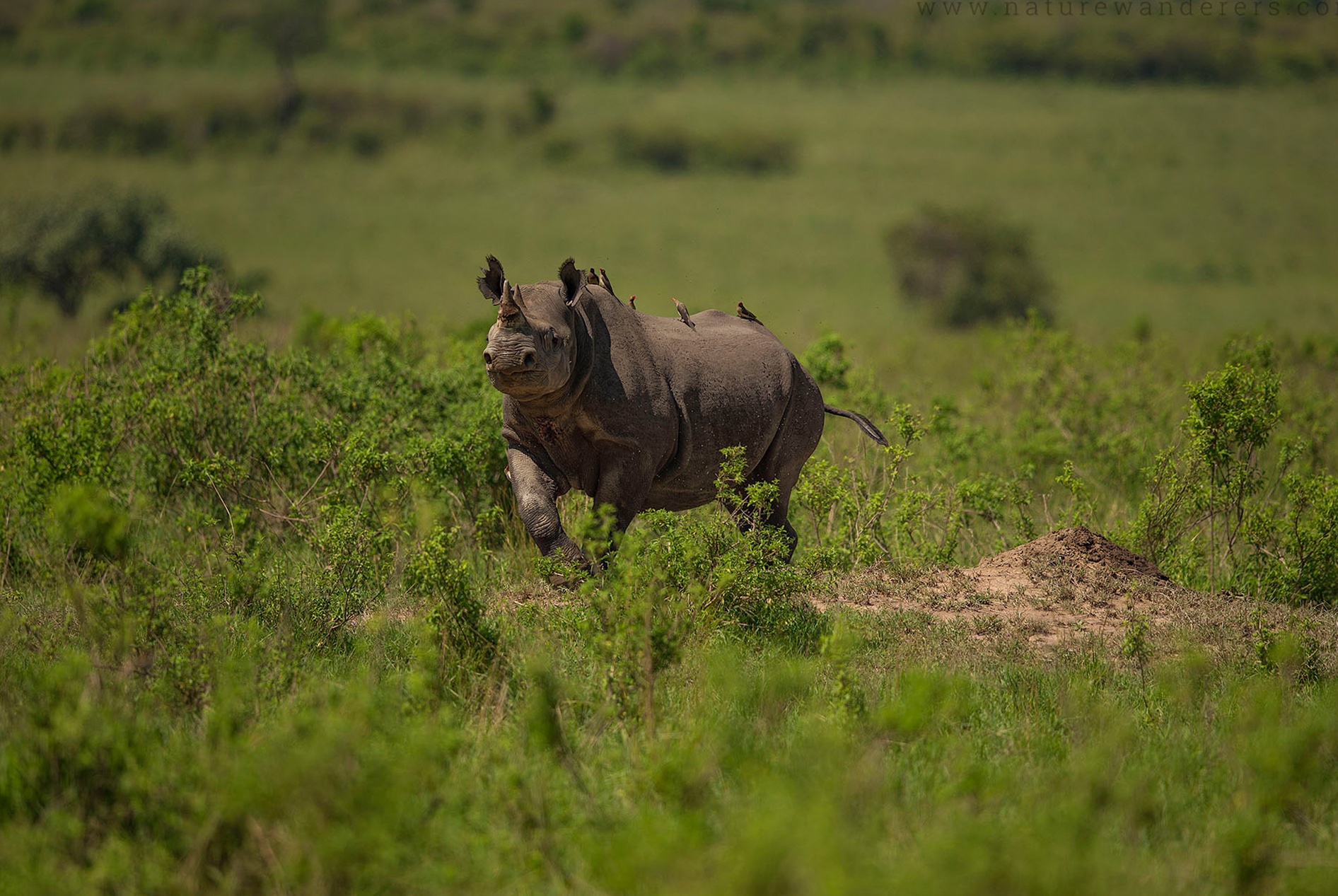
Tour Reviews
There are no reviews yet.
Leave a Review
Cancel reply, you may also like.
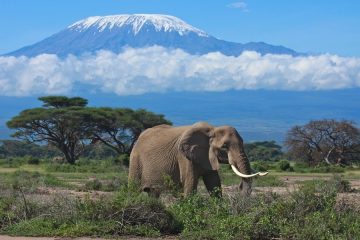
3 Days Affordable Kenya Safari to Amboseli
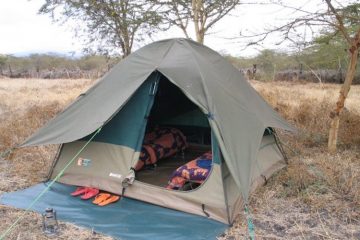
5 Days Kenya Camping Safari Adventure
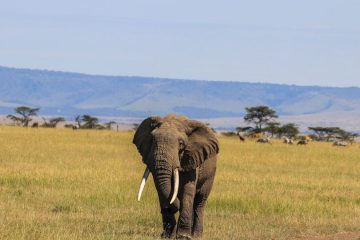
4-day safari from Mombasa; Tsavo East, West, & Amboseli
Plan Your Safari Adventure
Save time and ensure an incredible experience from the local safari companies I use to organise my own trips.
I’m here to make booking your perfect safari quick, easy and risk-free. It takes less than 1 minute to fill out the form and in under 48 hours you will receive multiple, no-obligation proposals from my favourite local tour operators with glowing online reviews.
In This Guide
5 day kenya highlights safari itinerary.
- 5 Day Eastern Circuit Highlights Itinerary
- 5 Day Western Circuit Highlights Itinerary
- 5 Day Northern Circuit Highlights Itinerary
- 5 Day Masai Mara Safari Itinerary
5 Day Safari & Beach Itinerary
Is 5 days enough in kenya, how to book a 5 day safari itinerary in kenya, private vs group kenya 5 day safaris, how much does a 5 day kenya safari itinerary cost, final thoughts.

Six different 5 Day Kenya Safari Itineraries
I’ve put together six different exciting safari itinerary options below.
These itineraries have been designed to help maximise your time on safari with the goal of seeing as much wildlife as possible. They focus on exploring two or three different parks thoroughly rather than ticking locations of a list.
The parks in Kenya are quite spread out and cannot all be visited within a 5 day safari. If you want to visit four or more parks then I’d consider a 7-10 day itinerary instead.

My two favourite places to go on safari in Kenya are the Masai Mara National Reserve and Amboseli National Park. Both destinations are fantastic for wildlife viewing and between them you can see all of the Big Five (elephants, lions, rhinos, leopards and buffalos)!
Visiting these two parks allows you to see the most wildlife. However, the distance between the two is great which means there is a day of lengthy travelling between them in the middle of this itinerary. If this drive is too arduous for you, there’s always the option to fly between the two.

Quick Facts
Average driving time: 4 hours per day
Best times of year: The long dry season between June and the end of September as well as the short dry season between December and the end of February.
Itinerary Map for Kenya Highlights Safari Itinerary

Day By Day Breakdown for Kenya Highlights Safari Itinerary
Day 1: masai mara national reserve.
Driving time (excluding game drives): 6 hours
You’ll kick-start your itinerary by journeying to Kenya’s most famous reserve. The Masai Mara National Reserve is renowned for its high density of big cats.
Additionally, it’s the setting of the annual wildebeest migration where millions of wildebeest cross the crocodile-infested Mara River in order to reach greener pastures.
This morning you will leave the energetic city of Nairobi and drive west into Kenya’s countryside. I’d recommend leaving early, around 7am or 8am so you can arrive in the Mara Mara in time for lunch.
On your 6 hour drive to the Masai Mara, you will have the opportunity to stop at the Rift Valley Viewpoint where you can admire panoramic views of the famous Great Rift Valley which stretches from Jordan to Mozambique.
You will have a second stop in the town of Narok, the last large town before the Masai Mara.
You’ll have a lovely hot lunch at your lodge in the Masai Mara before setting out on your first game drive of the trip.
About the Masai Mara National Reserve
The Masai Mara sits atop the border with the Serengeti National Park in Tanzania and is part of the wider Serengeti ecosystem. Together the two parks host the annual wildebeest migration, the largest mammal migration on earth.
Kenya hosts arguably the most anticipated part of the migration, the famous Mara River crossing, where millions of wildebeests risk their lives crossing the treacherous river that’s teeming with hungry crocodiles.
The migration takes place in Kenya between mid-July and mid-September.
The Masai Mara is also known for its high density of predators. Lions, cheetahs, leopards and hyenas can all be found in the reserve. If you’re keen to see leopards and cheetahs, the Masai Mara is the best place to see them in Kenya.

Tips for Your Afternoon Safari in the Masai Mara National Reserve
The afternoon is a great time to go on safari as it’s not as hot as in the middle of the day which means that the animals are more active. As evening approaches you’re more likely to see predators on the move.
I’d recommend staying on your game drive until the gates close at 6pm. Not only are the animals active at this time but the lighting is great for photos.
When on safari, it’s best to wear light neutral clothing. Dark colours such as navy blue and black attract tsetse flies which have a nasty bite. Wearing bright colours could be startling for the animals so neutrals are recommended.
Where to Spend the Night
Most lodges and tented camps are based near the town of Talek which is just outside the Masai Mara’s Talek Gate. This is a great location to stay as it’s just a short drive from your lodge to the gate.
There are a handful of lodges within the Masai Mara itself. These are however more expensive. If you have the budget for it however, I would recommend staying within the park as it allows you to go on safari before everyone else.
My Personal Experience in the Masai Mara National Reserve
I managed to view all of the Big Five within the Masai Mara. I encountered more lions than I can count and saw three groups of lions on separate kills. I witnessed a beautiful female leopard feed on a recently-killed gazelle just inches from our vehicle, stumbled across a rare black rhino and came across seven individual cheetahs, including four playful cubs.
The Masai Mara really really is a wildlife lover’s dream!

Day 2: Masai Mara National Reserve
Driving time (excluding game drives): 0 hours
Today you have the opportunity to go on a full-day safari within the Masai Mara, maximising your chance of spotting the Big Five.
Wake up early so that you can depart for your safari as early as possible. You’ll ideally want to be at the gate at 6am so I recommend taking a picnic breakfast which you can eat within the reserve.
You’ll have to let your guide know about your plans to have a picnic breakfast and lunch beforehand so that the lodge has time to prepare it for you and so your guide can be ready to depart promptly in the morning. Let them know the day before, before the kitchen closes for the night.
Arriving in the reserve early gives you the maximum opportunity to try to find big cats, which are most active in the morning. This is the time of day when you are most likely to witness a hunt.
You’ll be able to enjoy your picnic breakfast in a scenic spot within the reserve at some point in the morning.
Your safari will commence and can last as long as you like. If you have the stamina I’d personally recommend having a full-day game drive and returning to your lodge shortly before the gate closes at 6pm. This means you’ll also have a picnic lunch within the park.
However, if you’d rather pace yourself, you can return to your lodge in the afternoon and enjoy a hot lunch there.
I wouldn’t recommend having two safaris broken up by lunch at your lodge as you have to pay each time you enter the park so this will double your costs for the day.

Tips for Your Full-Day Safari in the Masai Mara National Reserve
Mornings in East Africa can be quite chilly so you’ll want to layer up for your safari to avoid getting cold. In contrast, the middle of the day can get quite hot. I like to wear a vest-top, shirt and then jumper over the top. I can then take layers off as the day gets hotter.
Even when it’s cloudy, you can get pretty sunburnt on safari. Therefore I recommend wearing high factor sunscreen and applying it several times throughout the day.
You’ll also want to bring insect repellent with you. Like with the sunscreen, apply it before your safari and then you can top it up as required throughout the day.
Spend another night in your lodge or tented camp either within the Masai Mara or near the gate.

Day 3: Masai Mara to Amboseli National Park
Driving time (excluding game drives): 9 hours
Today you’ll leave the Masai Mara and journey to Amboseli National Park. The distance between the two locations is just under 500km and by road will take around 9 hours to complete.
If you decide to drive between the two then the journey will take up most of your day.
Alternatively, you can fly between the two destinations. Flights from Ol Kiombo Airstrip (the closest airstrip to Talek) run daily and typically take around 3.5 hours including a layover in Nairobi.
Flights cost around $400 per person and will involve you re-entering the Masai Mara again (additional $100-$200 per person depending on whether you visit in low or peak season) so this method of transport can get pretty pricey. Still, if you have the budget, I would recommend it so that you can enjoy more time on safari.
The below itinerary assumes you are travelling by road.
Leave your lodge in the Masai Mara no later than 8am.
The drive ahead of you will take roughly 9 hours excluding any stop-offs so you want to allow ample time for delays, whether that’s due to enjoying a leisurely picnic lunch or heavy traffic. You also want to avoid driving after dark as driving at night is far less safe than driving in the daytime; leaving at 8am reduces the likelihood of this.
You should arrive in Amboseli around 5pm.
Tips for Your Drive from Masai Mara to Amboseli
The drive between the two destinations is mostly on smooth tarred roads.
You’ll have the opportunity to stop on the journey for food and to use the restroom. Not every restroom is equipped with toilet paper so I recommend bringing some just in case.
I’d recommend bringing a neck pillow for the drive if you plan on sleeping and make sure your electronic devices have pre-downloaded audiobooks and music ready for you to listen to on your drive.
You’ll spend the night either near the gate to Amboseli National Park or within the park itself. If you are staying outside the park, ensure you’re in a lodge or tented camp near Amboseli’s Kimana Gate which is to the east of the park. This is the best gate to be based near as it’s close to where Amboseli’s elephants make their daily migration into the park.

Day 4: Amboseli
Driving time (excluding game drives): 0
Today you have the entire day to experience the magic of Amboseli National park!
Enter the park no later than 6:30am. This is important as between 6:30am and 7am Amboseli’s elephant herds journey from the forests below Mount Kilimanjaro to the swamp in the centre of the national park. Watching them make this journey is truly awe-inspiring as they pretty much surround you as they cross the road.
The elephants spend most of the day lounging in the swamp so if you want to view them up-close and in action, you’ll need to see them either early in the morning or in the evening when they leave the swamp.
Whilst the elephants are making their daily migration, they pass in front of Kilimanjaro, allowing for some stunning images of Amboseli’s two iconic giants within one frame.
After spending time marvelling at Amboseli’s elephants, you will continue your game drive within the park.
Amboseli operates by giving out a 24 hour pass which means you can enter and leave the park as many times as you like within the 24 hour period. Therefore you can either opt to have a picnic lunch within the park or return to your lodge for a hot lunch.
As Amboseli is a relatively small park, you can easily return to your lodge for a hot lunch. Additionally, Amboseli can get pretty hot in the middle of the day so wildlife viewing isn’t always fantastic around lunch time.
If you do decide to stay for a picnic lunch, your tour guide will take you to Observation Hill, a picnic site atop a hill with panoramic views of Amboseli National Park.
The late afternoon and evening is another fantastic time for a game drive in Amboseli. At around 5pm the great herds of elephants journey back to the forests below Kilimanjaro, giving you the opportunity to witness them on the move, crossing the road.
Leave Amboseli around 6pm, when the park closes, and venture back to your lodge for dinner.

About Amboseli National Park
Amboseli National Park is located in southern Kenya, just above the border with Tanzania. Mount Kilimanjaro, the highest mountain in Africa, towers over the park, providing a breathtaking backdrop.
The park is famous for being the last stronghold for Africa’s big tuskers, elephants with tusks so long that they nearly touch the floor. It’s a haven for African elephants, housing some of the biggest herds in the world.
In the dry season Amboseli is relatively barren apart from the swamps in the heart of the park. The swirling red dust makes Amboseli feel atmospheric.
The swamps provide a permanent water source for animals meaning that wildlife can be viewed in large numbers year-round.
Tips for Your Full-Day Safari in Amboseli National Park
It’s up to you whether you want to spend the full day in the park or if you want to return to your lodge at lunchtime for a hot meal. Both options will give you a good experience.
In order to make the most of your time in Amboseli, arriving in the park before 6:30am and leaving after 5:30pm is essential so that you can see the most wildlife. Not only do you see the large elephant herds on the move at these times but sunrise and sunset are also the best times to see predators in action. Lions, cheetahs and hyenas can be found in Amboseli.
Wear plenty of sunscreen for your safari and be sure to bring the bottle with you so that you can top-up accordingly.
Amboseli is one of the hotter safari locations in Kenya so you’ll want to dress for its hotter temperatures. Wear lightweight clothing made of materials such as linen.

You’ll spend another night in your lodge or tented camp near Amboseli National Park.
My Experience in Amboseli National Park
I had some of my absolute favourite safari experiences in Amboseli!
Witnessing Amboseli’s huge elephant herds cross the road just metres from your vehicle really is a jaw-dropping experience. Additionally, the sheer scale of elephants crossing is something to marvel at.
Although Amboseli isn’t particularly famous for its predators, I had some incredible big cat sightings in this park as well. Amboseli has a couple of resident lion prides. I spent a couple of hours with one of the prides, watching cubs of various ages frolic about and squabble over their mother’s milk – one of the cutest wildlife sightings I’ve had to date!
Another highlight for me was witnessing a female cheetah chase and successfully catch a Thomson gazelle. This is the first successful big cat hunt that I’ve seen and it didn’t disappoint. After gorging herself on most of the kill, a hyena came in and polished off the scraps.
Before I visited Amboseli a number of people told me that it was little more than elephants. I can tell you they’re wrong. When on safari there’s always something going on and you never know what sightings lie in store.

Day 5: Amboseli to Nairobi
Driving time (excluding game drives): 5 hours
Today you’ll leave Amboseli and journey back to Nairobi. Once in Nairobi, you’ll have the chance to explore more of the city.
Nairobi is between 4 and 5 hours away from Amboseli depending on the traffic. I’d recommend setting off no later than 8am so that you can be back in Nairobi in time for some lunch.
The drive to Nairobi involves journeying on smooth tarred roads. The majority of the highway is single carriageway so traffic can build up quite easily. Journeying earlier in the day increases your chances of skipping the traffic.
Once in Nairobi you can enjoy some lunch at one of the city’s restaurants. Nairobi has an array of fabulous restaurants. My absolute favourite is the Talisman Restaurant in Karen which serves Asian-inspired cuisine including sushi.
You then have the afternoon to explore Nairobi. Below are some of my best recommendations.

Best Things to Do in Nairobi
There’s a number of incredible things that you can do in Nairobi, from visiting one of Nairobi’s well-regarded wildlife sanctuaries to meandering through one of the city’s sprawling markets.
1. The Giraffe Centre
Located just 20 kilometres outside the heart of Nairobi is the Giraffe Centre, a sanctuary dedicated to the conservation of the rare Rothschild giraffe, whose numbers had plummeted to a mere 120 in recent years.
The sanctuary has introduced numerous breeding pairs into various parks across the country, including Lake Nakuru National Park, Mwea National Reserve, Ruma National Park, and Nasalot National Reserve.
Thanks to the efforts of the sanctuary, the number of Rothschild giraffes has surged from 120 to over 300 individuals.
Visiting the Giraffe Centre not only supports a worthy cause but also provides an enjoyable experience.
You can visit the Giraffe Centre and get the opportunity to meet and feed the resident giraffes. A visit typically takes between 1 and 2 hours.
Upon your arrival at the centre, you’ll receive a coconut shell filled with pellets that the giraffes absolutely love. You’ll then have the chance to feed these pellets to some of the sanctuary’s resident giraffes.

2. David Sheldrick Elephant Orphanage
The David Sheldrick Elephant Orphanage focuses on rescuing baby elephants from across Kenya, often victims of poaching or human-wildlife conflicts, with the ultimate goal of nurturing them and reintroducing them to the wild.
The orphanage boasts a commendable track record of successfully releasing numerous elephants back into their natural habitat.
Additionally, the trust actively contributes to anti-poaching efforts by funding units across Kenya. But that’s not all – in a bid to address the challenges of drought, the trust has also played a pivotal role in establishing permanent water sources in national parks to prevent wildlife from dying of dehydration in periods of drought.
A visit to the elephant orphanage, situated in Nairobi National Park, unveils the heartwarming spectacle of the daily feeding ritual for the baby elephants, scheduled between 11 am and 12 pm.
However, it’s important to note that advance booking is mandatory for this experience, and all necessary information can be conveniently accessed on the Sheldrick Wildlife Trust’s website .
3. Nairobi National Park
If you’re not done with safaris just yet, Nairobi has its very own national park which sits just below the city’s Central Business District.
Nairobi National Park is the only national park that borders a capital city and is one of the smallest parks in the whole of Africa, making it easy to explore in an afternoon.
Visiting the national park provides you with the unique experience of seeing wildlife in front of towering skyscrapers.
The park is home to all of the Big Five (lions, elephants, rhinos, leopards and buffalos).

Tips for Visiting Nairobi
I really loved my time in Nairobi. However, you should always be cautious when exploring large cities.
Like when visiting any major city, be mindful of your belongings and don’t display your valuables. I’d recommend wearing a bum bag / fanny pack which is harder for people to access and only go out with essentials (phone, passport and not huge amounts of cash).
I’d also avoid going out after dark as this is when both crime and car accidents are most likely to occur.
Most neighbourhoods in Nairobi are generally safe. There are however a few to avoid such as Eastleigh and Kibera.
Uber and Uber Eats are available in Nairobi which makes travelling and ordering takeaways very easy. I’d recommend using Uber over taxis as the rates are agreed upon before booking whereas taxis can change their rates.
There are a number of hotels and guesthouses available in Nairobi. I personally like booking Airbnbs. There are a number of highly rated Airbnbs available across Nairobi.
I’d recommend staying in Karen as it’s one of the nicest districts in Nairobi.
My Experience in Nairobi
I had a very positive experience in Nairobi. The city is very easy to get around due to the sheer amount of Ubers that are available and Uber Eats makes it easy to order meals or even food shopping right to your doorstep.
I personally felt safe in Nairobi. Everyone I met was extremely friendly and everywhere has high security. I didn’t however go out at night and opted to stay in Nairobi’s safer neighbourhoods.

For this itinerary you can expect the cost for a private safari for two people to start at around $360 per person per day.
This price covers park fees, hotels, all meals, vehicle and guide hire, fuel and drinking water for the duration of your safari.
The bulk of any safari cost comes from the park fees. The second highest cost is the hotel which typically includes full board.
I want to give you an idea of the cost breakdown below.
The cost to enter the Masai Mara is $100 + 18% tax per person per day from January to June and $200 + 18% tax per person per day from July to December. Amboseli’s park fees are slightly lower at $80 + 15% tax per person per day from April to June and $100 + 18% tax per person per day for the rest of the year.
Based on this itinerary for 2 people, the park fees alone will be $300 per person when visiting in the first half of the year or $1,000 per person when visiting in the second half of the year.
For a budget hotel near the Masai Mara you would be looking at a minimum of $100 per night per room. However, for a hotel that’s in a prime location near the gate you can realistically expect to pay more.
You then have your vehicle and guide hire to pay for.
Due to the high cost of the park fees, local tour companies don’t typically make much profit on the safaris – around 10% – 15% and much of this is offset against the special trade prices they receive for accommodation, so they end up working out very cost effective.
Recommended Booking Options For This 5 Day Kenya Itinerary
Private Safari
Most popular & best experience – typical prices start from $360 per person per day .
Visit safarisbyella.com for free quotes from trustworthy local tour companies I use to book my own trips.

Group (Shared) Camping Safari
Good for budget or solo travellers – from $330 per person per day.
My recommended Kenya tour operators only provide private safaris, however, I’ve listed the best group options for the most similar itinerary available, on Safari Bookings below.
There are no group tours that follow this exact itinerary but there are some that follow a similar itinerary that includes either Lake Naivasha or Lake Nakuru. However, there are no budget options available. The group tours listed below are mid-range.
Click the links below to request quotes for the group safari options on the safari bookings website.
5-Day Group Safari to Masai Mara, Amboseli and Lake Naivasha Option 1
5-Day Group Safari to Masai Mara, Amboseli and Lake Naivasha Option 2
5-Day Group Safari to Masai Mara, Amboseli and Lake Nakuru Option 2
Jump back to the table of contents to select another 5 day itinerary to view or keep scrolling to read the next itinerary.

5 Day Eastern Circuit Highlights Itinerary
Kenya’s safari destinations can be split into three different circuits: the eastern, northern and western circuits. Selecting a circuit would be preferable above the above 5 day Kenya highlights safari option if you wanted to cut-down on driving time.
The eastern circuit is made up of the Masai Mara, Lake Naivasha and Lake Nakuru. It’s arguably the most popular 5 day itinerary as it includes Kenya’s flagship park and doesn’t include too much driving.
On this itinerary you will get to spend two nights in the Masai Mara as well as a night in Lake Naivasha and a night in Lake Nakuru.
The combination of these three parks will give you the opportunity to potentially spot all of the Big Five.

Average driving time: 3.3 hours per day
Itinerary Map for 5 Day Eastern Circuit Highlights

Day By Day Breakdown for 5 Day Eastern Circuit Highlights
You’ll kick-start your itinerary by visiting Kenya’s most famous reserve – the Masai Mara. It’s one of the best places in the country to view Kenya’s big cats.
You’ll leave Nairobi in the morning, ideally between 7am and 8am and journey to the Masai Mara. The drive will take around 6 hours and can be broken-up by a couple of stops on the way, including to the Rift Valley Viewpoint.
You should arrive at your lodge in the Masai Mara in time for a hot lunch at around 2pm.
You then have 2 options for your afternoon. You can go on an afternoon game drive within the reserve. The late afternoon is one of the best times to try to catch predators in action. I’d recommend staying in the reserve until it closes at 6pm.
Alternatively, you can visit a nearby local Maasai tribe and learn about their culture.
As you have to pay an entrance fee each time you enter the Masai Mara, visiting the Maasai tribe would be the most cost-effective option if you’re on a tight budget.
You can then return to your lodge for some dinner.

About the Masai Mara
The Masai Mara is one of the largest game reserves in Kenya, stretching for 1,510 square kilometres (580 square miles).
It’s named in honour of the Maasai tribe who call the area surrounding the reserve their home. Additionally ‘Mara’ means spotted in the Maasai language, a description of the plains which are spotted with the occasional acacia tree.
The Masai Mara houses an extremely high density of big cats, especially lions. Therefore it’s one of the best places in the country to catch a glimpse of them.
The Masai Mara also houses the great wildebeest migration between mid-July and mid-September. Visitors can expect to see large numbers of them dotting the plains and if you’re lucky, you can even witness them crossing the treacherous Mara River.
Tips for Visiting the Masai Mara
The Masai Mara hosts tsetse flies which give a nasty bite. To avoid getting bitten it’s advisable to wear light coloured clothing. Blacks and navy blues attract the pesky flies. Also wear insect repellent and remember to top it up throughout the day.
The best time to go on safari is either early in the morning or late in the afternoon. The cooler temperatures make animals more active, particularly the Masai Mara’s predators.
I’d recommend spending the night in a lodge or tented camp that’s either within the Masai Mara itself or very close to one of the gates.
Talek is a great area as it’s very close to the Talek Gate and you can find a number of lodges here.
The lodges in the reserve itself are luxury lodges so if you are going on a budget or mid-range safari, Talek is a great option.

Today you have a full day to go on safari in the Masai Mara.
Start the day bright and early. You’ll want to start your safari so you can be at the gate to the reserve at 6am. By entering early, you are increasing the chances of seeing the Masai Mara’s predators on the move.
Today you’ll be going on a full-day safari. As a result, you’ll want to arrange with your guide and lodge the night before to have a picnic breakfast and lunch for your safari.
You can stay on safari as long as you like. I’d recommend staying until the gates close at 6pm but you can leave early if you’re feeling tired.
You’ll then have a nice hot dinner at your lodge.
Tips for Your Full-Day Safari in the Masai Mara
You’ll want to bring sunscreen and insect repellent with you on your safari so that you can top-up accordingly. Even in cloudy weather you should wear high factor sunscreen.
Remember to wear light-coloured clothing so that you don’t avoid the biting tsetse fly.
I’d also recommend wearing a number of layers for your safari. The early mornings can be cold so you’ll want to wrap up warm. Then as the day gets warmer you can discard layers. I tend to wear a vest top, shirt and jumper.
Spend another night near the Masai Mara National Reserve.
My Experience Visiting the Masai Mara
The Masai Mara definitely lives up to its reputation as being one of the best safari destinations in the world.
On my Masai Mara safari I was able to view all of the Big Five (lions, elephants, leopards, rhinos and buffalos).
A highlight for me was witnessing a leopard enjoy a freshly-caught impala just inches away from our vehicle. I also witnessed a huge male lion feast on a buffalo right beside the road. Another magical moment was encountering a mother cheetah and her four energetic little cubs.

Day 3: Lake Naivasha
Lake Naivasha is a large freshwater lake that is known for its high density of hippos. It’s a great place to go on a boat safari.
Aim to set-off from your lodge near the Masai Mara at around 8am.
After around 5 hours on the road you should arrive at Lake Naivasha in time for some lunch. You can enjoy lunch either at your lodge or at a picnic site.
For the afternoon you can take to the lake in a boat. This is a great opportunity to see hippos up close as well as an array of birdlife.
You can opt for a walking safari on Crescent Island which lies within the lake. Here you can see a number of herbivores including zebras, gazelles and giraffes.
About Lake Naivasha
Lake Naivasha is the highest lake within the rift valley, sitting at 1884m above sea level. The lake is 13km in length but is only 5 metres deep.
Lake Naivasha is a bird lover’s dream, housing 400 different species including flamingos, eagles and much more.
There are a number of lodges near the southern shores of Lake Naivasha where you can spend the night.

Day 4: Lake Nakuru
Driving time (excluding game drives): 2 hours
Not far to the north of Lake Naivasha lies another lake: Lake Nakuru. This soda lake is famous for its high concentration of flamingos and for being a sanctuary for both black and white rhinos.
Depart from Lake Naivasha at around 8m in order to arrive at Lake Nakuru by mid-morning.
You can then go on a walking safari in Lake Nakuru National Park before enjoying a picnic lunch.
For the afternoon, go on a game drive in Lake Nakuru National Park. This is a great opportunity to try to spot the park’s famous residents, namely the protected black and white rhinos.
You’ll then have dinner at your lodge.
About Lake Nakuru National Park
Lake Nakuru is a saltwater lake within the Rift Valley. The high salt content attracts over a million flamingos to the lake each year as it’s the perfect place for them to feed on blue-green algae, a meal that makes their feathers pink in colour.
Lake Nakuru is surrounded by a national park. Unlike many parks and reserves in Kenya, Lake Nakuru National Park is enclosed by 3 metre-high fencing which was erected to help protect the species that reside in the park.
You can find four of the Big Five in Lake Nakuru: lions, leopards, rhinos and buffalos.
Lake Nakuru National Park is one of the best places in Kenya to see both the black rhino and white rhino. Within the park is a sanctuary which introduced its first 2 rhinos to the park in 1984. Today the park has over 150 rhinos.
Within the park you can also find the rare Rothschild giraffe, another species that was re-introduced after experiencing a devastating country-wide decline.
There are a number of lodges where you can spend the night either within Lake Nakuru National Park itself or within nearby Nakuru town.

Day 5: Lake Nakuru to Nairobi
Driving time (excluding game drives): 3.5 hours
Today you’ll journey back to Nairobi. You can then spend the afternoon exploring this lively city. There’s a plethora of things to do here, some of my favourites include visiting The Giraffe Centre and Nairobi National Park.
Leave Lake Nakuru at around 9am or 10am so that you can arrive in Nairobi in time for some lunch.
There are a number of delicious restaurants within the city. My favourite restaurant can be found in the Karen region and is called Talisman Restaurant . It’s one of the highest rated reviews in the city and serves Asian-inspired cuisine.
This afternoon you can spend your time in Nairobi as you wish. Perhaps that’s spending a couple of hours with the giraffes at The Giraffe Centre or going on one last safari in Nairobi National Park.
I loved my time exploring Nairobi! There’s so much to see here and everyone I encountered in the city was extremely friendly.
However, as with any visit to a bustling city it’s wise to be vigilant about your belongings and avoid conspicuous displays of valuables. I suggest using a bum bag or fanny pack, which is more secure and only venturing out with essentials such as your phone, passport, and a small amount of cash.
Additionally, it’s advisable to refrain from going out after dark, as this is when both criminal activities and traffic accidents are more likely to occur.
There are a number of hotels and Airbnbs where you can spend the night in Nairobi. I personally prefer Airbnbs as they are slightly cheaper and I love the personal touches you get with them.
When choosing a hotel or guesthouse, opt for one in a safe neighbourhood such as Karen.

This itinerary will be a similar cost to the first itinerary as the park fees are similar. You are still visiting Masai Mara which has the highest park fees. Lake Naivasha and Lake Nakuru are cheaper to visit but as you will be visiting parks on all days apart from the final day (for itinerary 1 there was a day of driving), the costs end up being similar.
For this itinerary you can expect the cost for a private safari for two people to start at around $350 per person per day.
You can reduce this cost by not going on a game drive in the Masai Mara on the first day and opting to visit a Maasai village instead. This will save you paying for park fees for that afternoon which cost $100 + 18% tax per person between January and June and $200 + 18% tax per person between July and December.
The bulk of the safari cost is made up by the park fees.
Most popular & best experience – typical prices start from $330 per person per day .
Good for budget or solo travellers – from $130 per person per day.
5-Day Group Camping Eastern Circuit Safari Itinerary
5-Day Group Budget Eastern Circuit Safari Itinerary Option 1
5-Day Group Budget Eastern Circuit Safari Itinerary Option 2

5 Day Western Circuit Highlights
The Western Circuit takes you to the best national parks in the south west of Kenya.
Amboseli National Park, renowned for its huge population of elephants, will be your first stop.
You’ll then visit Tsavo West National Park, part of Tsavo, the largest national park in Kenya. This park is known for its mountainous landscape and is a great place to spot black rhinos.
The itinerary ends back in Nairobi.

Average driving time: 3 hours per day
Best times of year: The long dry season between June and the end of September.
Itinerary Map for 5 Day Western Circuit Highlights

Day By Day Breakdown for 5 Day Western Circuit Highlights
Day 1: amboseli national park.
You’ll kick-start your 5 day itinerary by visiting my favourite national park in Kenya, Amboseli.
Amboseli is home to some of the largest herds of elephants in the world. Additionally, it’s one of the best places to get a view of Mount Kilimanjaro.
You can view many other animals in Amboseli too, including lions, cheetahs, giraffes, zebras and much more.
Leave Nairobi at around 8am. The earlier you leave, the less likely you are to get caught-up in traffic.
The journey will take roughly 5 hours although this time can fluctuate depending on traffic. Much of the drive involves journeying down a single-lane highway so your journey time is heavily dependent on how busy the road is.
You should arrive in Amboseli around lunchtime. I’d recommend having a hot lunch at your lodge.
For the afternoon you will go on your first game drive. Be sure to stay in the national park right until it closes at 6pm. This is because at around 5pm the large elephant herds are on the move and cross the road in the park to journey towards the forests below Mount Kilimanjaro. It’s one of the best times to view the elephants.
After your game drive, return for some dinner at your lodge.
Originally a game reserve, Amboseli was established as a national park in 1974 and was later declared a UNESCO World Heritage site in 1991.
Amboseli is one of the more popular national parks in Kenya. Visitors are drawn by the unique landscape, which is towered over by Mount Kilimanjaro, as well as the park’s resident elephant herds.
The park is surrounded by the Masai tribe who are to thank for the park’s high density of elephants. Their presence in the area has deterred poachers as the Masai have a fearsome reputation and thus allowed elephants to thrive.

Tips for Visiting Amboseli National Park
The best times to see Amboseli’s elephants are early in the morning and late in the afternoon. This is when they journey to and from the swamp within the heart of the park. In the middle of the day, they relax in the swamp and sightings aren’t as good.
Amboseli National Park can get pretty hot. Daytime temperatures are typically between 20°C and 30°C. You’ll therefore want to wear light clothing that keeps you cool.
Wear plenty of high factor sunscreen and insect repellent for your safari.
If catching a glimpse of Kilimanjaro is important to you then you’ll want to visit Amboseli within the long dry season, between June and late-September, when there are less clouds. Viewing the mountain is never guaranteed but you will certainly increase your chances by visiting at this time of year.
There are a small number of lodges within Amboseli National Park. You can either spend the night here or in one of the many lodges which are just outside Amboseli’s Kimana Gate.
Kimana Gate is the closest gate to where the elephants typically cross to and from the swamps so this is the best gate to be located near.
I’ve had some of my best safari experiences in Amboseli National Park!
Witnessing the huge herds of elephants cross the road to and from the swamp is truly magical. It’s crazy how close to the vehicles they can get and seeing so many of them at once really is a sight to behold.
Elephants are not the only residents that you can hope to encounter. I was delighted to stumble across a pride of lions with very young cubs. Watching the cubs play filled me with joy.
I also witnessed three cheetah hunts in Amboseli, two of which were successful.

Day 2: Amboseli National Park
Today you have a full day to explore Amboseli National Park.
Rise early in order to start your game drive at 6am, when the park gates open. Entering early gives you the highest chances of witnessing the elephants cross over to the swamp.
You’ll then meander through the park, keeping an eye out for Amboseli’s varied inhabitants.
At lunchtime you will stop at Observation Hill, the only area within the park where you can leave the vehicle. You can enjoy your picnic lunch at the top of the hill where you will have wonderful uninterrupted views of Amboseli National Park.
Amboseli issues 24 hour passes for the park so you’ll end your safari at the same time that you entered the previous day which will be around 3pm.
You can then spend the rest of the afternoon relaxing at your lodge.
Tips for Your Full-Day Game Drive in Amboseli
In order to get the most out of your safari, you’ll need to bring a picnic lunch with you. You’ll just need to let your guide know the night before so that he can inform the lodge.
Bring plenty of sunscreen and insect repellent with you so you can keep applying both throughout the day.
You’ll want to bring a cap or sunhat with you as it can get pretty hot and sunny.
You’ll spend another night in or near Amboseli National Park.

Day 3: Tsavo West National Park
Driving time (excluding game drives): 4 hours
Today you’ll move to another of Kenya’s beautiful national parks.
Tsavo West is one of the largest national parks in Kenya. When combined with Tsavo East, the two make up the biggest park in the country. In Tsavo West you can find all of the Big Five (elephants, lions, leopards, rhinos and buffalos).
It’s around a 4 hour drive to Tsavo West so I recommend setting off early. Leaving Amboseli at 8am allows you to arrive at Tsavo West at lunchtime.
You can enjoy either a picnic lunch in a scenic lunch spot or have a hot lunch at your lodge in Tsavo West.
After lunch you will go on an afternoon game drive within the national park.
Tsavo West is an extremely diverse park when it comes to terrain. It has mountains, forests, grasslands, caves and volcanic springs.
The park is also home to a wide range of wildlife. You can view all of the Big Five here as well as giraffes, cheetahs, hyenas and more. The park also houses a number of critically endangered species such as Grevy’s zebra, wild dogs and black rhinos.
Tsavo is famous for the notorious man-eaters of Tsavo, two lions who killed dozens of railway workers in 1898.
One of the highlights of Tsavo West National Park is Mzima Springs, an oasis of four pools in the western part of the park. The water comes in from underground streams from the Chyulu Hills. A large number of hippos call this oasis home.
Tips for Visiting Tsavo West National Park
Like with all safaris, remember to wear light neutral colours to avoid attracting tsetse flies. Blacks and navy blues should be avoided.
Bring plenty of sunscreen and insect repellent on game drives with you so that you can reapply where necessary.
There are a number of lodges surrounding Tsavo West where you can spend the night.

Day 4: Tsavo West National Park
Today you will spend the full day on safari in Tsavo West National Park.
This morning you will leave on a full-day safari within the national park. I recommend entering the park at 6am when the park opens.
You’ll then spend the morning searching for Tsavo West’s many animals.
I’d recommend having a picnic-lunch part-way through your safari instead of returning to your lodge for lunch due to the vast size of Tsavo West. This enables you to journey deeper into the park.
Tsavo West has 24 hour passes so you will leave the national park in the early afternoon, giving you some time to rest at your lodge.
Tips for Your Full-Day Game Drive in Tsavo West
As you’ll be having a picnic lunch for your day in Tsavo you’ll need to let your guide know the day before so he can place the order with your lodge.
Bring sunscreen, insect repellent and a cap or hat for your game drive.
You’ll spend another night near Tsavo West National Park

Day 5: Tsavo West to Nairobi
Driving time (excluding game drives): 6.5 hours
Today you’ll leave Tsavo West and journey back to Nairobi in time for some lunch in the city. You can then spend the afternoon either exploring Nairobi or relaxing.
This morning you’ll depart from Tsavo West and journey back to Nairobi. I’d recommend leaving at 7am or 7:30am so that you can be back in Nairobi in time for some lunch.
There are a number of delicious eateries in Nairobi for you to enjoy. My personal favourite is Talisman Restaurant in Karen. It serves a range of Asian-inspired dishes and the setting is lovely.
You can spend the afternoon as you wish. This may be exploring or simply relaxing. If you opt to explore, a visit to the Giraffe Centre or even an afternoon safari in Nairobi National Park are great options.
Nairobi is a bustling capital and like with any major cities, you have to be careful about your belongings. I’d recommend only going out with minimal valuables and cash. These are best kept in a fanny pack or bum bag. Also don’t put any valuables on display.
I’d avoid going out at night as the roads can get quite hectic and this is also when crime is most likely to occur.
You can use Uber to easily get around the city and Uber Eats is a great option if you want to order a delivery service.
I personally really enjoyed my time in Nairobi!
There are a number of hotels and Airbnbs available in Nairobi. I always personally prefer Airbnbs as they are often cheaper and I love the personal touches you get. There are a number of highly-rated Airbnbs available in Nairobi. I’d recommend booking one in one of Nairobi’s nicer areas such as Karen.

This itinerary is slightly cheaper than the previous two itineraries as you won’t be visiting the Masai Mara, the most expensive safari destination in Kenya.
For this itinerary for two people you can expect to spend around $270 per person per day. This cost will be less if you are travelling in a larger group.
This price assumes booking with a local safari company. The costs will be higher if you opt for mid-range and budget accommodation levels.
It costs $100 + 18% tax per person per 24 hour period to visit Amboseli National Park. Park fees are similar for Tsavo West National Park.
Most popular & best experience – typical prices start from $270 per person per day .
Good for budget or solo travellers – from $270 per person per day.
5-Day Group Budget Western Circuit Itinerary

5 Day Northern Circuit Highlights
Northern Kenya is very different from the rest of the country. Here you can find many rare species of animals such as Grevy zebra, Somali ostrich, Reticulated giraffe, gerenuk and the Beisa oryx.
The Northern Circuit isn’t anywhere near as popular as the Eastern and Western Circuits but in my opinion it’s extremely underrated. The fact that it’s not as popular is a big plus point as it means the parks and reserves that you visit won’t be as busy.
Kenya’s Northern Circuit visits Ol Pejeta Conservancy, the largest black rhino sanctuary on earth. This conservancy is also home to the world’s two last remaining northern white rhinos.
Next on this 5 day itinerary is Samburu National Reserve, home to the Special Five listed above. The reserve also houses all big cats (lions, leopards and cheetahs) as well as over 350 species of bird.
You’ll then visit Lake Nakuru, one of the best places to see both the black and white rhino.
Finally you’ll visit Lake Naivasha, a great place to see hippos up-close.

Average driving time: 3.5 hours per day
Itinerary Map for 5 Day Northern Circuit Highlights

Day By Day Breakdown for 5 Day Northern Circuit Highlights
Day 1: ol pejeta conservancy.
Driving time (excluding game drives): 4.5 hours
You’ll kick-start your itinerary by visiting Ol Pejeta Conservancy, home to the world’s two last remaining northern white rhinos.
Today you’ll leave Nairobi and journey to Ol Pejeta Conservancy which is around 4.5 hours north of Nairobi, in the foothills of Mount Kenya.
I’d recommend leaving Nairobi at around 8am so that you can arrive in Ol Pejeta in time for a hot lunch at your lodge.
After lunch you will go on a game drive in Ol Pejeta Conservancy. This is one of the best places in the world to see black rhinos and white rhinos. You can also expect to see elephants and giraffes here. Request to drive through the endangered species enclosure as this is where you can find the last remaining northern white rhinos.
Alternatively, you can go on a walking or horse riding safari.
You’ll return to your lodge after your game drive for some dinner.

About Ol Pejeta Conservancy
Ol Pejeta is a 36,400-hectare non-profit conservancy that’s renowned as the best places to see rhinos in Kenya.
The conservancy has a 283-hectare endangered species enclosure that’s fenced to protect the animals within it from poachers. It’s here where you can find the world’s last remaining northern white rhinos as well as the rare Grevy’s zebra and Jackson’s wildebeest.
Ol Pejeta also has a chimpanzee sanctuary that you can visit. This is the only place where you can view chimpanzees in Kenya.
The conservancy has fitted its resident lions with radio collars so that rangers are able to track their whereabouts and ensure that they don’t leave the protection of the conservancy. You can join a ranger to track the lions either in the morning between 6:30am and 8:30am or in the evening between 3:30pm and 5:30pm.
Ol Pejeta is unique in that cattle farming has been built into its conservation plan, strategically being grazed throughout the conservancy in order to benefit the land and provide employment.
Tips for Visiting Ol Pejeta Conservancy
Ol Pejeta offers a range of activities for visitors. When you’re staying here for a mere 24 hours, it can be hard to decide what to do. My top recommendation would be to visit the endangered species enclosure to catch a glimpse of the last remaining northern white rhinos. This is the only place in the world where you can see them.
There are several lodges either within the conservancy itself or just outside it.

Day 2: Ol Pejeta Conservancy & Samburu National Reserve
Driving time (excluding game drives): 3 hours
You’ll spend the morning in Ol Pejeta and then journey to Samburu National Reserve in the afternoon.
You’ll spend the morning either on a morning game drive, horse riding safari, visiting the chimpanzee sanctuary or tracking lions with one of Ol Pejeta’s rangers. This is entirely down to your personal preference.
You’ll then enjoy some lunch in Ol Pejeta before moving to your next destination.
Samburu National Reserve is around a 3 hour drive north from Ol Pejeta.
You’ll arrive in Samburu National Reserve in the late afternoon. You will then spend the evening relaxing at your lodge.
About Samburu National Reserve
Nestled on the banks of the Ewaso Ng’iro river, Samburu is famous for housing Kenya’s ‘Special Five’: Grevy zebra, Somali ostrich, Reticulated giraffe, gerenuk and the Beisa oryx, some of which are endangered.
Additionally, Samburu is one of the few places in Kenya where you have the opportunity to spot the extremely rare African wild dog. It’s also touted as one of the best places in the country to spot leopards.
One of the animals that is most abundant in Samburu is the African elephant.
The reserve is named after the Samburu tribe, nomadic pastoralists who live in the region.
Samburu is one of the two regions where Joy Adamson, the author of ‘Born Free’ raised Elsa the lioness.
There are a handful of lodges within or near to Samburu National Reserve where you can spend the night. There aren’t however many budget options available.

Day 3: Samburu National Reserve
Today you’ll embark on a full-day game drive within Samburu National Park.
Wake up early to depart for your safari at 6am, when the reserve opens.
Your entry permit to Samburu is valid for 24 hours and permits multiple entry so you may wish to return to your lodge at lunch-time for a hot lunch before going out on an afternoon game drive.
Alternatively, you may wish to bring a picnic lunch with you which you can eat at a scenic picnic site within the park. I’d personally recommend this option so you have as much time as possible on safari.
Continue your safari into the evening. The reserve closes at 6pm so I recommend finishing your game drive just before the gate closes.
Tips for Visiting Samburu National Reserve
Being towards the north of Kenya, Samburu can get pretty hot. Therefore you’ll want to wear lightweight clothing. Despite this, the mornings can get a bit chilly so I’d recommend layering up for your day. I like to wear a vest top covered by a linen shirt covered by a fleece or jumper.
Wear plenty of high factor sunscreen for your safari as well as insect repellent. I recommend taking both with you for your game drive so that you can re-apply as necessary throughout the day.
You’ll spend another night in Samburu National Reserve.

This morning you will leave Samburu and journey to Lake Nakuru which is famous for its high concentration of flamingos as well as being a safe haven for white rhinos.
This morning you’ll depart from Samburu. I’d recommend leaving between 7am and 8am so that you can arrive at Lake Nakuru in time for lunch. You can either have a hot lunch at your lodge or picnic lunch at a pretty picnic spot.
After lunch you will go on a game drive in Lake Nakuru National Park. You can expect to see white rhinos, giraffes, zebras and buffalos within this park. Lions and leopards are also present but aren’t as common.
After your game drive you will have dinner at your lodge.
About Lake Nakuru
Lake Nakuru National Park houses the first ever rhino sanctuary in Kenya. Both white and black rhinos can be found here and over 100 individuals can be encountered within the park.
Lake Nakuru has only four of the Big Five, elephants not being present. It’s a haven for bird lovers, providing refuge for over 400 species, including both lesser and greater flamingos who are drawn to Lake Nakuru due to the high salt content.
Lake Nakuru National Park is located within the Great Rift Valley and the lake sits at 1,754 metres above sea level . There have been issues in recent years with the lake’s water levels increasing at alarming rates. In 2013 this caused the lake’s resident flamingos to migrate to Lake Bogoria and over 600 houses in the nearby town of Nakuru have since flooded. Erratic weather as a result of climate change is to blame .
Nakuru means ‘dusty place’ in the local Maasai language.
There are a number of lodges both on the outskirts of Lake Nakuru National Park and within the neighbouring town of Nakuru. Additionally, there are a couple of lodges within the park itself.

Day 5: Lake Naivasha and Nairobi
Driving time (excluding game drives): 2 hours to Lake Naivasha followed by 2 hours to Nairobi
This morning you will journey to Lake Naivasha which is a mere 2 hours south from Lake Nakuru. You’ll then journey back to Nairobi in the afternoon.
This morning you’ll depart from Lake Nakuru National Park and journey to nearby Lake Naivasha. The drive takes around 2 hours.
I recommend setting off around 8am so that you’ll arrive in Lake Naivasha by mid-morning.
Once at Lake Naivasha you can take to the lake in a boat and enjoy a boat safari. You’ll get to admire hippos up-close and spot a variety of species of birds.
Within the lake is an island known as Crescend Island. You’ll have the opportunity to moor here and go on a walking safari on the island. Crescent Island is home to a number of herbivores including giraffes, zebras, gazelles, impalas and more.
Have lunch on the banks of Lake Naivasha before heading back to Nairobi. It’s around a 2 hour drive to Nairobi. You should arrive by mid-afternoon.
Lake Naivasha is a large freshwater lake in the Great Rift Valley. The lake is home to a large number of hippos and is popular with birdlife. Like Lake Nakuru, lake Naivasha has expanded in recent years, the surface area increasing from 139 square kilometres to 198 square kilometres within 10 years.
The lake depth is typically around 6 metres in depth. However the deepest part of the lake is beside Crescent Island and drops to 30 metres in depth.
Spend the night in Nairobi. There are a number of hotels and Aibnbs available in the capital city.

This itinerary for 2 people costs around $300 per person per day. Whilst the northern parks aren’t as expensive as the southern parks, the accommodation options are more pricey in the north, especially around Samburu.
Prices assume working with a small local safari company and will vary depending on the level of accommodation chosen and number of people sharing the safari truck.
There are no group safaris offered for this itinerary.

Ultimate 5 Day Masai Mara Safari Itinerary
If you’d rather spend your time in one safari location for your 5 day Kenya itinerary then you really can’t go wrong with the Masai Mara. The reserve is so large that you can easily spend a couple of weeks here.
The Masai Mara is the best place to see Kenya’s big cats. Additionally it has a healthy population of elephants, giraffes, zebras and much more. If you’re lucky, you can even spot a black rhino here.
This itinerary has the least amount of driving as you will be basing yourself for 4 nights in the same location.
By cutting down on driving time, you can spend more time on game drives which increases your chances of wildlife sightings. This itinerary is therefore great for wildlife enthusiasts or photographers.

Average driving time: 2.4 hours per day
Best times of year: Between June and the end of February.
Itinerary Map for Ultimate 5 Day Masai Mara Safari Itinerary

Day By Day Breakdown for Ultimate 5 Day Masai Mara Safari Itinerary
Day 1: masai mara national reserve or maasai village.
Today you will journey from Nairobi city to the Masai Mara National Reserve. This will take all morning.
For the afternoon you can either go on your first game drive within the Masai Mara or visit a Maasai boma.
This morning you’ll depart from Nairobi and journey west to the Masai Mara. I’d recommend leaving around 8am so you can arrive at your lodge around lunchtime, in time for a hot lunch.
On the 6 hour drive you’ll have the opportunity to stop at the Rift Valley viewpoint as well as in Narok town, the last major town before the Masai Mara.
You’ll have lunch around 2pm at your lodge.
This afternoon you can either go on an afternoon game drive or visit a nearby Maasai village.
If you opt for the game drive, I’d recommend staying out until the park closes at 6pm. The late afternoon is a great time to spot predators on the move as it’s cooler at this time of day.
Alternatively, you can visit a nearby Maasai boma and learn about the Maasai tribe and their culture. Typically on a visit to the tribe you will witness traditional song and dance, get a tour of the boma and visit a Maasai house.
About the Maasai Tribe
The Maasai tribe can be found across Kenya and northern Kenya. They are famous for their colourful robes known as shukas as well as their traditional jumping dance. The men jump to show their strength and the men who jump the highest are most favourable amongst the women.
The Maasai have a reputation for being fearsome warriors. The men carry spears and used to have to kill lions as a form of initiation into manhood. These days the killing of lions is forbidden and instead the Maasai have a huge part to play in the conservation of the Masai Mara.
The Maasai now live in harmony with nature. Losing livestock to predators is still a concern for the tribe. However, conserving the wildlife is in the tribe’s best interest as the wildlife brings in a huge source of income for the tribe as they are employed by local safari lodges.

Tips for Visiting the Maasai Tribe
The Maasai dress conservatively so although it isn’t strictly necessary I’d always encourage you to do the same. This simply means wearing long trousers rather than shorts.
It’s always polite to ask the Maasai if they are happy having their photographs taken. They are typically more than willing but it’s always nice to ask them first.
The Maasai are extremely proud of their culture so I’d recommend showing an interest by asking them questions.
Whilst it isn’t mandatory, tipping is generally encouraged throughout Eastern Africa. I’d therefore recommend that you tip your Maasai guide at the end of your visit.
Every Maasai boma has a market where you can purchase souvenirs. Don’t feel any pressure to purchase anything here if you don’t want to. If you are interested however, the Maasai expect you to negotiate.
The Talek region is a great place to base yourself for your visit to the Masai Mara. It’s a relatively central location and is close to two different gates to the Mara.
Within the Talek region there is a vast range of lodges and tented camps for you to stay at.
Alternatively, there are a handful of lodges within the reserve itself. These are typically more expensive but if you have the budget, I’d recommend it as it saves you time travelling to and from the gates in the morning and evening.
My Experience Visiting the Maasai Tribe
I’ve visited a number of Maasai villages over the years. My favourite boma that I’ve visited is a boma close to the Talek River in the Masai Mara. You can view its exact location here .
The tribe was extremely friendly and welcoming.
Whilst the tribe follow a lot of traditions, they are becoming more modernised. You’ll notice that some tribe members have mobile phones for example. This doesn’t mean that the tribe is just putting on a show for tourists but is more of a sign of how their culture is gradually changing so that they can adapt to the modern world.
I personally advocate for visiting at least one Maasai boma during your visit. Tourism is what keeps their culture alive as it gives them valuable income.

Day 2-4: Masai Mara Full-Day Game Drives
For days 2, 3 and 4 of your itinerary you’ll be able to go on as many game drives as you wish within the Masai Mara National Reserve.
I’d recommend entering the reserve just once each day as you have to pay every time you enter the reserve. Each game drive can be as long as you like whether that’s full-day drives, morning drives or afternoon drives.
In order to get the most out of your visit to the Masai Mara National Reserve you may wish to go on full-day game drives for these three days.
I’d recommend arriving at the entrance gates at 6am as this is when they open. Being in the reserve at sunrise increases your chances of seeing the Masa Mara’s predators on the move as this is when they’re most active.
Leaving for such early safaris means that you’ll need to take a picnic breakfast with you. You’ll just need to let your guide know this the night before so they can inform the lodge.
Additionally, if you’re planning on being in the reserve all day you’ll need a picnic lunch.
Arrive back from your game drive in the evening and enjoy a well-earned hot dinner at your lodge.
The Masai Mara National Reserve is one of the most famous safari destinations in the world. It’s particularly famous for its high concentration of big cats. Lions, cheetahs and leopards can all be found in high numbers within the reserve.
The Masai Mara also hosts the great wildebeest migration between mid-July and mid-September each year. When visiting the Masai Mara during this time you can expect to see millions of wildebeest and zebras grazing throughout the reserve. You can also witness them crossing the crocodile-infested Mara River.
The Big Five (lions, elephants, leopards, rhinos and buffalos) all call the Masai Mara home. Rhinos are the hardest to spot as they prefer to spend their time in dense swathes of forest.
More than 570 species of bird can be viewed in the Masai Mara.

The Masai Mara is one of the more expensive destinations to visit in Kenya. The reserve charges you $100 + 18% tax per person per entry between January and June and $200 + 15% tax per person per entry between July and December.
To keep costs under control I’d recommend entering the reserve just once per day. This likely means that you’ll need to bring a picnic lunch and breakfast with you that will have been prepared by your lodge.
Each permit is valid for 12 hours meaning that you can go on full-day safaris from 6am to 6pm.
The Masai Mara has biting tsetse flies so wear light-coloured clothing to avoid attracting them. Tsetse flies love dark colours such as black and navy blue. Also wear insect repellant.
Bring plenty of sunscreen and insect repellent with you on your game drives so you can reapply where necessary.
Spend the nights in a lodge or tented camp either within the reserve itself or very close to the gate. Talek is a great location as it has a range of lodges and is only a short drive from the gate.
I spent 6 days in the Masai Mara on safari and in this time managed to view all of the Big Five. I was glad that I allowed a number of days within the reserve as some animals are elusive and so it takes patience to view them, like the leopard and black rhino.
Elephants, lions, giraffes and buffalos are abundant so there’s a good chance you can see these animals each day, like I did.
Some of my top sightings included stumbling across a mother cheetah and her four young cubs on a number of occasions, watching a huge male lion beside a buffalo kill and finding a leopard eating a young gazelle just inches away from the road.
The Masai Mara provided me with some of my top wildlife sightings and I can’t wait to return again soon.

Day 5: Back to Nairobi
Today you will leave the Masai Mara and journey back to Nairobi.
Today you have the opportunity to take it easy. You can have a leisurely breakfast and leave your lodge in your own time.
Alternatively you can plan to leave your lodge at 8am in order to arrive in Nairobi in time for lunch.
If you opt to leave early and have an afternoon in Nairobi then you’ll have some time to explore the city.
One of my favourite things to do is to visit The Giraffe Centre, where you have the chance to hand-feed some of the sanctuary’s resident giraffes. A visit only takes an hour or two.
About Nairobi
Nairobi is a sprawling colourful city. There are a number of fabulous restaurants within the city such as Talisman Restaurant in Karen and Carnivore Restaurant in southern Nairobi.
There’s also an abundance of things to do here such as visiting The Giraffe Centre, Elephant Orphanage, Nairobi National Park and much more.
Nairobi is a wonderful city and I thoroughly enjoyed my time there.
Still, when you visit a large city you need to be cautious about your belongings. Don’t walk around with any valuables on display and don’t take excessive items out with you – just bring what you need. I’d recommend bringing a bum bag or fanny pack to store your valuables like your phone and passport when out and about.
Avoid going out after dark. This applies for both walking around and driving as not only is crime more likely to occur at night but so are car accidents.
There are a couple of neighbourhoods in Nairobi to avoid such as Kibera and Eastleigh.
In terms of getting around, Uber is a great choice. Ubers are reasonably priced and very frequent.
Uber Eats is available if you want to order a takeaway or even have shopping delivered to your doorstep.
There are an array of hotels and Airbnbs in Nairobi where you can spend the night.

This itinerary is the most expensive out of all of the options. For two people you can expect to pay $360 per person per day.
The costs are largely as a result of the Masai Mara park fees which are $100 + 18% tax per person per entry between January and June and $200 + 18% tax per person per entry between July and December.
There are no group safaris available for this itinerary.

This 5 day itinerary includes some time spent on safari as well as some time on one of the best beaches in Kenya. It’s perfect for those who like to have some time to unwind in paradise at the end of their safari.
The itinerary starts by visiting Amboseli National Park, arguably the best national park in Kenya. Here you can view huge herds of elephants and, if you’re lucky, fantastic views of Kilimanjaro.
You’ll then journey to Tsavo West National Park, home to the Big Five (elephants, lions, rhinos, leopards and rhinos).
Finally, you’ll visit Diani Beach which is often referred to as the best beach in Kenya. The waters are crystal clear and perfect for snorkelling.

Average driving time: – hours per day
Itinerary Map for 5 Day Safari & Beach Itinerary

Day By Day Breakdown for 5 Day Safari & Beach Itinerary
This itinerary starts by leaving Nairobi and visiting Amboseli National Park which is a 5 hour drive south east from the city.
You’ll depart from Nairobi at around 8am and drive to Amboseli National Park. The drive will take around 5 hours but can fluctuate depending on how busy the roads are. The main highway between the two locations is single-carriageway which means that traffic jams are common.
You’ll arrive at Amboseli National Park in time for some lunch at your lodge.
After lunch, you’ll go on an afternoon game drive within the park. The late afternoon is a great time to go on safari in Amboseli as at around 5pm the park’s elephants make their way from the heart of the park to the forests below Kilimanjaro. You’ll get to witness them cross the road which is a magical sight.
Your game drive will end when the gates to the park close at 6pm.
You can then have dinner at your lodge.
Amboseli National Park is home to some of the largest herds of African elephants in the world. There are few places on earth which have as high a density of elephants. Not only that, but Amboseli’s elephants have unusually large tusks, some nearly touching the ground.
Amboseli is also popular because of the views of Kilimanjaro that you can get. The largest mountain in Africa towers over the park.
In the centre of Amboseli is a large swamp which provides a permanent water source for the wildlife. This year-round supply of water is what keeps animal numbers high throughout the year.

The best time to go on safari in Amboseli is early in the morning and late in the afternoon. This is because the elephants are on the move at these times and can be viewed up-close. They typically start crossing the main road through Amboseli to reach the swamps between 6:30am and 7am and then return at around 5pm.
It can get pretty hot when on safari in Amboseli so I’d recommend wearing lightweight breathable clothing. The mornings in contrast can be quite cold so you’ll need to wear a couple of layers.
Wear high-factor sunscreen and insect repellent for your game drives and bring them with you on your safari so you can top-up throughout the day.
There are a couple of lodges within the park which is an ideal location to base yourself.
Just outside Amboseli’s eastern Kimana Gate is also a good location. There are a number of lodges and tented camps here, ranging from budget to luxury. This is a great place to stay as it’s close to the area where the elephants cross into Amboseli.
My Experience Visiting Amboseli National Park
I had an incredible couple of days on safari in Amboseli. Seeing so many elephants marching across the savannah is a sight that will stay with me forever. It’s also incredible how close they get to the vehicles.
I can’t tell you how many elephants I saw. There were numerous herds made up of elephants of different ages. I even saw a tiny baby that was only a couple of weeks old. In contrast, I also saw some huge bull elephants!
Amboseli is also home to a number of predators. Lions, cheetahs and hyenas can be found here. I saw three individual cheetahs and witnessed each one of them hunt. I also saw a pride of lions with very young cubs which was an extremely heart-warming sight.

Day 2: Amboseli National Park & Tsavo West National Park
Today you’ll have a morning safari in Amboseli before journeying to Tsavo West National Park after lunch.
Embark on an early morning game drive in Amboseli National Park. Aim to enter the park gates between 6am and 6:30am. You’ll then be in time to witness the elephants make their way to the swaps in the centre of the park.
You will then continue your safari, looking for Amboseli’s other residents. Giraffes, zebras, baboons and gazelles are some of the many animals you can expect to encounter.
Enjoy a picnic lunch at Observation Hill where you can sit with sweeping views over the park.
You’ll then leave Amboseli National Park and make the 4 hour journey east to Tsavo West National Park.
You’ll arrive at your lodge in Tsavo West by late afternoon, in time for a nice hot dinner.
About Tsavo West National Park
Tsavo West National Park along with Tsavo East National Park make-up Tsavo National Park, the biggest national park in Kenya, spanning 22,812 square kilometres. The two parks are divided up by the highway between Nairobi and Mombasa as well as a railway line.
You can find the Big Five in Tsavo West (lions, elephants, rhinos, leopards and buffalos) as well as cheetahs, hyenas, giraffes, zebras and more.
Tsavo is home to the world’s only ‘red elephants’. Don’t be fooled, they may look red in appearance but beneath the dust and mud they look just like regular elephants. It’s Tsavo’s distinctive red sand which gives them their russet colour.
Tsavo West has a varied topography. You can find grasslands, forests, hillocks, fresh water springs and much more.
Spend the night in a lodge or tented camp either within Tsavo West National Park or just outside it.

Today you have the full day to explore Tsavo West National Park.
Depart early for your full-day game drive. I’d recommend entering the park at 6am when the gate opens.
Take a picnic breakfast and lunch with you so that you can have maximum time on safari. You’ll just need to let your guide know this the night before so that they can make arrangements with your lodge.
You’ll meander through the park for the duration of the day, looking-out for Tsavo’s residents.
Finish your game drive at 6pm when the park gates close.
You’ll then return to your lodge for some dinner.
It can get pretty hot when on safari in Tsavo West so wear lightweight breathable clothing as well as a cap or sunhat.
Apply plenty of high-factor sunscreen and insect repellent before your safari and bring the tubes with you so that you can reapply throughout the day.
Unlike many parks which can be visited year-round, I’d strictly visit Tsavo West in the dry season as the roads are prone to flooding. The best time to visit is between June and the end of September.
Spend another night in a lodge either within Tsavo West or on the outskirts of the park.

Day 4: Diani Beach
Today you will journey to Diani Beach for an afternoon of relaxation.
Depart from your lodge in Tsavo West between 7am and 8am. This enables you to arrive in Diani around lunchtime.
The drive takes roughly 6 hours but can vary depending on the traffic. This is one of the reasons that I recommend setting off early – so you can beat the queues.
Once in Diani, you can have a relaxing meal in one of the many beach-front restaurants. Nomad Beach Bar & Restaurant is one of the highest-rated restaurants on this stretch of coast.
You can then spend the afternoon unwinding. There are a number of coral reefs for you to snorkel on. The best beach is called Nomad Beach and is in front of Nomad Beach Bar.
Alternatively you may simply wish to relax on the beach and have a relaxing swim in the ocean.
About Diani Beach
Famed for its white-sand beaches and crystal clear waters, Diani Beach was voted as the best beach destination in Africa for 5 years in a row since 2015.
The beach stretches for a whopping 17 kilometres, from the Kongo River in the north to Galu Beach in the south.
There’s a variety of things to do in Diani, including stand-up paddleboarding, kite surfing, snorkelling, scuba diving and even skydiving.
There are a number of hotels and guesthouses in Diani, including many on the beachfront itself.

Driving time (excluding game drives): 10 hours or 1 hour flight
Today you will leave Diani and journey back to Nairobi. It’s a lengthy drive back so I’d instead recommend flying back to Nairobi which is much shorter.
If you’re driving to Nairobi then you’ll need to leave Diani early in the morning, around 7am. The driving time is greatly affected by how busy the roads are as the majority of the journey is on a single-lane highway that’s extremely popular with large cargo trucks departing from Mombasa sea-port.
Leaving earlier gives you an opportunity to miss some of the traffic. It also increases your chances of arriving in Nairobi before dark. I’d always recommend avoiding driving at night where possible.
The more efficient option would be to take a flight back to Nairobi. There’s an airport just outside of Diani called Ukunda Airport. Direct flights run between Ukunda Airport and both Jomo Kenyatta International Airport and Wilson Airport, Nairobi’s two airports.
Flights take just over an hour and cost between $45 and $70 per person.
There are several flights per day so you could take a morning flight and then explore Nairobi or you may wish to take an afternoon flight and thus have a morning in Diani.
Spend the night in Nairobi. There are a number of hotels and Airbnbs available.

The cost for this itinerary for two people will start at around $300 per person per day, assuming that you drive between Diani and Nairobi. The cost will be more if you go with the option of flying back to Nairobi.
Most popular & best experience – typical prices start from $300 per person per day .
Yes, 5 days is enough to visit some amazing safari destinations in Kenya and have the chance of seeing some incredible wildlife sightings.
Whilst 5 days is technically enough time, a 7 – 10 day Kenya itinerary would be the optimum amount of time if you want to really immerse yourself in the wildlife and culture of the country.
If you wanted to incorporate Kenya and neighbouring Tanzania into one safari, whilst that’s technically possible in 5 days, you would ideally need 7 – 10 days to visit both countries.
I personally like to book my African safaris through local tour operators. I find this gives the best combination of good value for money whilst still providing an exceptional experience.
Whilst it is possible to book a safari by yourself, there are a lot of components involved and variables to consider. Given the savings between DIY safaris and safaris organised by local tour operators are extremely minimal, I don’t think it’s worth the hassle.
The third option would be to book through an international travel agency. This is by far the most expensive option and often the international companies outsource the safaris to local tour operators anyway, so essentially you’re having the same experience as if you’d just gone straight to a local operator but are paying a lot more for it.
Weighing up all options, booking through a local safari company is the best option, in my opinion. However, not all safari operators are created equal. I’ve had experiences with a variety of different tour operators and have learnt a lot about what to look for.
You can get quotes from the local tour companies I use to book my own trips and who I highly recommend on safarisbyella.com
Private safaris are by far the most popular option. The flexibility to completely customise your itinerary makes this option preferable for most travellers.
With private safaris you have control over everything: which lodges you stay at, which parks and reserves you visit, what times you set off for drives including game drives, how long you stay at sightings and which sightings to prioritise.
With group safaris all of these things are fixed.
With private safaris you also tend to get better quality vehicles and more knowledgeable guides. As a result, you are more likely to have a better safari experience.
You can request quotes for private safaris from the local tour operators I use on safarisbyella.com
Group safaris involve joining a pre-scheduled trip which has a certain number of slots available. You will be joining other travellers which is quite nice if you are travelling to meet people or as a solo traveller.
Group safaris are cheaper than private safaris and typically cost between $180 and $250 per person per day for budget camping safaris. The cost saving is particularly noticeable if you are a solo traveller.
Do note that group safaris are aimed more towards budget travellers so accommodation options will be budget and not always have the best facilities.
If you’d like to consider a group safari, here are my recommended 5-day group safari options.
5-Day Group Kenya Safari Recommendations
5-Day Mid-Range Group Safari to Masai Mara, Amboseli and Lake Naivasha Option 1
5-Day Mid-Range Group Safari to Masai Mara, Amboseli and Lake Naivasha Option 2
5-Day Mid-Range Group Safari to Masai Mara, Amboseli and Lake Nakuru Option 2
For a budget private safaris with two adults in low season (January to June), the costs start from $260 per person per day (full board but excluding external flights, visas, tips, alcohol) so that would equate to $1,300 per person for a 5 day safari. In high season this will go up to $300 per person per day.
For a mid-range private safari for two adults in low season prices start at around $350 per person per day which equates to $1,250 for the 5 days. In high season this will go up to$450 per person per day.

Kenya is a fantastic destination for a first-time safari. It has a range of national parks and reserves, each unique and teeming with life.
With so much to see and do at each destination included in these itineraries, you really can’t go wrong with any of the 5 day itineraries above!
If you’re still undecided about which African destination to go on safari, you may be interested in my 5 day Tanzania itineraries .
Read More East Africa Guides
Perfect 7-10 Day Kenya Safari Itinerary & Costs
Ultimate 2-Week Kenya and Tanzania Safari Itinerary & Costs
Ultimate 7-10 Day Tanzania Safari Itinerary & Costs
Best Time to Visit Tanzania For Your Safari
Tanzania Safari Cost 2023 – Everything You Need to Know!
Ultimate 5 Day Tanzania Safari Itineraries & Costs (6 unique Itineraries)
Tanzania in January: Weather, Tips and More
if you enjoyed, please share!

Notify me of follow-up comments by email.
Notify me of new posts by email.
This site uses Akismet to reduce spam. Learn how your comment data is processed .
- Specialisti dei Viaggi, Tour e Safari in Africa
- [email protected]
VIAGGI E SAFARI IN KENYA
- Destinazioni
Fare un safari in Kenya significa vivere la vera Africa dei safari , quella che regala emozioni uniche al mondo. Scoprire il Kenya con un safari esclusivo di African Explorer significa vivere tutti gli aspetti di questo fantastico paese. L'Africa nel nostro immaginario, la culla dell'umanità come viene considerato dagli antropologi. E' il cuore dei safari africani, dove si incontrano le più diverse specie di animali, dove, ad ogni chilometro si affronta un paesaggio diverso, dalle distese verdi a quelle aride, agli alberi che si stagliano soli contro il cielo rosso del tramonto, alla moltitudine di colori resi ancora più intensi dal sole accecante. Organizziamo safari in Kenya da oltre 50 anni, per questo motivo scegliere African Explorer significa partire con i veri specialisti italiani dei safari in Kenya , un tour operator specializzato di provata esperienza. E la costa, un paradiso tropicale orlato da palme e da spiagge bianche dove l'acqua turchese dell'Oceano Indiano accoglie la ricca barriera corallina che crea insenature di acqua calma e dove si può scoprire corallo vivo, tartarughe e delfini. Un paese, dove ogni desiderio di vacanza viene esaudito. Oltre ad essere leader per i safari in Kenya, African Explorer è membro ufficiale dell'African Travel and Tourism Association che riunisce i maggiori operator per i safari e viaggi in Africa. Vivi la magia di un safari in Kenya con il tour operator specializzato in viaggi in Africa dal 1972.
I nostri Tour
- Tour con piccoli gruppi
- Viaggi Individuali
- Viaggi di Nozze
- Tour con estensione mare
- Partenze Speciali
- Partenze Esclusive
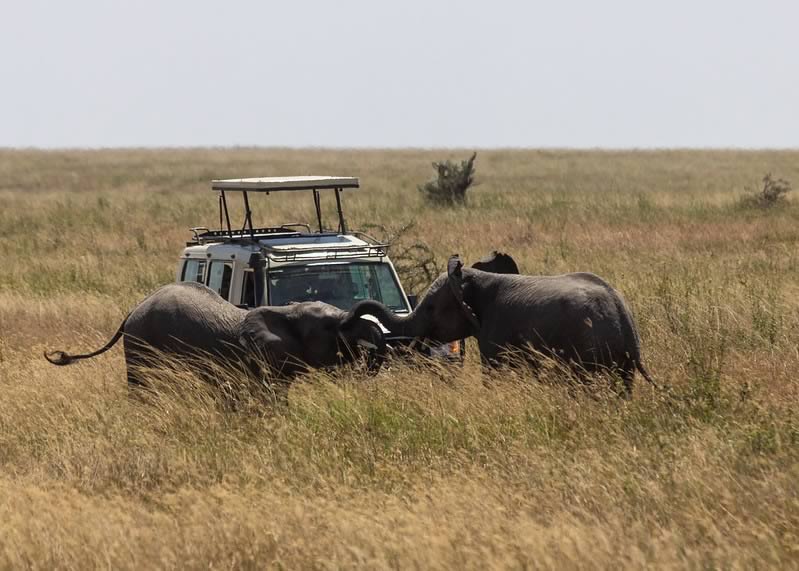
Kenya Explorer
L'Africa degli Animali
10 /giorni 7/notti
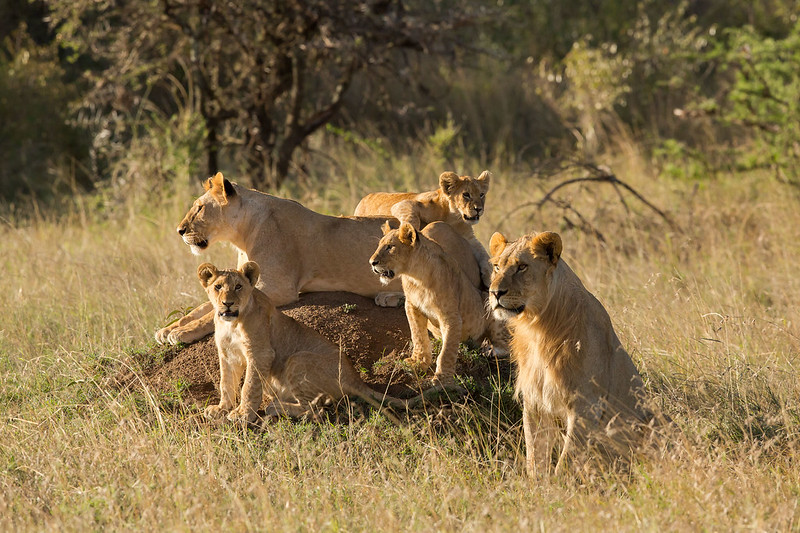
Safari Kenya - Dal Mara al mare
14 /giorni 11/notti
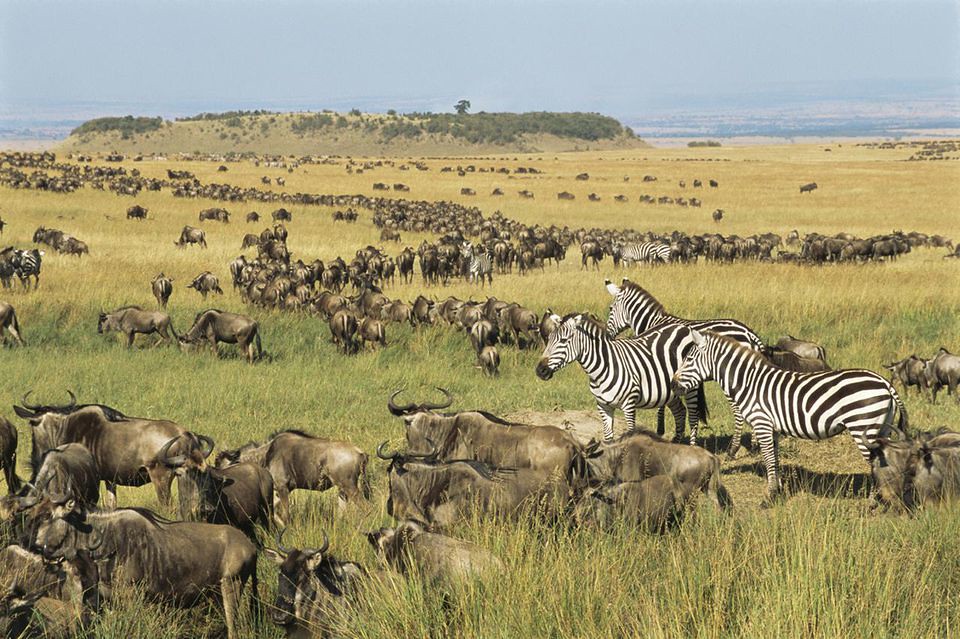
Kenya Smart - Safari e mare
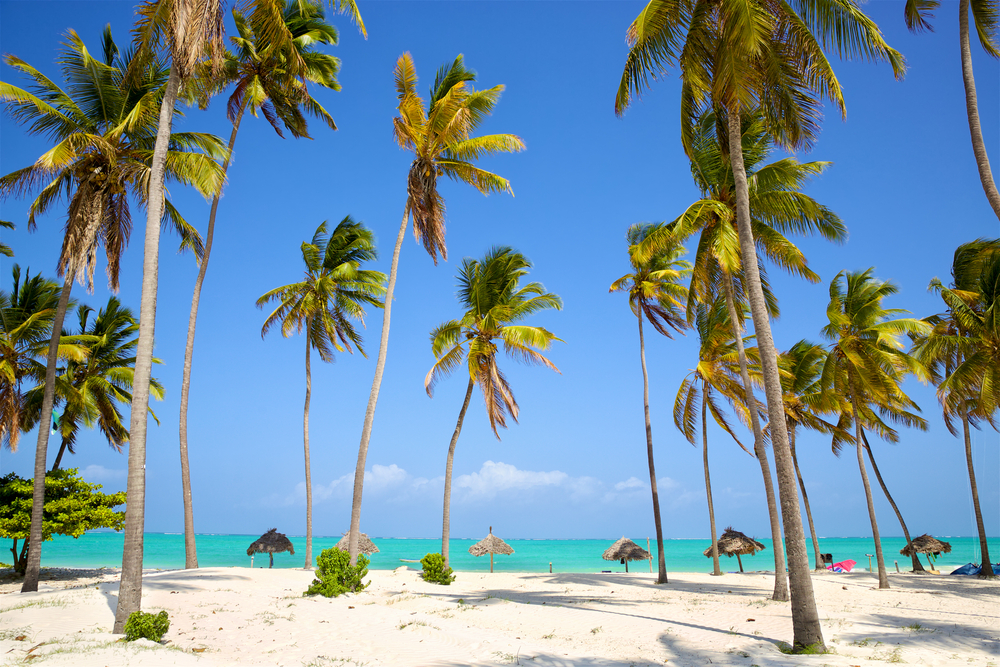
Kenya Explorer e mare
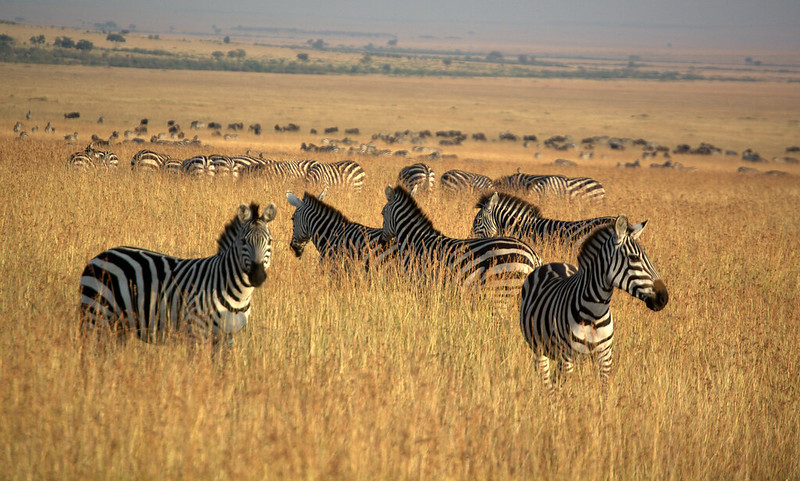
Kenya Unique - Flying Safari
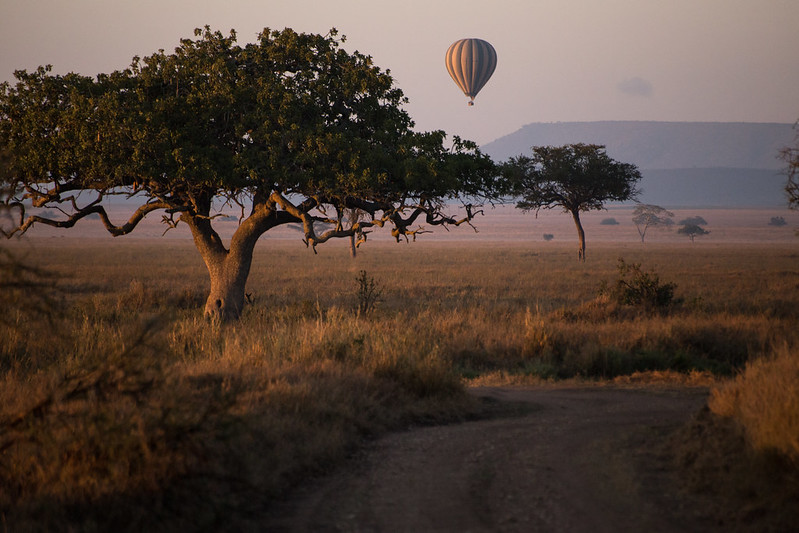
Kenya Romantic
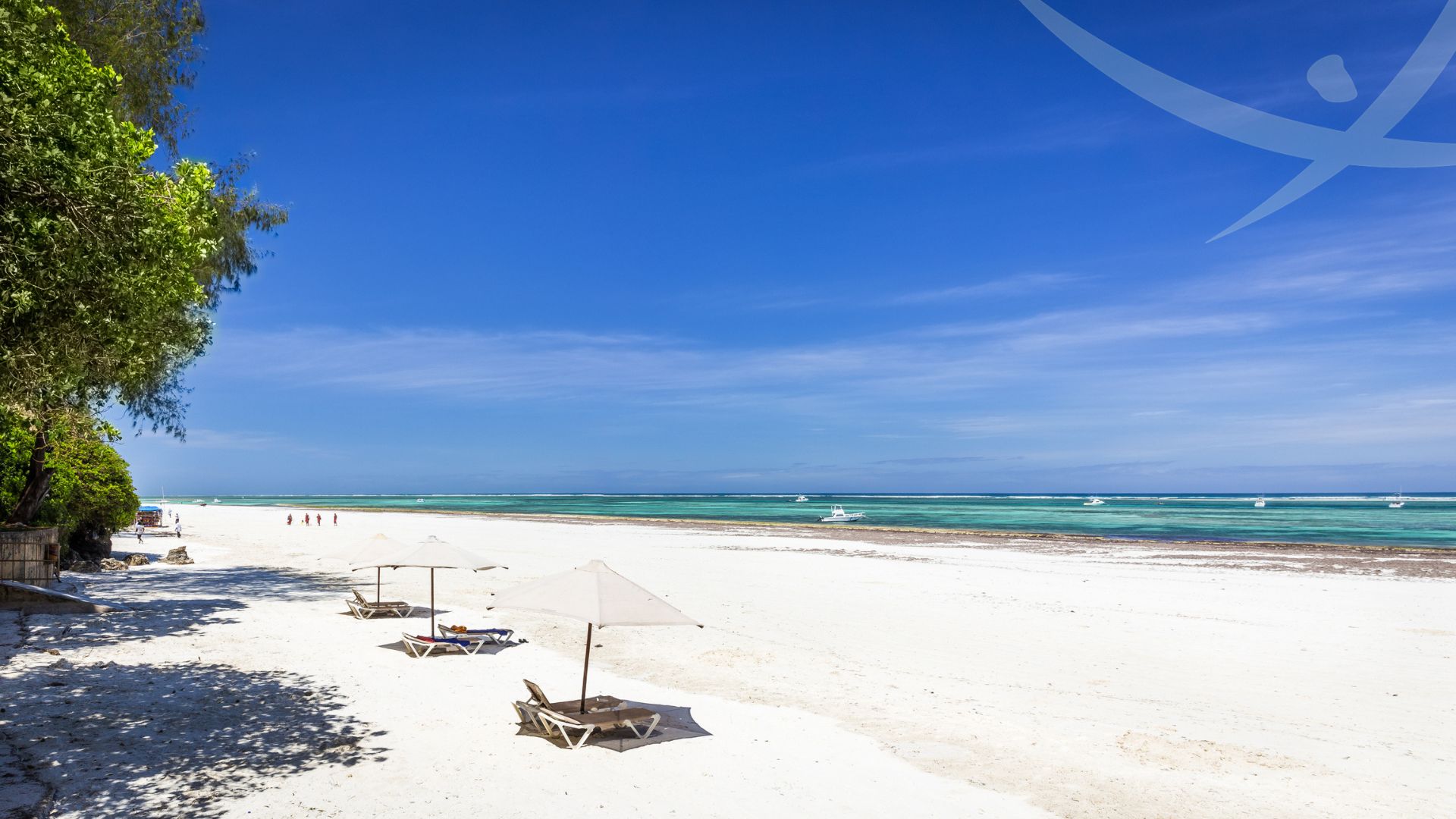
Kenya Smart - Tsavo e mare
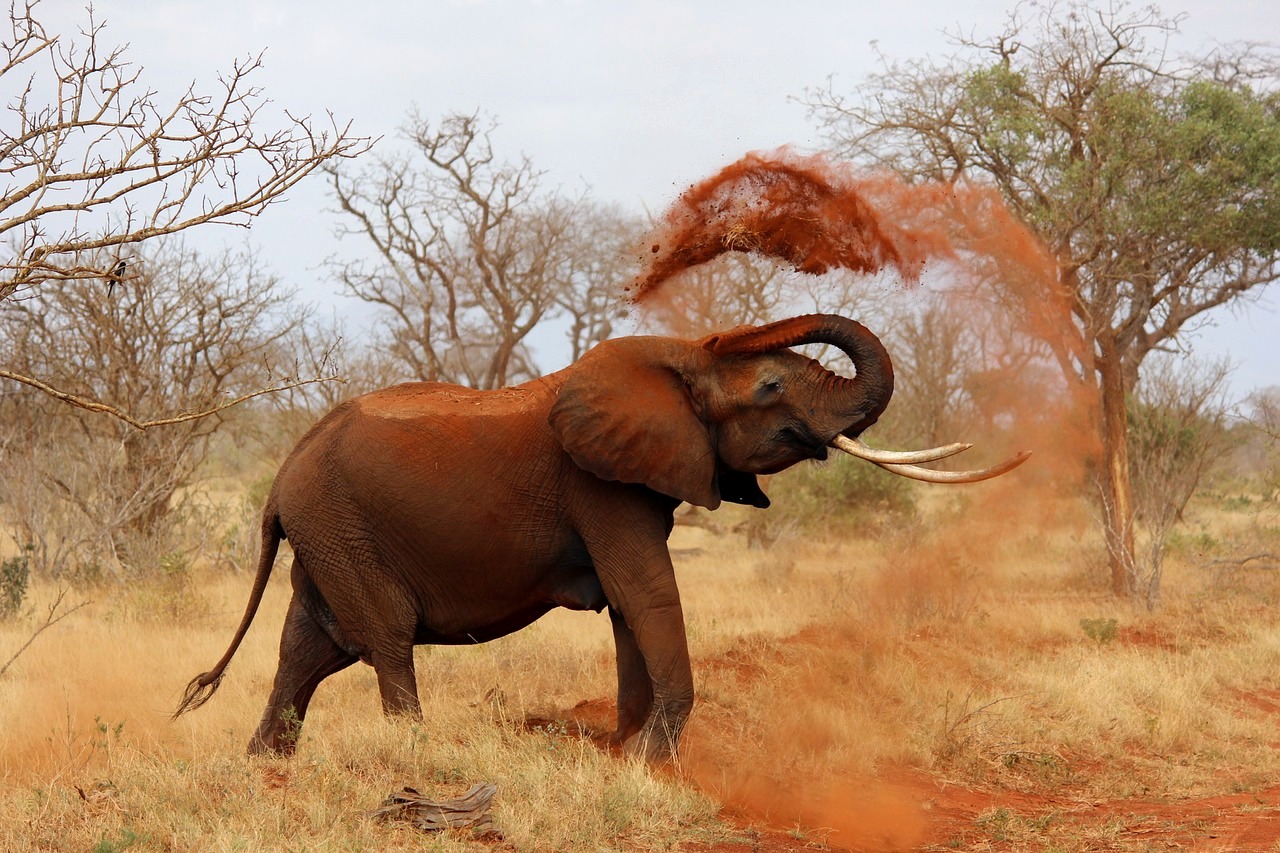
Kenya Smart Tsavo e mare - 5 Agosto
10 /giorni 8/notti
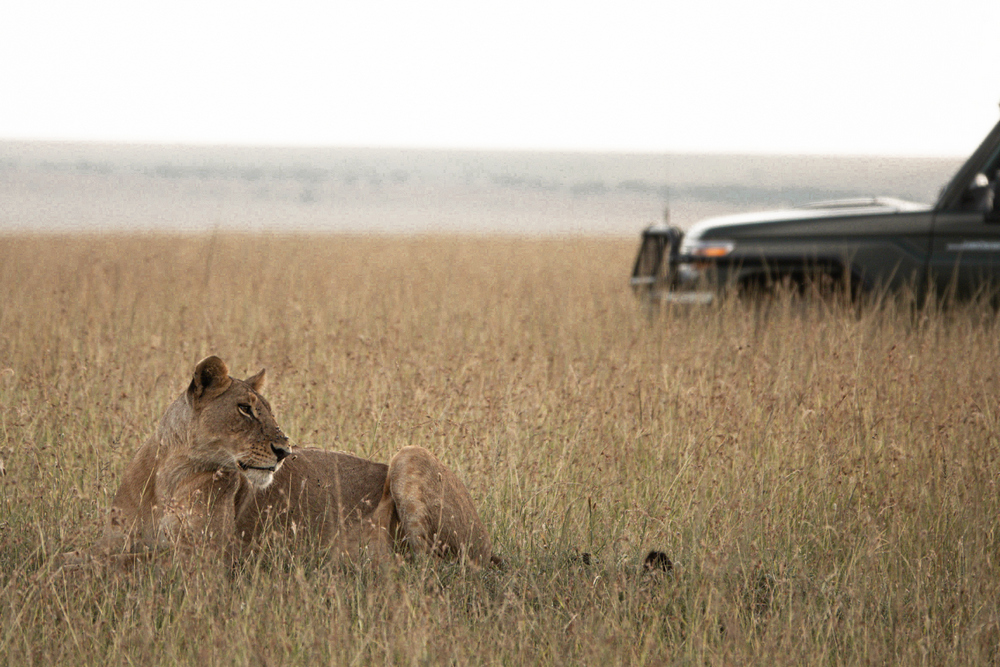
Kenya Explorer e mare - 4, 11, 18 Agosto
15 /giorni 13/notti
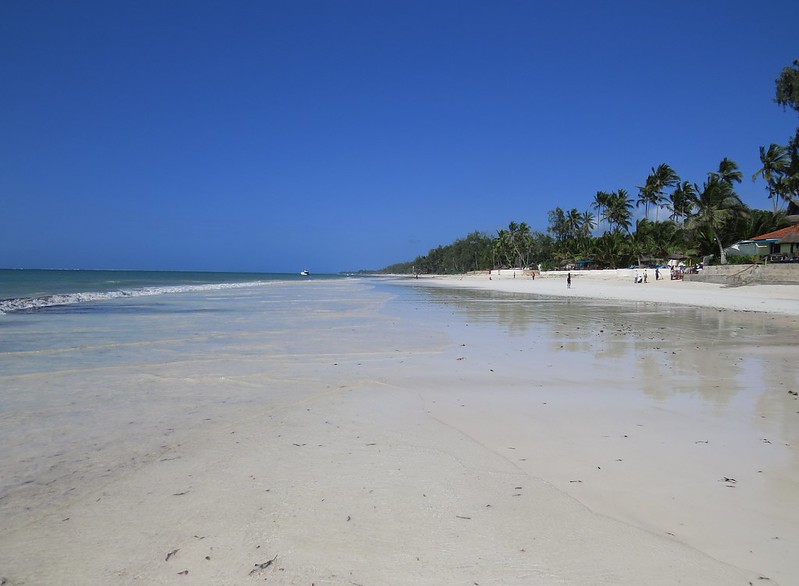
Kenya Smart Tsavo e mare - 13 Agosto
13 /giorni 10/notti
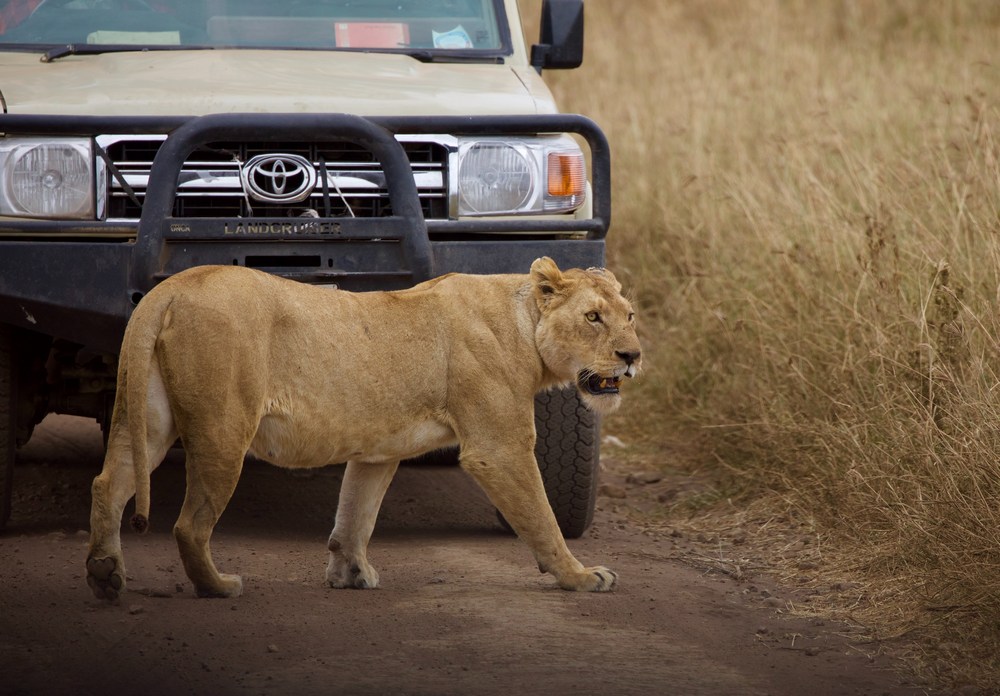
Kenya dal Mara al mare - 4, 11, 18 Agosto
15 /giorni 12/notti
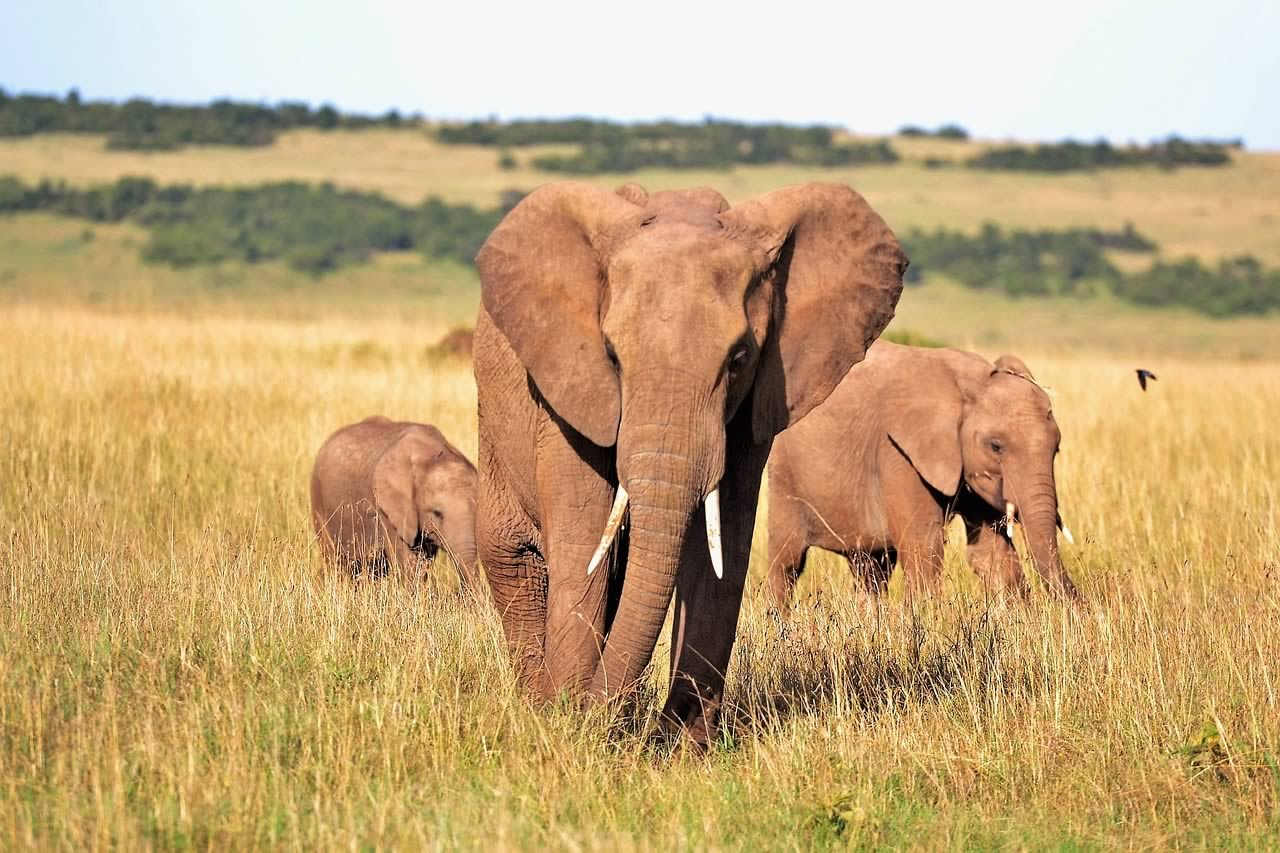
Kenya Explorer - 4, 11, 18 Agosto
Richiedi informazioni, informazioni kenya.
Alcuni consigli di viaggo utili per organizzare al meglio un viaggio in Kenya:
Qual è il periodo migliore per fare un viaggio in Kenya?
Il clima in Kenya può variare leggermente a seconda delle regioni che si intendono visitare. Ad esempio, la costa e le zone costiere come Mombasa e Diani Beach godono di un clima tropicale e possono essere visitate tutto l'anno. Più in generale, la stagione secca, da gennaio a marzo e da luglio a ottobre, è considerata la migliore stagione per visitare il Kenya. Durante questo periodo, il clima è secco e le temperature sono moderate. È un ottimo momento per i safari in quanto la vegetazione è più bassa e gli animali si concentrano attorno le fonti d'acqua.
Cosa rende un safari in Kenya così speciale?
Un safari in Kenya è considerato speciale per la sua varietà di fauna selvatica. Masai Mara, Amboseli, Tsavo, Samburu e Lake Nakuru sono solo alcune delle rinomate riserve che offrono la possibilità di avvistare i Big Five (leoni, elefanti, bufali, leopardi e rinoceronti) e altre specie animali. Il Masai Mara è particolarmente famoso per l'epica migrazione annuale degli gnu e delle zebre, considerata uno degli spettacoli naturali più incredibili al mondo. Il Kenya offre anche la possibilità di svolgere safari in mongolfiera per un'esperienza panoramica.
Quali sono i luoghi da non perdere in Kenya?
In Kenya, ci sono diversi luoghi che sono imperdibili durante un viaggio: la Riserva di Masai Mara è famosa per essere una delle migliori destinazioni al mondo per avvistare la Grande Migrazione. Il Parco Nazionale di Amboseli è famoso per la grande concentrazione di elefanti. Il Parco Nazionale di Tsavo, diviso in due sezioni, Tsavo Est e Tsavo Ovest, è uno dei parchi nazionali più grandi del Kenya. Il Lago Nakuru, alcalino nella Rift Valley, è famoso per la sua grande popolazione di fenicotteri rosa. Diani Beach e Watamu sono famose per le loro splendide spiagge di sabbia bianca e le barriere coralline.
Un viaggio in Kenya è adatto ad una famiglia con bambini?
Il Kenya offre diverse opportunità per coinvolgere i bambini e garantire un'esperienza piacevole e sicura: i safari nei parchi come il Masai Mara o il Parco Nazionale di Amboseli offrono la possibilità di avvistare la fauna selvatica da vicino e un’esperienza stimolante per i bambini. Molti lodge in Kenya offrono sistemazioni e servizi attrezzati per famiglie, con camere familiari, piscine, aree giochi e attività organizzate per i più piccoli. Inoltre, il Giraffe Centre a Nairobi è adatto per un incontro ravvicinato con le giraffe e il Parco Nazionale di Ol Pejeta per vedere i rinoceronti.
Quale soggiorno mare posso combinare con un safari in Kenya?
Fare un safari con una estensione mare è sicuramente una delle esperienze più complete che si possa fare. Ogni isola ha le sue peculiarità e straordinarietà, per questo nella scelta, ci sono diversi fattori da considerare, come gli interessi personali, il budget, la durata del viaggio e disponibilità. I resort più esclusivi di African Explorer sono a Mauritius, Seychelles, Maldive, Isola di Pemba e Isola di Mafia, Zanzibar e Réunion. Per questo, per pianificare attentamente l'itinerario, coordinare i voli e organizzare il trasferimento tra i due luoghi è sempre meglio rivolgersi ad un Tour Operator, esperto di viaggi qualificato.

- [email protected]
- +39 0232060101

How Much Does a Kenya Safari Cost? | How Much is a Safari in Kenya?

There is one thing about Kenya safaris , they are freaking awesome, and everybody wants in. But how much does a safari in Kenya cost? In this article, I will break down the average Kenya safari cost into 3 categories: Budget Kenya safari prices, Mid-luxury Kenya safari cost, and Luxury Kenya safari prices.
We will cover everything from transport costs to accommodation prices to ensure you get an idea of how much is a safari in kenya per person. In between, I will share interesting anecdotes of how to plan a tailor-made Kenya budget safari with our team of local safari experts. All were born and raised in Kenya.
How to Book Kenya Safari All Inclusive Packages
At Ajkenyasafaris.com, we have been tailor-making educational, memorable, and enriching Kenya safari packages for our guests for over 20 years. Instead of offering pre-arranged Kenya safari expeditions, which are restrictive in relation to what you can do or see in Kenya – we help travelers hand-craft their Kenya holiday to suit their travel plans and budget.
We start each holiday with a consultation, during which we answer all your questions about visiting Kenya. On our side, the meeting allows us to better understand your travel plan, budget, and list of things you want to do and see in Kenya.
Our experts then sit and hand-craft a perfectly orchestrated Kenya safari itinerary for you. Once we are sure we have the best holiday for you, we will share the itinerary for your initial review.
Don’t worry; if you still need anything changed, we will customize the holiday experience till it is as personalized as you are.
You can book your safari now by sending us an email at [email protected] or [email protected] . You can also call or WhatsApp us at +254-748-258-880 .
Our Most Booked, Most Affordable Kenya Safari Packages
How much does a kenya safari cost – the ultimate guide .
The cost of a safari in Kenya varies depending on the type and duration of the safari, as well as other factors such as accommodation costs, park entrance fees and the number of people in your group. Generally, safaris can range from about US$1000 for a short 2-day trip to several thousand dollars for a longer, more luxurious safari. Here we have looked at some of the factors that will help you answer the question of how much is a safari in Kenya ?
How Much is a Safari in Kenya Per Day? – Type of Safari
If you are looking to get away and go on the ultimate safari vacation, there are options for just about any budget.
Average Kenya Safari Cost for a Budget Trip
For as little as USD 180 – USD 250 dollars per day, you could be off to a budget safari in Kenya with zero compromises on quality and safety. This amount covers everything from transport costs to accommodation and everything in between. The budget does not cover international flights.
You will mostly be traveling in a small group of 4 people in a tour van with a raised roof for optimal game viewing. Your stay will be in 3 and 4-star safari lodges and hotels on a full-board basis.
The amount also covers destination entrance fees and everything else essential for a successful safari in Kenya. Luxury drinks, tips, and items of personal nature such as airtime are excluded from the budget Kenya safari package prices .
Most camping safaris , self-drive safaris, beach holidays packages, and Kenya group tours fall within this budget. Budget Kenya safaris work well for the adventurous at heart. We do not recommend budget vacation packages for families traveling with Kids or Honeymooners.
Average Mid-Range Kenya Safari Packages Cost
If budget safaris do not make the cut for you, mid-budget Kenya wildlife safari packages are a great option. They are the most popular option, largely because they offer the best value for money.
Here you are looking at spending about USD 300 to USD 500 per person daily. We recommend this option for honeymooners, seniors, and family travelers . Within this budget, you are looking at a private safari with exclusive use of a safari land cruiser with a pop-up roof for easy spotting of the Kenyan wildlife and scenery.
Your accommodation will be in 4 stars and 5-star hotels and safari lodges.
Average Cost of Luxury Kenya Safaris
You only get to live once. So, having a luxurious Kenya safari (at least) once in your life is a great idea. As imagined, luxury comes with hefty price tags that range anywhere above USD 600 per person/day.
It’s a large figure, but here you are looking at a luxury at its best.
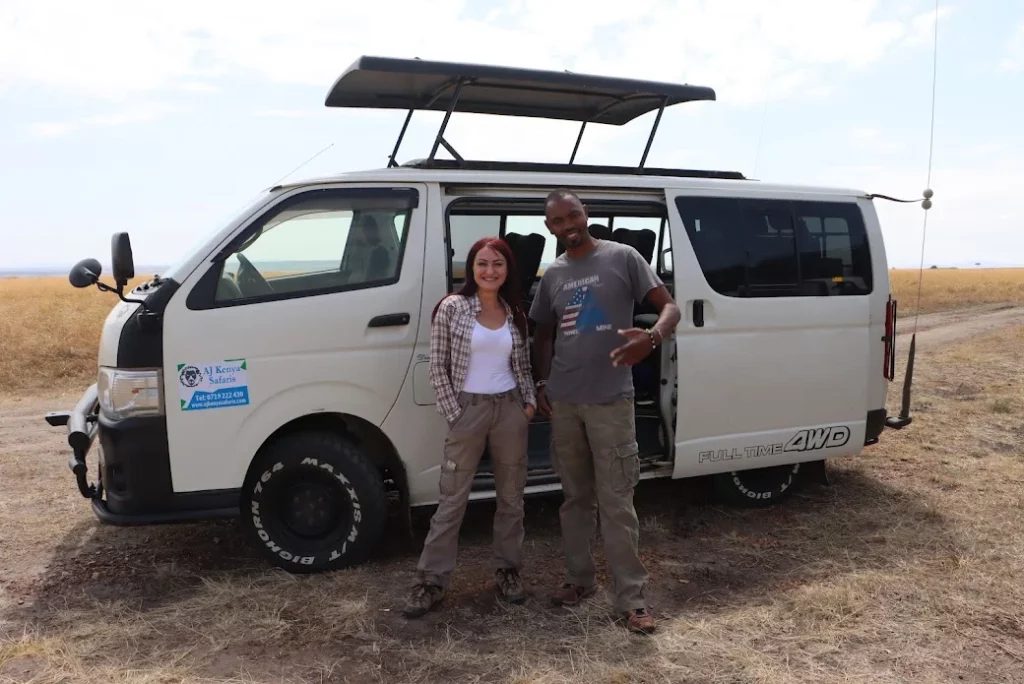
Kenya Safari Tours from Nairobi Cost – Accommodation
At the end of a busy day in the Kenyan Savannahs, you want to retire to a hotel that offers great amenities. These ranges from sumptuous meals, endless opportunities to connect with the local people, and top-of-the-line amenities such as free Wi-Fi, a swimming pool, and more.
So, here are the safari accommodation options available in our country.
Five-Star Hotels
The rooms go for anywhere between USD 500 and USD 1000 per night. But you can pay extra for additional space and luxurious amenities. This option is the closest you can get to world-class luxury. Our luxury Kenya safari packages offer accommodation in five-star hotels.
Four-Star Hotels
A room costs between USD 100 and USD 200 per night. That covers the bed and breakfast while the rest is on you. Expect nothing but decent services and facilities in these hotels.
Three-Star Hotels
The most affordable hotels in Kenya are pretty ragged, but they can go as low as USD 50 per night. You will get the basic amenities, a bed, and (hopefully) breakfast for the price.
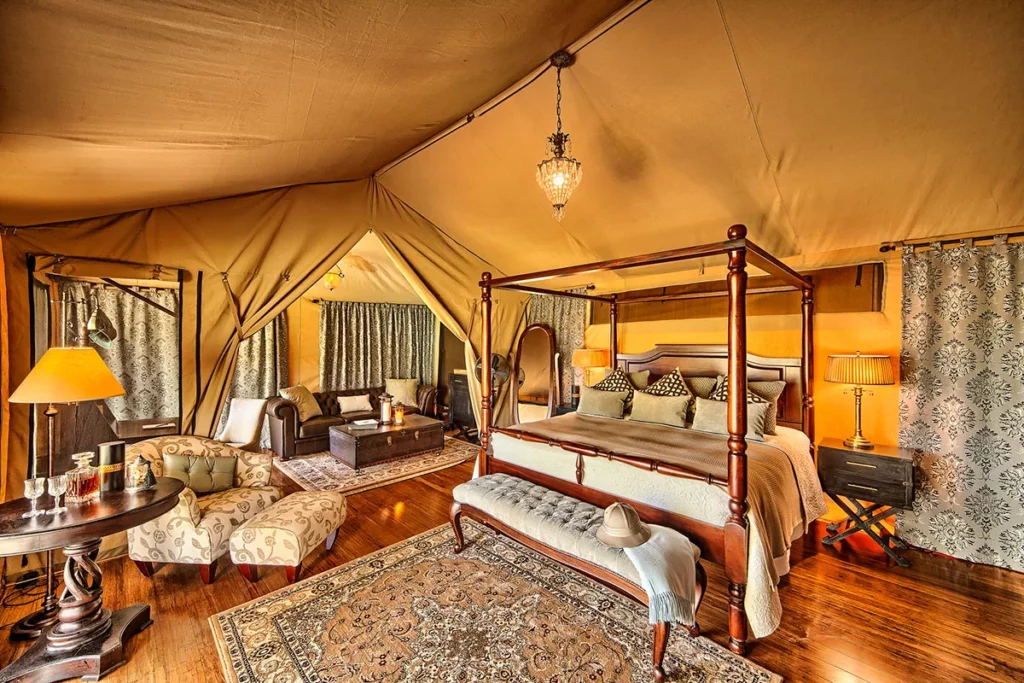
How Much Does a Kenya Safari Cost? – Cost of Meals
This part is where it gets exciting, considering that there are so many options. And everybody wants to eat at the end of the day. Shall we?
5 Star and 4 Star Hotels
A decent meal in these hotels cost around USD 20 to USD 200. These hotels offer the perfect mix of comfort, satisfaction, and value for money. Hotels in this category share what’s on the menu at a great time, and if you choose to, the cooks will gladly prepare a meal of your choice.
The staff is multilingual, and the menu includes both local and international cuisines.
Food Courts
Here, you can enjoy well-cooked meals for USD 5 – USD 20 per dish. For example, a meal at Burger Hut Nairobi will go for around USD 4.5. Kenchic Inn, a famous fast food joint, will charge you roughly USD 5 per dish. But the idea here is, fast food is way cheaper than good stuff.
Street Meals
Street food – usually a plate of rice or ugali with beans, vegetables, and sometimes a piece of meat – costs USD 5- USD 15. They are not quality meals, and the setting is also not so attractive. But Kenyans eat that all the time. We do not recommend this option for family travelers.
Cost of Drinking Out
A 500 ml bottle of beer costs between USD 1.2- USD 3, depending on the brand. But some joints sell them at USD 10 per bottle. Tusker is the flagship Kenyan Beer. Other options include the world-famous Guinness, Smirnoff, Jameson, and more.
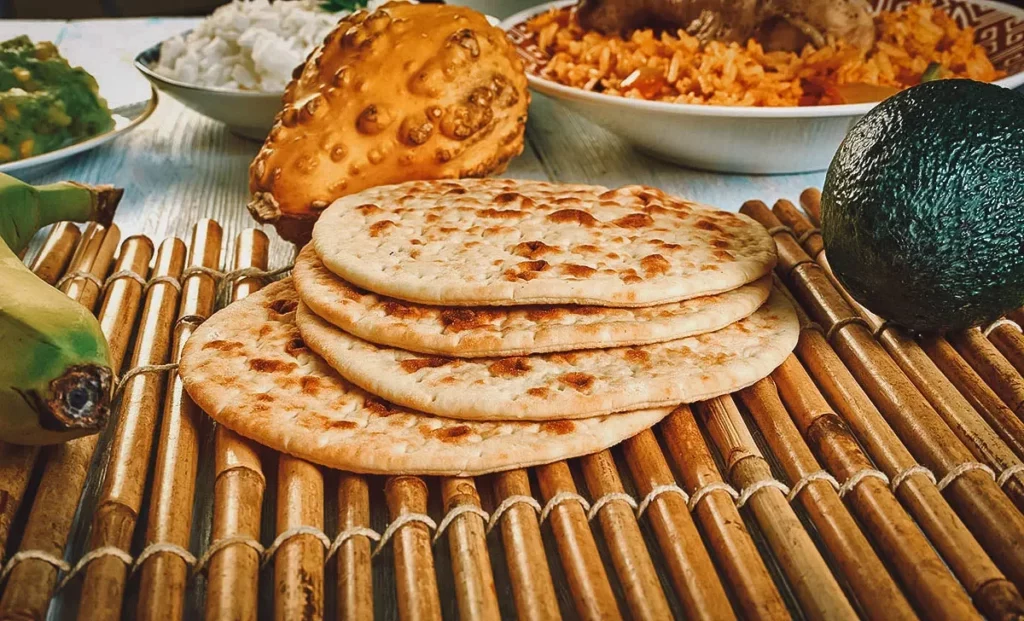
Masai Mara Kenya Safari Cost – Transport
Moving to Kenya has never been an issue. Some of the options here are super cheap and will still get you across the country.
Matatus (Public Service Vehicles)
Matatus (vans) are the most economical way of getting from one point to another in Kenya . Thanks to fluctuating fuel prices and other factors, the cost varies from time to time.
For example, a ride from Nairobi to Naivasha costs USD 5 on a normal day . But the price may go as high as USD 10 or more during peak hours. We do not recommend this option for international explorers.
Taxi & Uber
Most taxis in Kenya don’t have meters. So, it is wise to negotiate and agree on the cost before boarding. Alternatively, use premium taxis service providers such as Uber , Delight cabs, or Pewin Cabs.
Domestic Flights
Flying is the most expensive means of transport in Kenya, also the safest and the fastest. There are some attractive deals to be enjoyed on airlines, such as Fly 540, which charges around USD 70 for a one-way trip (Nairobi and Mombasa).
Jambo Jet, another local airline, charges as low as USD 30 for a one-way trip between Nairobi and Malindi . You will also get a cheap flight to Masai Mara from around USD 150 one way from operators such as Mombasa Air Safari.
Train services run from Nairobi to Mombasa, and plans are underway to take it further. The cheapest fare for Nairobi to Mombasa is USD 10 for the second class, while first-class costs USD 30.
Buses are usually in the range of USD 1 per hour. A bus ride to Mombasa from Nairobi will cost you anything between USD 7 – USD 15.
Safari Vehicles
Safari vehicles are modified and customized to make your African safari experience the most memorable one. The vehicles have been designed with the latest safety features and are equipped with enough space to accommodate all passengers.
In addition, they feature a small fridge and cooler for drinks and snacks to ensure you don’t go hungry or thirsty during your safari. They also provide comfortable seating and sun shades to help you relax in the hot African sun while enjoying the sights of Africa bush land.
You can get a safari vehicle with a professional tour guide from as low as USD 160 per day for the van and USD 250 per day for the safari land cruiser. These are the recommended vehicles for tourists.
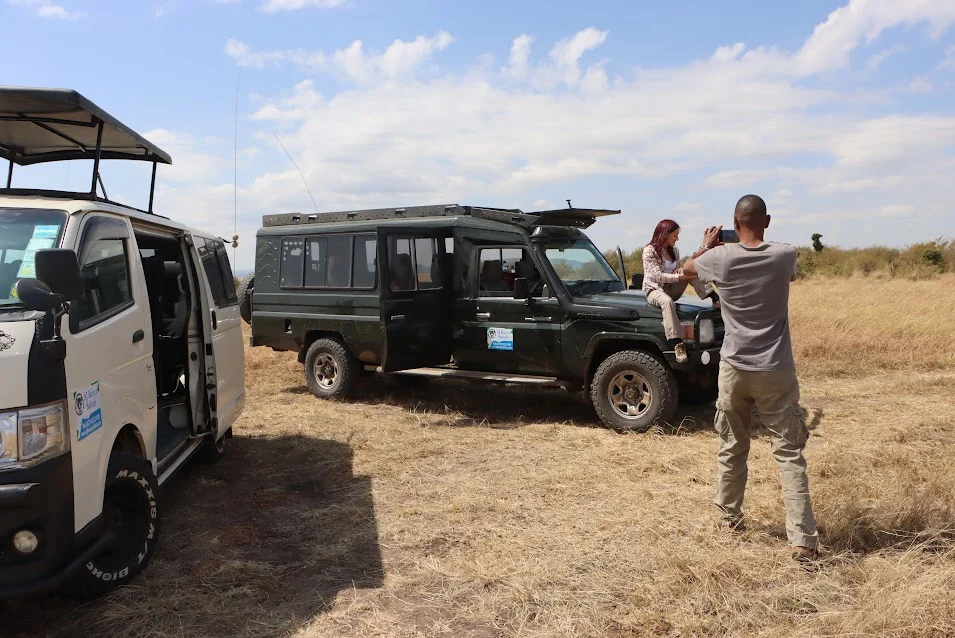
Where to Do Safari in Kenya Cost – National Reserve and Park Entrance Fees
Most parks are excellent choices for Kenya Budget Safaris . The entry fees depend on the season you visit and whether it is owned by the government or community. The cost can vary from as low as USD 20 for places such as Nairobi Safari Walk to as high as USD 110 for Ol Pejeta Conservancy.
Safari in Nairobi Kenya – 8 Things You Should Know for Budget Safari
When it comes to booking a holiday in Kenya, the safari capital of the world, the total Kenya safari cost is a must consider factor, and it is sometimes more than what meets the eye. Yes, we have seen it all. A USD 200/day safari that’s costlier than a USD 400/day safari, and USD 800/day cheaper than a USD 400 per day Kenya tour – when you consider the finer details.
Foreigners who want to book a holiday in Kenya are often overwhelmed by the sheer variety of Kenya safari packages on offer. I mean, if you scroll the web, you will see a 3 days Kenya safari package for USD 400 per person sharing, a 3 days Kenya Holiday package for USD 800 per person sharing, and so on.
My point here, the number of days you will stay in Kenya remains the same (3 days) in both offers, but the Kenya safari cost of one package is double that of the other. So, which package is cheaper?
Tight Budget? Here Are Some Saving Tips
- Find a group – Traveling alone can be quite boring and expensive. Opting for a group Kenya safari makes the trip fun. Also, it translates to shared traveling expenses. Everybody wants to save a few bucks.
- Book in advance – It might be tempting to think that planning on the go is more exciting than making prior arrangements. But on the contrary, it is more expensive. Consider finding a tour operator to help you make reservations in Advance.
- Is it Low Season or High Season? – Traveling to Kenya during the low season might seem economical – but it’s not. There is a big chance that you will miss the migrating wildlife and the excitement that comes with crowds. So, the best time is probably when the season is still young. Think of early July.
- Don’t Spend Nights in the Park – Ideally, prices in camps and hotels inside the national parks are exorbitant. You will pay at least 2-day worth of entrance fees even if you don’t intend to drive around the next day. Luckily, there are decent options close to all parks in Kenya.
- Consider Camping – Some parks provide travelers with the option to pitch tents in a designated area within the park. This option will save you tons of cash and bring you closer to the animals. Hell’s Gate National Park is an excellent example of such a place.
- Eat at the Driver’s Shop – It is obvious the hotel staff and safari drivers do not dine in those high-end hotels. So ask around, and you might get delicious meals at surprisingly low prices.
- Carry Packed Drinks/Food – Drinks and food are often overpriced, especially in those off-grid destinations. However, some safari packages might cover meals, but the surest way to save money is carrying your own food.
- Consider Traveling the Unbeaten Path – The not-so-popular parks will charge you less, yet you will see almost all of the wildlife found in the other parks. They are also smaller, so you might have an easier time spotting wild animals.
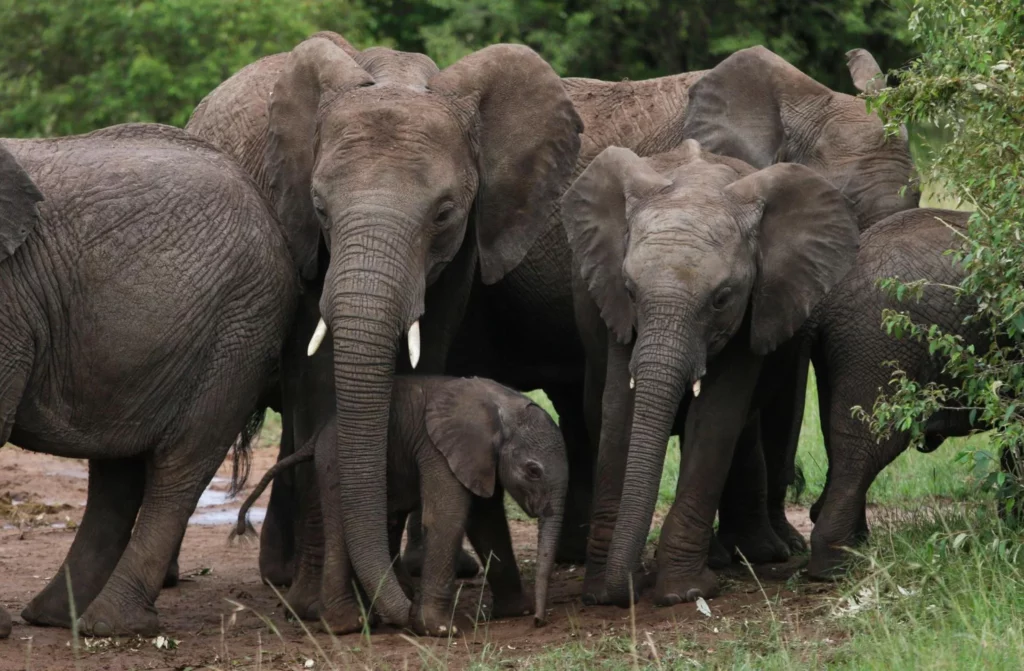
FAQs of How Much Does a Kenya Safari Cost?
To help you make an informed choice, let’s share 10 questions you need to ask your Kenya tour operator before buying the package .
1. What’s included in the Kenya safari package Cost?
Safari’s holidays in Kenya come in all shapes and sizes. You can go for budget Kenya safaris , including the bare minimum facilities, and you can also choose ultra-luxurious safari packages.
To make better sense of what you are paying for, it’s wise to ask about the components of the safari package. The standard definition of “all-inclusive” means the packages cover accommodation, food, transfers, park fees, and safari vehicles.
However, don’t assume that all that is included. Call your tour Kenya tour operator and make sure these costs are indeed included for the entire stay. For example, if food is covered, ask exactly which types of food are covered.
Some packages are labeled ‘all-inclusive,” but you are only covered for meals taken within the lodge, and you are expected to pay for alcoholic beverages and anything else you take while on the go.
Another trick used to hike the cost of a package is including airport transfers, while actually, no air safaris or transfers are involved. So, if that is an item in your package, ask where you will board the safari from and to where?
2. How much of the park can be accessed?
You need to clearly ask out the bounds of the park and the restrictions that come with it. Many budget safaris during your holiday in Kenya will give you a short car tour of the park and then drive you outside the park into some nearby hotel.
This would be unfortunate as you won’t be able to experience the quintessential safari ambiance that intensifies during dawn and dusk. However, if you are planning to buy a luxury package, you don’t need to worry about these restrictions.
Luxury travelers are often rewarded with the best camps and unlimited drive times inside the park, but it is always wise to confirm with your Kenya tour company.
3. Kenya Safari Cost – Will you be sharing the safari with strangers?
The most common problem associated with budget Kenya safari packages is that they tend to cram people of different backgrounds into the same trip. This can mean a disparate age-group or someone who doesn’t even speak your language.
Ask the tour agent to clarify how many people you will be traveling with and, if possible, prefer solo, personalized trips. Luxury safaris won’t pair you with strangers, and you can enjoy the freedom to explore the safari experience the way you like, instead of being dictated by the needs of others.
4. Who dictates the safari pace and objectives?
You will have to follow the crowd and routine of the safari experience in a budget safari. The biggest disadvantage of being in a budget group is that you won’t have much voice over the itinerary.
You can’t stay longer at a particular spot if you wish, and worse, you can return earlier if you wish. This is important because prolonged exposure to the equatorial sun can make foreigners uncomfortable. Inquire about such provisions and the full itinerary of the trip in detail.
A private safari with us lets you dictate your trip’s speed and is flexible to your needs. You can focus on any wildlife you want for as long as you want. Your needs won’t be bogged down by others.
5. How knowledgeable are the safari guides?
Budget safaris advertise their tours with over-the-top descriptions and then fail to deliver on a good local guide. This is also a problem with most international travel companies promising to bring you on tour to Africa.
A good guide will have a profound knowledge of various animals and bird species and instinctive knowledge of the behavior of animals, their feeding habits, their trials, and more.
They are also trained to spot distant birds and camouflaged animals. Training separates a lot of good guides from the bad ones, and you should ask for any certifications or government registrations if available.
6. How well equipped is the safari vehicle?
Safari Vehicles have a great deal of variety and are priced according to the facilities they provide. From mini-vans to rugged land cruisers to open hatchbacks, you can choose the vehicle that suits your style and budget.
In luxury packages, you can find air-conditioned vehicles with large recliner seats and even in-house refrigerators serving your favorite drinks. A budget safari will give you a seat and a window to look out at.
The minimum you should expect from the vehicle is to have proper cushions, proper mechanics, and proper communication types of equipment like CB radios, which are used to hone in on any major hunt or wildlife activity in the park.
It’s also necessary to carry safety equipment like first-aid boxes and tranquilizer guns in case of emergency situations.
7. How many souvenir shops will you be forced into?
The biggest problem with budget safari operators is that they survive off commissions rather than on their actual job of guiding – and this influences your Kenya safari cost. In this pursuit of cheap commissions on souvenir sales, the tour operators tend to take the tourists to pre-fixed shops, where the prices are automatically inflated.
The tour operators generally get a 10% cut on every purchase you make at their shop. Even worse, sometimes you can be tricked into buying cheap Chinese products. On the other hand, proper tourism agencies will ask you if you wish to buy souvenirs and then only take you to authentic places, where you can get better products and help the local community with their handicrafts.
8. What are the provisions for special interests?
Budget safaris are notorious for their apathy, and this can ruin your entire holiday in Kenya. If your expectations are low and you need a pretty generic ride of the savannah, then you can be satisfied with the budget safari packages.
However, if you wish to partake in additional activities like bird-watching, extra exploring, wildlife photography, small picnics, etc., then it’s best to inform your tour operator beforehand. Budget safari operators are strict on time and can disappoint you with their hastiness if you don’t inquire before.
So, make sure to inquire with your agency and know exactly what your Kenya safari cost covers. Alternatively, half the Kenya tour companies do all the essential bookings for you and opt for self-drive Kenya safaris. Luxury safaris are more personalized, and you can customize each of your activities according to your needs.
9. When to go on a Kenya safari?
Safari experiences depend on the weather, and so does the price. If you find yourself on holiday in Kenya in the rainy season, you can possibly ask for a lower price since the markets are low during that time.
March to May is the rainy season in Kenya, where you can get lower prices on most safaris and expect thinner crowds. When the safaris are booked to the brim and prices are sky-high, the equation changes during the winter.
10. Is the safari driver familiar with the English language?
On most safari trips, the driver will be your guide, and you should make sure that he can speak English to a communicable degree. Having a common language will give you a better perspective of their native culture and heritage.
We are travel. We are local. We are your wildest safari expectations fulfilled. We show you Kenya better than anyone.
Itineraries
- 3 Days in Masai Mara
- 4 Days Masai Mara
- 18 days Kenya Family safari
- 18 Days Kenya Safari
- 16 days kenya safari
- Diani Beach
- Amboseli Park
- Booking Terms and Conditions
More guides
- Mombasa beach
- Kenya Safari
- Kenya Photo safari
- Kenya wildlife safari
- Kenya Adventure
- Kenya Migration Safari
- Honeymoon Packages
- Kenya, Kiambu County, Ruiru Town Greec Towers, Office Number D7 and D8
- +254-704-532-105
- [email protected]
✓ Great customer reviews
✓ world class safari guides, ✓ great service, great pricing, safari kenya cost: not so bad after all.
It’s on the bucket list of many – going on safari in Kenya! Unfortunately, a safari has been known as an expensive trip and more of a thing to do when retired. But is that really true? What does a safari Kenya cost actually ? And shouldn’t more people than just retirees be able to go on such adventurous outings?
Safari Kenya cost
We, from Africa Safari, offer private trips and safaris in different price categories. This is to make it possible for many people to make their dream of going on a safari in Africa a reality. Because where do you really find such a huge territory of untamed nature with so many magnificent wild animals to admire? We believe that this is something you, as a newlywed couple would love to enjoy. Or maybe it’s something you would want your children to experience. Or just something you have been wanting to check off of your bucket list for years!
We offer beautiful excursions and safaris to Kenya in three price categories: Gold, Platinum and Diamond. Gold is the most affordable, but it is most definitely not a backpacker’s vacation. To give you an idea, here is what the average cost would be for a 5-day safari to Kenya for two people:
Low season*
Gold: 1990 euros Platinum: 2450 euros Diamond: 2900 euros
High season*
Gold: 2790 euros Platinum: 3360 euros Diamond: 4650 euros
The cost of a safari in Kenya will consist of a few elements: transportation, hotels and the entry fees for the parks. If you wish, you could add excursions to that as well. But keep in mind that international plane tickets are never included in the booking of a safari. You always pay for your own international plane ticket and visa. And, as you can see above, the prices for both the safari booking and plane ticket will depend on the time of season you choose to travel.
Cost of transportation in Kenya
Transportation per day for 2 people* 140 euros per person
Transportation per day for 4 people* 70 euros per person
Transportation per day for 6 people* 47 euros per person
Another way of cranking down the price quite a notch is when you choose to share the vehicle with other people. We do not organize group safaris. But when you book your journey, you can always consider gathering some more people to join your safari in Kenya. Even if you had a romantic safari for just the two of you in mind, why not triple that romance by adding two more couples on the trip? Keep in mind that there is only space for seven people in the vehicle. So if you are booking for a family that would exceed the maximum capacity for one vehicle, think of adding some more friends or family members. You fill a second vehicle and bring down the price in that way. More people get to enjoy a safari in Kenya and the price is acceptable. It’s a win-win situation!
Entry fees for national parks
Those who choose to go on an adventurous vacation and who opt for a safari will always have to pay for the fees of national parks. You can’t go around it and it’s unfortunately not cheap either. Each park will have its own rates for entry fees and if you decide to spend the night at the park, there will be extra costs as well. Though these prices are inevitable, it is also very reasonable seeing that this will keep the amount of visitors regulated. It also covers the maintenance of the park, the car and the tour guide.
If you therefore wish to go on safari in Kenya, but don’t want to burn your pockets on the park fees, you can then consider picking just one park that’s a bit more expensive or maybe two parks that are a bit cheaper. Either way – you can still bet on having the experience of a lifetime…! See below to have an idea of the entry fees per park:
Masai Mara National Reserve* 240 euros per person + 25 euros for the car with a guide
Lake Nakuru National Park* 93 euros per person
Amboseli National Park* 93 euros per person + 22 euros for the car with guide
Safari Kenya cost: hotels and meals
Whoever goes on safari in Kenya with us, will book their safari based on full board. This means that all meals are included in your journey and the price of your safari. Keep in mind that drinks such as tea and coffee are generally included with the meals, but other beverages will be at your own expense. Most people choose to stay in the same category of hotels for the entire trip, but if you like to spend some time in a more luxurious hotel in between, that is possible too. To give you an idea of the average prices (with full board, low season), see below:
Golden hotel* 180 – 300 euros, per two-person bedroom
Platinum hotel* 250 – 600 euros, per two-person bedroom
Diamond hotel* over 500 euros, per two-person bedroom
Golden hotels are still great choices because you still have everything you need. You’ll have a decent and well-equipped room, a nice restaurant and oftentimes a pool or beautiful scenery to enjoy. Platinum hotels will not differ that much, other than a more luxurious décor and amenities. The bar will have a greater assortment and the buffet will most likely have much more variety.
Our Diamond hotels are even more luxurious – nothing has been spared on that! These hotels are in the most beautiful locations, the restaurants often serve a la carte and the rooms are equipped with the most comfortable beds and lush décor. The bathrooms will either have an outdoor shower in the midst of Masai Mara or a bathtub with an amazing view.
As for Gold, Zebra Plains Masai Mara is a great example and in the Platinum category, you can think of Kilaguni Serena Safari Lodge in Tsavo West National Park. As for our Diamond category, the Elephant Bedroom Camp in Samburu National Reserve will give you a beautiful example.
What are the cost of excursions?
Plane tickets.
The price of a safari in Kenya will obviously also depend on the actual travel to Kenya. And plane tickets are not cheap, especially during the high season. So those who would like to save on their budget should not be travelling in July, August or December. The other months are usually of the same (and a lower) price range. When favour is on your side, you might find a super cheap ticket, although you will most likely have a layover. If you prefer a direct flight, that also automatically means that you will be paying more. In the case of travelling from Europe, you could find those cheap tickets with layovers for as little as 500 euros. And direct flights (with KLM for example) will be between 600 and 900 in the low season and between 900 and 1400 in the high season.
The seasons
We have already mentioned it before, but the cost of a safari in Kenya is very much linked to the seasons. The high season in Kenya starts at the beginning of June and will run to mid-September. It will kick back again around mid-December until mid-January. This will correlate with the European vacations and holidays (December). At the same time, July, August and September are the months that the Great Migration will run through the Masai Mara and are therefore popular months to visit Kenya. And that will also drive the prices up.
However, even though the prices of plane tickets and hotel stays are much higher in the high season – the entry fees and the cost of transport will remain the same.
Safari Kenya cost: conclusion
We will not deny it: Going on safari in Kenya or in any other East African country is fantastic, but not cheap. But whoever has saved up for a sunny day and has booked smartly, will be able to experience an amazing safari for a reasonable price. Pay attention to the season (high season or low season), and consider how many people you wish to include in your booking and in what hotels you prefer to stay in. In the end, the Kenya safari cost might just surprise you. Have a look at our travel itineraries and the corresponding prices per category to see which safari will fit within your budget!
*Please note that the prices above are indications and cannot be used to correct the price of a proposal. All prices on our website are subject to change, as they are continuously influenced by things like varying exchange rates and sudden changes in government regulations.
Request tailor-made travel proposal
Give us all your personal wishes and we will take care of the rest
10-day Kenya and beach: Go South and Swim – Golden
Masai Mara – Lake Naivasha – Amboseli – Diani Beach
(incl. domestic flight or train ride)
14-day Kenya: Grand Slam of Game Drives – Golden
Ol’ Pejeta + Samburu + Solio Game Reserve + Lake Nakuru + Masai Mara + Lake Naivasha + Amboseli + Tsavo West + Tsavo East
Combination with Diani Beach possible.
10-day Kenya: The Complete Package – Golden
Ol’ Pejeta + Samburu + Solio Game Reserve + Lake Nakuru + Lake Naivasha + Masai Mara
Combination with Diani Beach possible
7-day Kenya: Go South – Golden
Masai Mara – Lake Naivasha – Amboseli
Sign up for our newsletter
Top destinations.
- Masai Mara National Reserve
- Diani Beach
- Amboseli National Park
- Tsavo West National Park
- Tsavo East National Park
- Lake Nakuru
- Lake Naivasha
Travel information
- Kenya Travel Advice
- Kenya’s climate
- Things to do in Kenya
- When to visit Kenya?
- Flying Doctors Services
- Responsible Travel
- About Africa Safari Trips
- Privacy policy
- Terms and conditions
Tripadvisor
Google reviews, let's get planning your private safari.
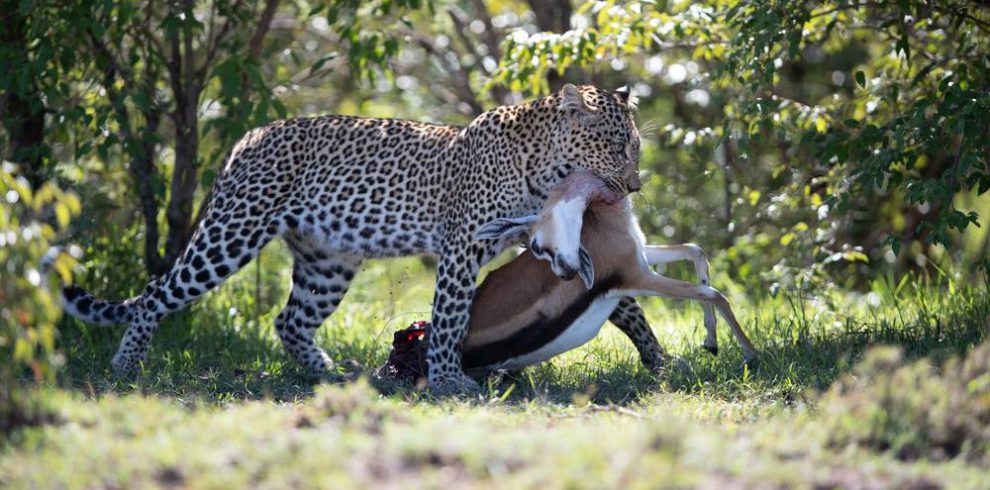
Kenya Classic Safari
- Description
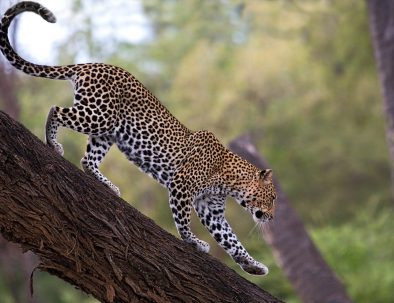
Kenya Classic Safari. This safari takes you to the best wildlife viewing areas in Kenya. The safari starts off in Samburu Game Reserve which is home to wildlife species that can only be found here including the Grevy Zebra, Somali Ostrich, Reticulated Giraffe, Gerenuk, and the Beisa Oryx. These animals can’t be seen in the other big parks making Samburu special. You will head to Olpejeta Conservancy right at the Equator! Here, you have a chance to see Chimpanzees and the endangered Northern White Rhinos with the 2 remaining rhinos hosted here. Head on to Kenya’s pink lake, Lake Nakuru National Park. Though famous for its flamingo population, Lake Nakuru is also home to species like the black and white rhinos and the endangered Rothschild Giraffes. Crown off your safari in Masai Mara National Reserve where wildlife roams all over the savannah and makes a fitting end to your Kenya Classic Safari.
Upon arrival at J.K.I Airport, you will be met by an Explorer Kenya guide who will transfer you from the airport to your Nairobi hotel. Overnight at the Hilton Garden Inn.
Pick up at 7:00 AM after an early breakfast and proceed to the Northern frontier district via Isiolo to Samburu National Reserve. Arrive in time for lunch at the Lodge. Late afternoon game viewing drives. The reserve is rich in wildlife with fame for an abundance of rare northern specialist species such as the Grevy Zebra, Somali Ostrich, Reticulated Giraffe, Gerenuk, and the Beisa Oryx (Also referred as Samburu Special). The reserve is also popular with a minimum of 900 elephants. Large predators such as the Lion, Leopard, and Cheetah are important attractions. Dinner and overnight at Samburu Sopa Lodge .
Breakfast, Lunch, Dinner
Early morning and afternoon game viewing around a peaceful Samburu reserve with a variety of wildlife e.g., Gerenuk, Oryx, and reticulated giraffe one can also see the famous lioness – Kamunyak known for adopting Oryx calves, an option of a full day game drive with lunch can be organized. Note the best way to do game drives in Samburu is to leave with packed breaks at 6:30 AM and have the game drive until 11:00 AM. As the sun gets too hot return to the lodge for rest and a dive in the pool. Have lunch then head out for an afternoon game drive from 3:30 – 6:30 PM. Dinner and overnight at Samburu Sopa Lodge
After breakfast, depart and drive past Mt Kenya towards Nanyuki. Enter Ol Pejeta Conservancy and have a game drive en-route towards the Sweetwaters Camp arriving in time for lunch. The conservancy safeguards vulnerable species and extends far beyond black rhinos and chimpanzees. Other vulnerable or endangered species that live here include elephants, African wild dogs, cheetah, lion, leopard, hippo, Grevy’s zebra, and the locally threatened Jackson’s hartebeest. Afternoon game drive with a visit to the Chimpanzee Sanctuary. Dinner and overnight at Serena Sweetwaters Camp.
Have early breakfast and enjoy a game drive en route towards the exit gate. Drive towards Lake Nakuru National Park with a stop at the Great Rift Valley View Point to see the escarpment’s sheer drop. Drive on with an optional stop over at Thompson Falls (entry fee not in cost) arriving in time for lunch, later in the afternoon on a game drive. Notable game within the lake includes hippo and clawless otters. On the shores roam waterbuck, Bohor’s Reedbuck, and zebra. The woodlands and forest are now home to both black and white rhinos. buffalo, leopard, lions, and, Rothschild’s Giraffes. When the water level is low the lake also hosts thousands of lesser flamingoes turning the lake shore pink. Later in the evening return for dinner and overnight at Lake Nakuru Lodge
Have breakfast and a morning game drive as you leave Lake Nakuru National Park. Leave for Maasai Mara with a bathroom stop over at Narok town arriving at Maasai Mara in time for lunch at the camp. Later in the afternoon proceed for game drives.
Maasai Mara Game Reserve, so named to mean the “spotted plains” in the Maa language. This is home to the greatest concentration of large mammals and is widely recognized as Africa’s ultimate wildlife reserve. The park is the northern extension of the vast Serengeti-Mara ecosystem, famous for its annual migration of wildebeest, breathtaking sceneries, never-ending plains, and the most abundant variety of wildlife remaining anywhere in the world. The landscape comprises rolling savannahs dotted with patchy shrubs and bush thickets. Dinner and overnight at Ashnil Mara Camp
After breakfast, check out for a full-day game drive and carry with you a picnic lunch box. Wildlife is abundant in the Reserve with the gentle grasslands ensuring that animals are never out of sight. Birds are prolific including immigrants. Over 450 bird species have been recorded among them 57 birds of prey. Every year the Mara plays host to the world’s greatest natural spectacle; The Great Wildebeest Migration from the Serengeti. The big cats – lion, leopard, and cheetah. Dinner and overnight at Ashnil Mara Camp
Have an early morning game drive and late breakfast. Check out and drive back to Nairobi arriving in the late afternoon. Transfer to Jomo Kenyatta International Airport for your scheduled international night flight home or your next destination.
Optional Activities
Masai Village Visit – US$ 25 per person Balloon Safari – US$ 450 per person
-All park entrance fees -Accommodation at all lodges and tented camps on full board. -1 liter per person per day of bottled water for use during the safari -Services of an English-speaking experienced driver/guide -Transport in a 4 x 4 Safari Land cruiser with a pop-up roof for easier game viewing and photography. Exclusive use of safari vehicle throughout the trip – Meals as in itinerary – All government taxes and levies – Flying doctors air ambulance evacuation in case of a life-threatening accident or injury – Safari accessories (First Aid kit, cool box, and fire extinguisher) Emergency number 24 hours. All safari vehicles are equipped with RF radio
– Driver tips – Balloon safari – Masai village visit – Expenses of personal nature such as visas etc – Any other expenses not noted above
Other Tours
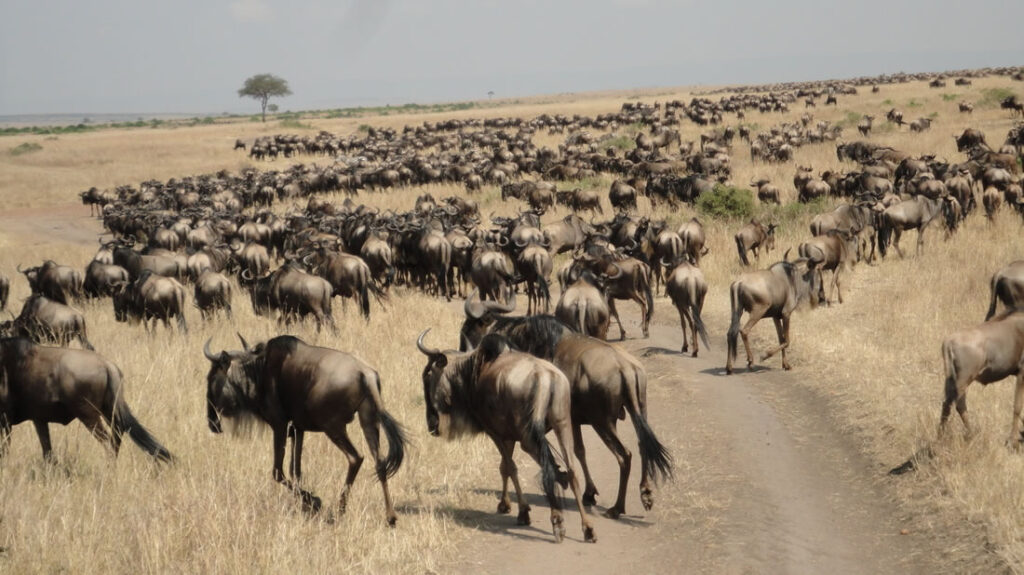
Wildebeest Migration Safari Masai Mara
Karibu kenya group departure safari, 3 days tsavo east and west national park safari from mombasa.

- Privacy Overview
- Additional Cookies
This website uses cookies so that we can provide you with the best user experience possible. Cookie information is stored in your browser and performs functions such as recognising you when you return to our website and helping our team to understand which sections of the website you find most interesting and useful.
This website uses the following additional cookies:
(List the cookies that you are using on the website here.)
Please enable Strictly Necessary Cookies first so that we can save your preferences!
- You are here:
- Kenya Tours
Kameraz of Afrika
6-Day Luxury Adventure in Kenya

4.8 /5 – 97 Reviews
$2,155 to $3,125 pp (USD)
Your request will be sent directly to the operator
If preferred, you can contact the operator directly
This Kenya safari gives you a chance to experience several parks in Kenya. We have chosen luxury accommodation, and it is an excellent deal for a 6-day stay in Kenya. We highly recommend this tour for a short family vacation, honeymoon, or travels with adventurous friends.

Tour Features
Luxury tour.
This luxury tour uses lodges and tented camps.
Private tour
This tour will be organized exclusively for you and won't be shared with others.
Can start any day
If availability permits, this tour can start on any day.
Can be customized
You can request minor changes to the accommodations and destinations of this tour.
Suitable for solo travelers
Solo travelers can book this private tour.
Suitable for all ages
This tour is suitable for children of all ages.
Activities & Transportation
Accommodation & meals.
- Additional accommodation before and at the end of the tour can be arranged for an extra cost
- Day Accommodation Meals
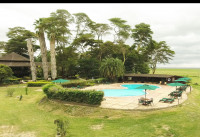
- 6 End of tour (No accommodation) – Breakfast Included Breakfast Included
Interested in This Tour?
Request a Quote
- We advise requesting quotes from 3 operators ( Learn why )
- Requests are sent directly to the tour operator
- If preferred, you can contact the tour operator directly
Best price guarantee
- This tour is offered by Kameraz of Afrika , not SafariBookings.
- This operator reserves the right to change rates advertised on SafariBookings.
- If you request changes to this tour, the advertised rates will likely change.
- The exact order, contents and rates of this tour are subject to availability.
- If an accommodation is fully booked, the operator will suggest a comparable alternative.
- What is included in this tour
Get a Free Quote
- More About This Operator
Customer Reviews

Customer driven provider, very helpful, and very courteous!
First the positives: 1. The owner, Carol Kendi, was very patient and helpful from the very beginning and worked with me to plan our trip. She is very customer-driven and it was a pleasure to meet her in person in Nairobi. I particularly...
Full Review

- Travel Guides Plan your adventure
- Destinations Our favourite places
- Tours Book a trip
- Travel Companies Independent specialists
- Travel Guides
- Destinations
- Travel Companies
Safari in Kenya
Kenya's best safari reserves and camps.
Stuart Butler
- In this guide
- Samburu, Buffalo Springs & Shaba
Meru National Park
Lake nakuru national park, amboseli national park.
- Nairobi National Park
- Off the beaten track
Kenya besides safari
- Where to go
- Need to know
- Itinerary planning
- Hidden gems
- Conservancies
- How to plan & book
Kenya is the original home of the safari and it’s still one of the finest safari destinations in Africa . I've been going on safari in Kenya for decades, as a travel journalist and guidebook author writing about safari, conservation and life among the Maasai tribes.
The main thing I've learned: there's so much more to Kenya than the mainstream safari industry of luxury camps and the famed “big five” (so named because they were the prize targets of colonial–era hunters).
The country proudly boasts of an impressive network of protected spaces made up of 65 national parks and reserves as well as dozens of private and community conservancies. Together these cover a huge proportion of Kenya’s diverse landscapes and provide a home for animals as large as an elephant and as tiny as an elephant shrew.
Some parks, such as the Masai Mara and Amboseli , are rightly world famous. Other parks, such as Meru National Park or Kakamega Forest Reserve, barely make a blip on the mainstream safari circuit but are every bit as rewarding (and much quieter!) then the big name parks and reserves.
Kenya has a world class safari tourism industry with excellent safari operators catering to all budgets and a diverse portfolio of safari lodges and camps. All you need to decide is when and where to go – and that's where my guide comes in. Dig in and Safari njema! – (Have a nice trip!)
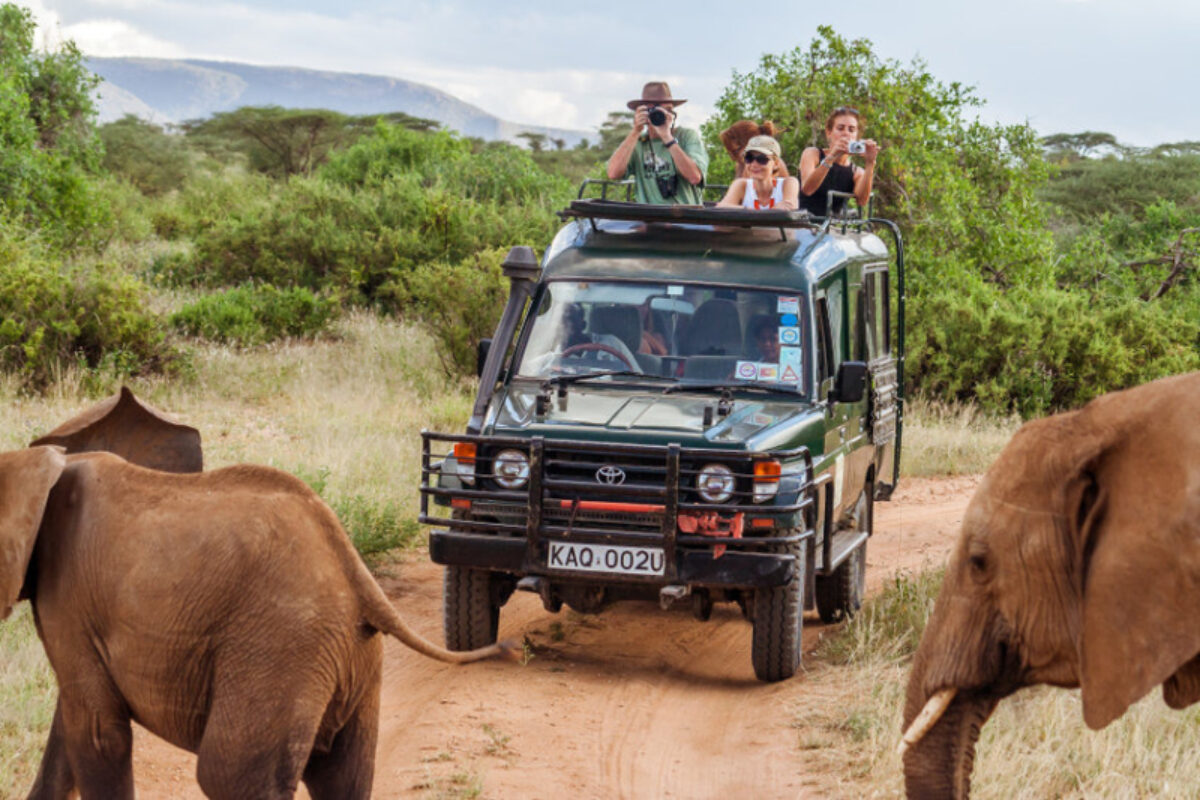
Close encounters with a herd of elephants in Kenya's Masai Mara
The best safaris in Kenya
Kenya’s most popular – and some underrated – safari highlights, masai mara national reserve, mara north conservancy, ol pejeta conservancy, samburu game reserve, tsavo east & west national parks, loita hills, kakamega forest reserve, aberdare national park, lamu island.
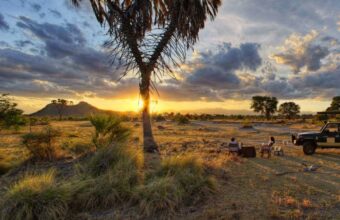
Elsa’s Kopje
This is the best lodge in what is, for me, one of the best safari parks in Kenya. Named after Elsa the lion, of Born Free Fame, the lodge sits on an outcrop with simply incredible views over Meru. Owned by Kenya-based Elewana Collection, it’s undeniably pricey – rooms start at around USD $950 per night and climb steeply from there – but worth a night or two if your budget can stretch that far. If that’s beyond your means I can also recommend Meru Camp and there are cheaper options in the nearby town of Maua.
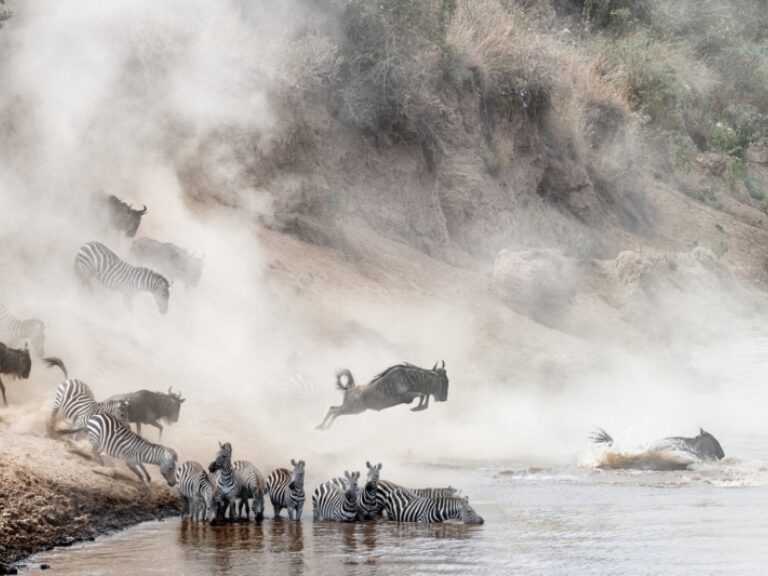
Witness the migration river crossings – but expect crowds!
The wildebeest migration is one of the world’s greatest natural phenomena, and watching the herds dodge hungry crocodiles as they surge across the Mara River is a staple of Kenya safari. The migration moves into the Masai Mara from Tanzania’s Serengeti between June and October. This is by far the busiest time and place of the year, so expect crowds. If you’d rather see the migration untroubled by crowds, I recommend you look at Tanzania instead.
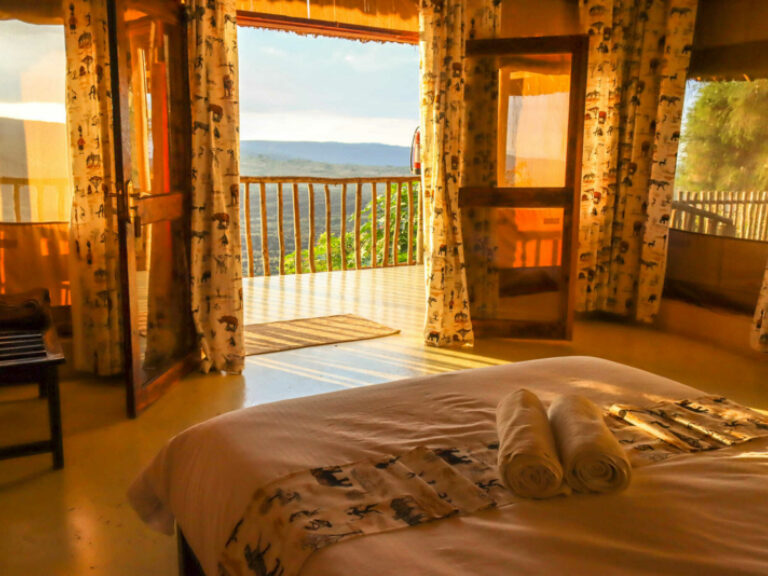
Denise Carnihan
I can highly recommend Maili Saba. It has a picturesque location overlooking the Great Rift Valley and volcano region, with lovely permanent tents each with en-suites and balcony, and all very nicely decorated. There is a communal pool and outside gazebos for relaxing. The main dining room and lounging area is stunning with striking cathedral ceiling and beautiful decor. The food is absolutely outstanding and the staff are warm, friendly and go out of their way to assist their guests. The first time I visited was a complete surprise organised by my Kenyan partner, and I've included it in our tour itineraries ever since.
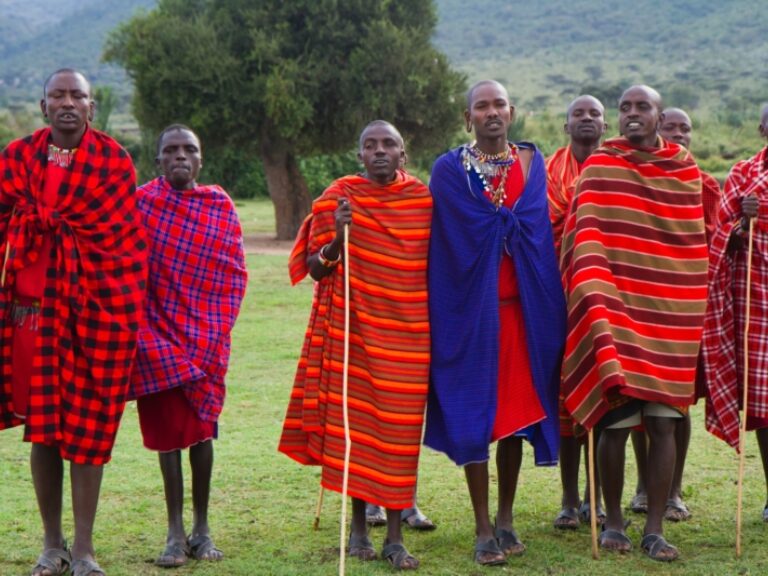
Nashulai Maasai Conservancy
One of the great success stories of Kenya safari has been the emergence of networks of conservancies, usually adjacent to the better known national parks. These are community-run or privately-operated protected areas, run for the benefit of wildlife and local communities. In the Masai Mara, the Nashulai Maasai Conservancy is particularly interesting, as it’s the only one that was 100% established by local Maasai and the only one where the Maasai remain in their homes within the conservancy. I can also highly recommend Mara North, Naboisho, and Ol Dereski; you’ll likely have an amazing time in any of them.
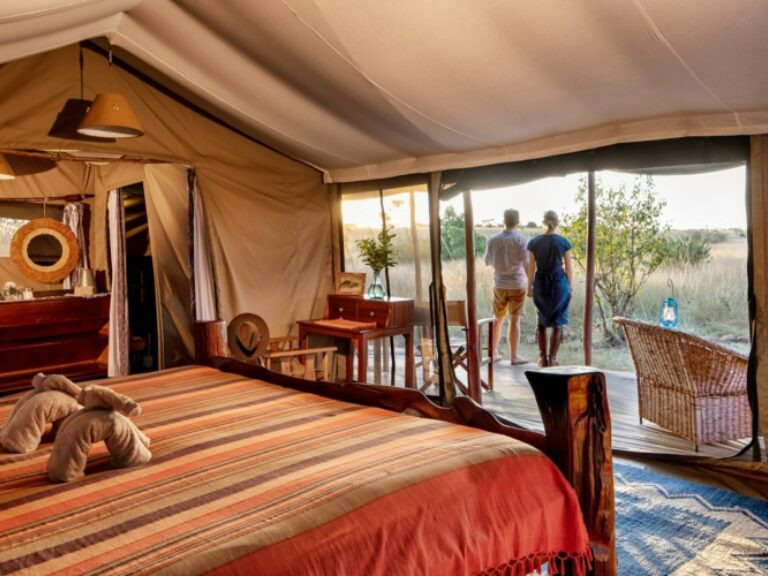
Offbeat Mara
Mara North is perhaps the best known conservancy in the Masai Mara, and Offbeat Mara is one of my favourite camps in the entire place. It's a small, un-showy camp of just seven tents including two family tents. In addition to the standard game drives you can do night drives, guided bush walks, horse riding, hot air balloon flights and even do some Maasai running coaching!
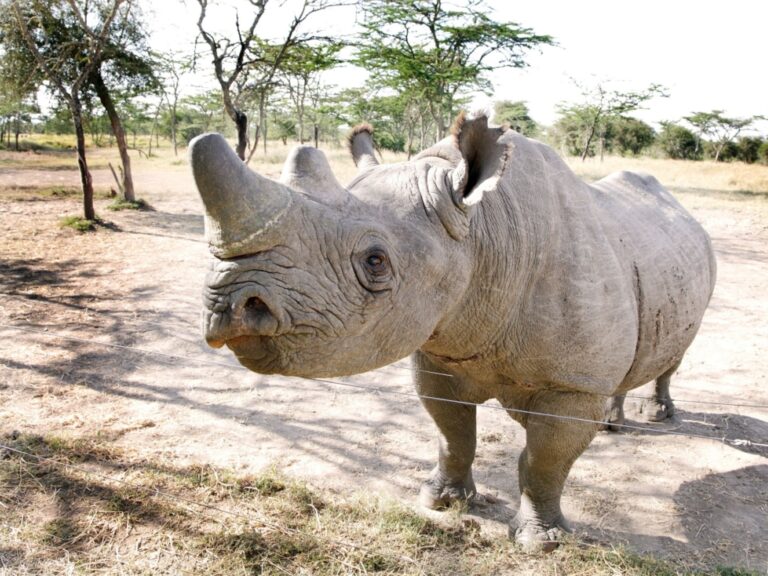
If you’ve ever wondered what the hide of a rhino feels like, wanted to experience a safari at night or dreamed of running (or riding) in the wild, open air of a safari reserve, head to Ol Pejeta Conservancy. The conservancy is in the Laikipia region, at the foothills of Mount Kenya. The sanctuary is the largest in East Africa to host black rhino, as well as the world’s last two remaining white northern rhino. Ol Pejeta is also the only place in Kenya where you can see chimpanzees. Conservation is at its core, with several experiences available for intrepid safari-goers who want to do more than just watch the animals.
Those looking to get their hands dirty can join one of the one or two-week volunteer programmes and learn wildlife research and tracking, veterinary care and more of what goes on behind the scenes. The conservancy has several accommodation options from simple cottages to basic campsites and luxury tented eco-camps.
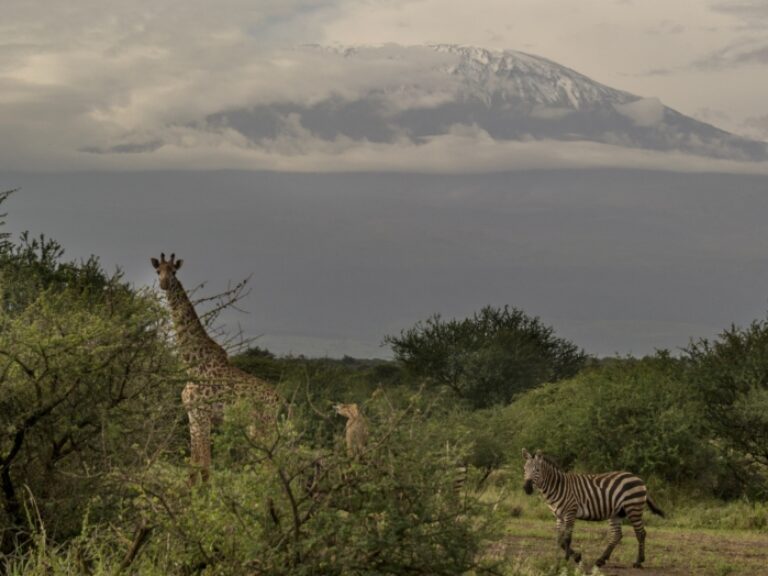
Campi ya Kanzi
If elephants are your thing, you can’t do much better than Amboseli where herds of these magnificent beasts graze in the shadow of the equally magnificent Mt. Kilimanjaro. By far the best place to stay is not in the park itself but 30km away at Campi ya Kanzi in the Kimana Community Wildlife Sanctuary, situated between Amboseli and Chyulu Hills. It’s a very high-end Maasai-run camp that was set up to aid the local community and conservation projects. Its excellent location means you can see wildlife in the conservancy, Amboseli and Chyulu all from one base.
Saruni Rhino Camp
This camp in the Sera Conservancy, just north of the Samburu Reserve in northern Kenya occupies a stunning location in the semi-desert. Their specialism is a thrilling rhino tracking walking safari, probably my favourite place to see rhinos in all Kenya. I spent five days here and by the end still couldn’t decide if coming within ten metres of the steamroller-like rhinos was thrilling or simply terrifying!
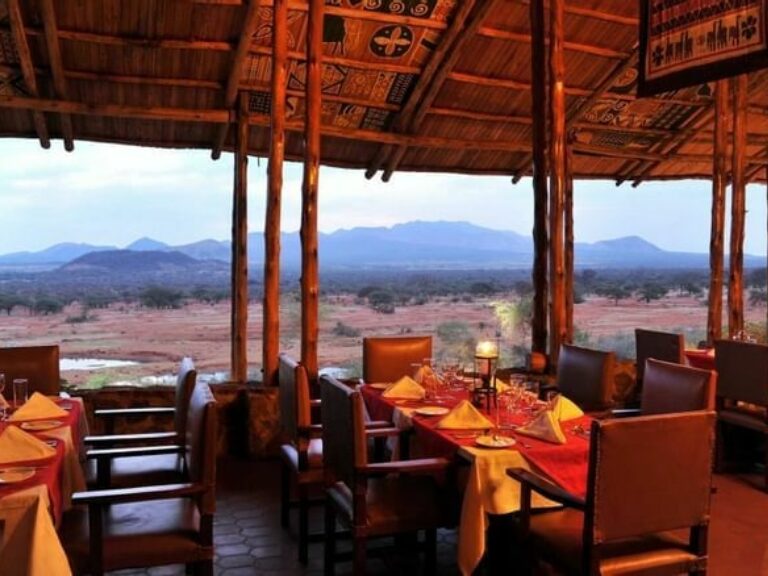
Kilaguni Serena Lodge
In Tsavo West most of the accommodation is fairly expensive (unless you have your own camping gear in which case there are three spartan public campgrounds). A reasonably-priced option is the Kilaguni Serena Lodge – it’s far from a budget offering but the Serena collection is generally pretty good value. If you have the budget to blow, Finch Hattons is the most exclusive camp in the park, with an eye watering price tag to match.
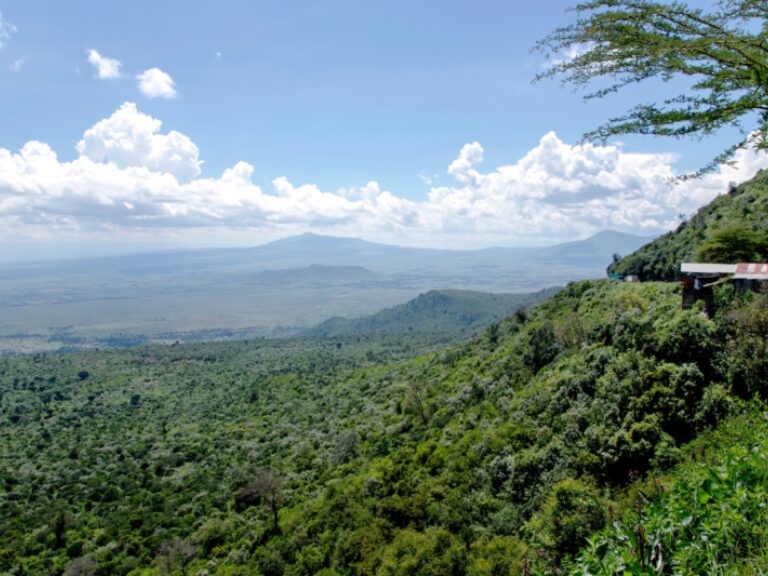
Best walking safari
In my opinion the best way to experience a safari is to ditch the 4X4 and explore on foot. With a good tracker-guide you’ll see all the little things you’d otherwise miss if you’re stuck in a vehicle all day. Walking is often forbidden within state-run national parks but is usually allowed, even encouraged, in conservancies. If I had to pick a favourite place for a walking safari in Kenya it’d be Loita Hills without question. Although not far from the Masai Mara, Loita Hills is barely visited by tourists despite boasting superb and varied scenery, a lovely climate, very different wildlife to the lower savannah plains, and fascinating interactions with very traditional Maasai culture.
Also, while Kenya doesn’t really compete with the multi-day Tanzania trekking scene, some organised trekking may be found here, as well as in the Aberdares and around Mt. Kenya.
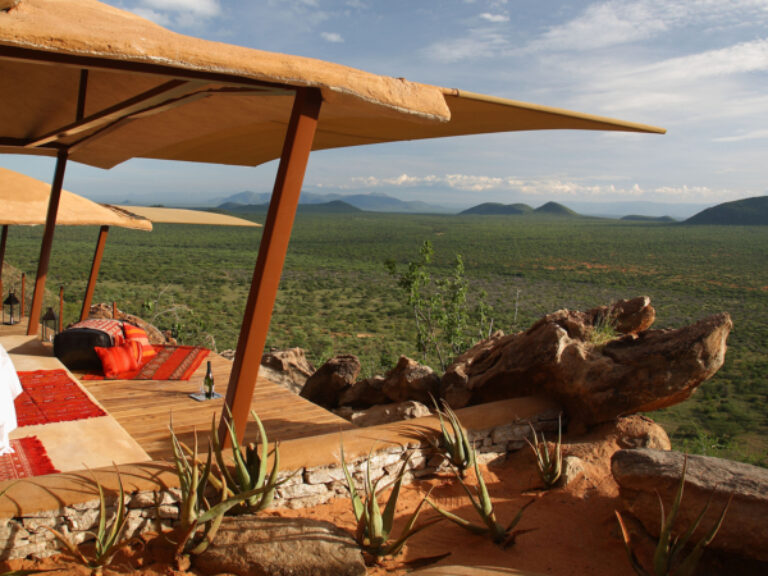
Saruni Samburu
There’s only one lodge within the Kalama conservancy, immediately to the north of Samburu Reserve, and it’s likely going to be one of the most spectacular places you’ll ever stay. Built into, around and onto a huge granite outcrop, Saruni Samburu is almost invisible from a distance but the stunningly turned out rooms offer a cliff side view over what feels like half of northern Kenya.
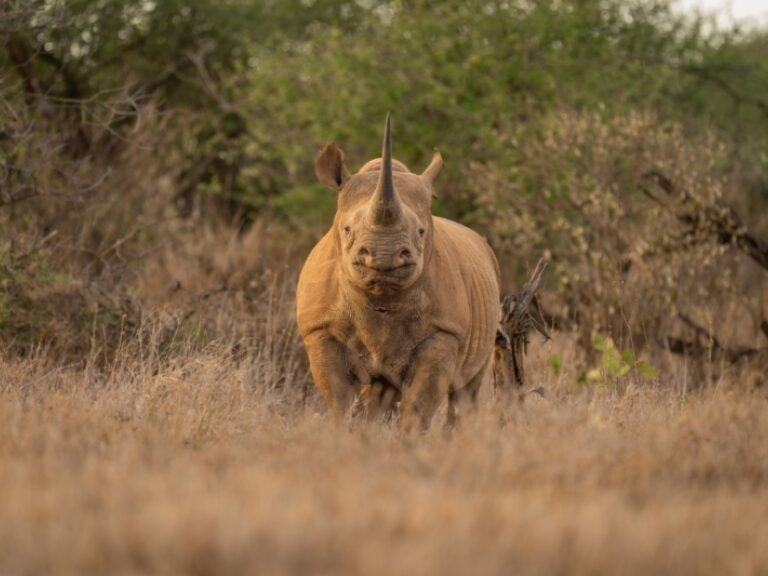
Lewa Conservancy
Lewa, in the Laikipia plateau area, is perhaps the most famous of all Kenya’s conservancies. And for good reason: this is safari to order. Want to see a black rhino? No problem. One of the superb guides will manage to find one. Lions, cheetah, elephant. They are all found here in abundance.
And it’s not just the wildlife that’s outstanding. The landscape is cinematic in its scope. Rolling sun bleached grasslands, table flat acacia trees, meandering rivers and a backdrop of the glinting glaciers of Mt Kenya.
The other great thing about Lewa (and this is common to all the Laikipia area conservancies) is exclusivity. If you’re not a guest of one of the handful of lodges then you can’t go on a safari here.
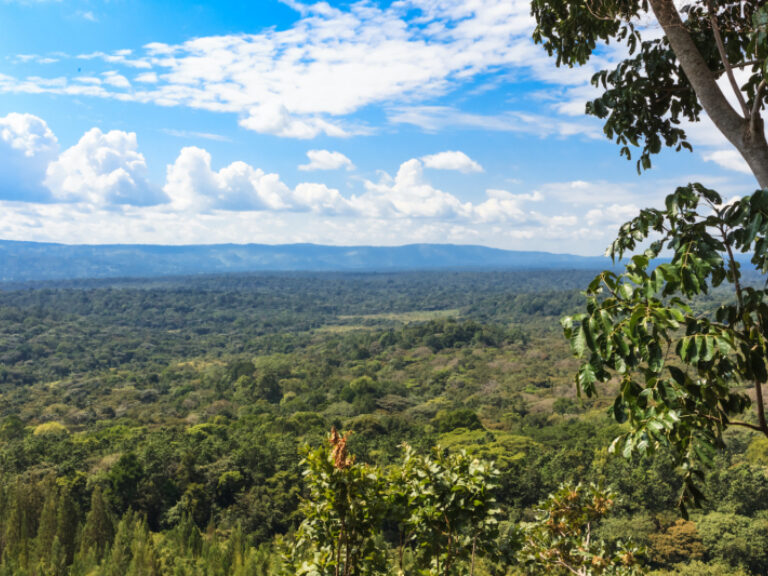
Kenya’s safari hidden gem
Just north of the equator in far western Kenya, is Kakamega Forest — Kenya’s only tropical rainforest. The land here is wet, green and intensely cultivated with a mix of subsistence farming and large tea estates. In amongst all this though are a few pockets of the dense rainforests that once covered large parts of western Kenya.
The Kakamega Forest Reserve is a fine example of this kind of forest and interesting walking safaris here reveal bird and primate life that has more in common with the forests of Uganda and the Congo than anything you’ll see on safari in Kenya. Wander the forest’s network of trails and take in the huge variety of flora and fauna it supports, including hundreds of bird species, some of which are not found anywhere else.
In my opinion, Kakamega is one of the most delightful places in Kenya, but yet hardly any tourists know of its existence. It should be a must visit for any ornithologist or herpetologist. As well as birds, reptiles and primates, I found the visit to the old mine shaft to look for bats especially memorable.
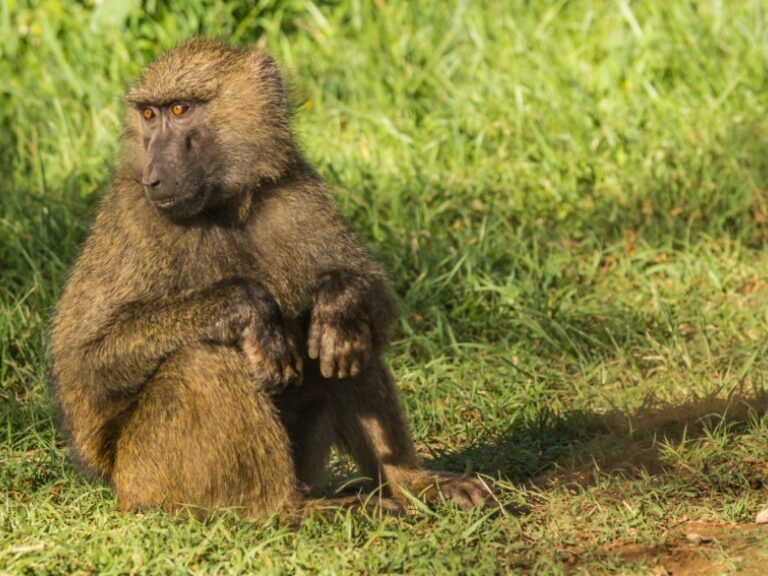
Up close and personal with baboons
Laikipia is known for its rhino conservation, but my own personal highlight in this area wasn’t the rhinos. Rather it was the day I spent with a biologist in very close proximity to around 200 habituated baboons. Having a huge male baboon shove its way past you as it bares its teeth was an experience easily on a par with gorilla and chimpanzee encounters in East Africa. The other nice thing about this particular experience is that it doesn’t involve staying inside an expensive conservancy but rather you are hosted by a grassroots Maasai womens’ project. And hardly anyone – even other Kenyans – know about it!
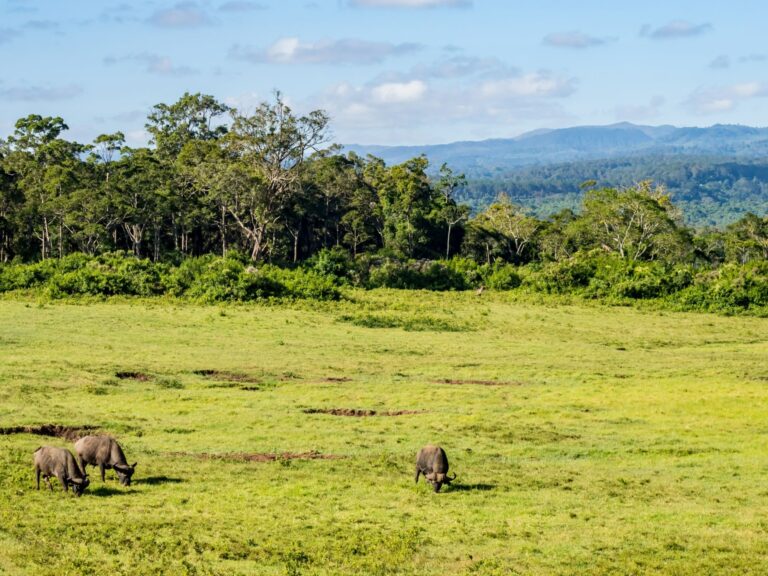
Hiking in Aberdare National Park
A world away from the African safari image of savannah grasses and drooling sunsets, the Aberdares consists of two different ecosystems. A high, cold and often bleak moorland and, below that, dense tangled montane jungle.
The wildlife here is a little different and a little harder to spot. But elephants are very common as are big grumpy buffalo. There are also montane species you won’t see anywhere else including bongo antelope, bush pigs and melanistic leopard and serval.
Unusually among Kenyan national parks, you can also get out of the vehicle here and enjoy long, lonely hikes over the moorlands: I have really enjoyed the sensation of trudging across the bleak moorlands in cold afternoon drizzle while always keeping a beady eye out for roaming buffalo.
The park also has some history. In 1952, a young English lady named Elizabeth was staying at the famed Treetops Lodge here (today’s version is actually a reconstruction of the original) when it was announced that her father had died. And so it was, that on a remote Kenyan mountain slope, that young lady became Queen Elizabeth II. Many years later her eldest grandson, and future king, proposed to Kate Middleton in a small wooden fishing cabin in a spot not so far away from where his grandmother became Queen.
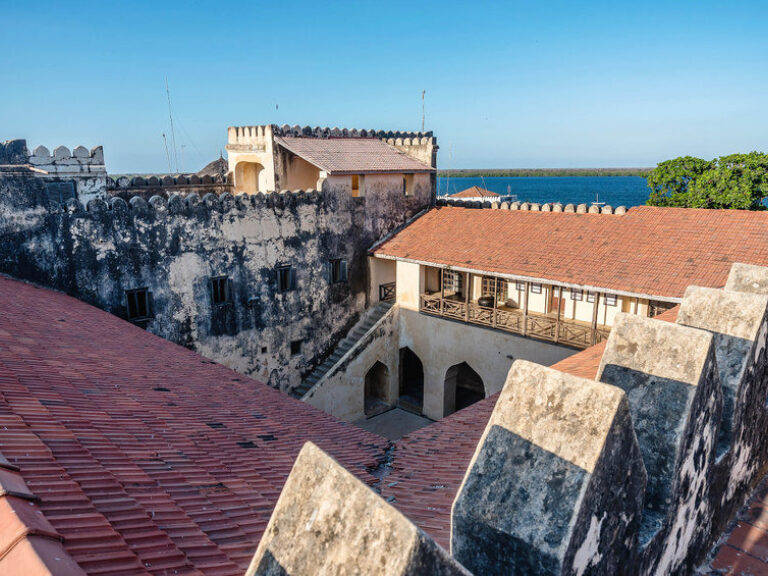
Post-safari beach time
If time allows I highly recommend you find a couple of days to wash away the safari dust on Kenya’s palm-fringed coastline. The country has many beautiful beach destinations but the standard itineraries tend to focus on Diani, south of Mombasa. My vote goes for the underrated Lamu archipelago, and in particular the old Swahili trading town of Lamu, which always leaves me enchanted.
Featured kenya safaris
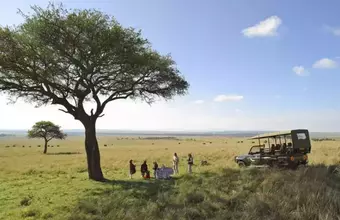
Affordable Masai Mara Safari
Samburu, Rhinos and Mara Safari
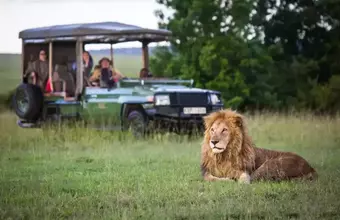
Enchanted Kenyan Safari
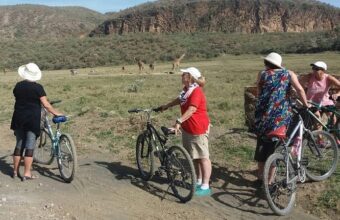
A Taste of Kenya
19 day small group tour.
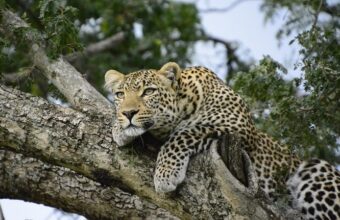
Family Memories
16 day private guided safari.
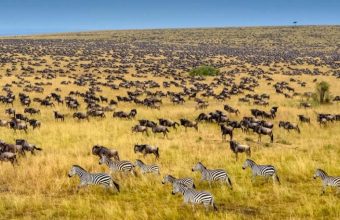
Tanzania and Kenya Safari
The greatest safari on earth, kenya's best safari parks, kenya’s most popular safari parks and lesser-known hidden gems.
In a standard two week safari it’s perfectly possible — in fact I'd highly recommend — to explore three or four different protected areas. Ideally with each one offering a totally different habitat and set of wildlife inhabitants. If I had to pick a favourite, I'd probably vote for Meru National Park, but any of the following could feature on a Kenya safari.
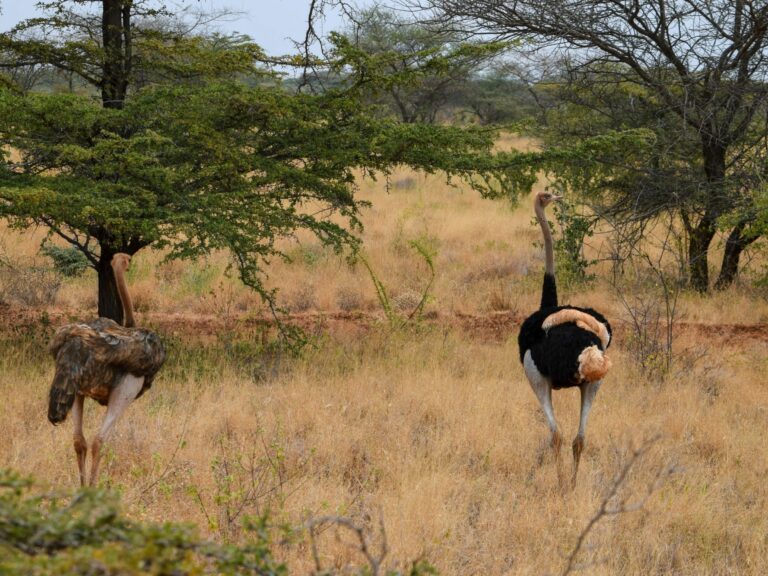
Best for tranquil, crowd-free safaris
Meru, the country’s forgotten national park, is easily one of my favourite of all Kenya’s safari parks. This was once one of the most popular parks in the country but during the 1980s, when Kenya was going through a rough political patch and instability overwhelmed some parts of the country, Meru turned into a hotbed of poaching.
Security and stability have long since returned, yet somehow this park never returned to its former fame. But for those in the know – and that now includes you – Meru National Park is safari gold.

For the classic – if busy – Kenya safari
The very essence of an African safari landscape, the Masai Mara stretches along the Kenya-Tanzania border and forms the northern fringe of the greater Serengeti ecosystem (most of which is in Tanzania ).
This is the part of Kenya in which I have spent the most time (months and months if I added it all up), and was the scene of one of my best ever travel experiences. Some years ago a Maasai friend and I set out on a five week hike that took us across the entire Mara ecosystem. By day we walked alongside the wildlife and Maasai herders. By night we camped out under the stars and slept in traditional Maasai villages. An unforgettable adventure!
This is the place to see large prides of black-manned lions, bellowing elephants, grumpy buffalo and a pick ‘n’ mix box of antelope and gazelles. And that’s before we even touch on the smaller creatures and huge array of birds. But, above and beyond all else, the Mara is renowned for the spectacular wildebeest migration .
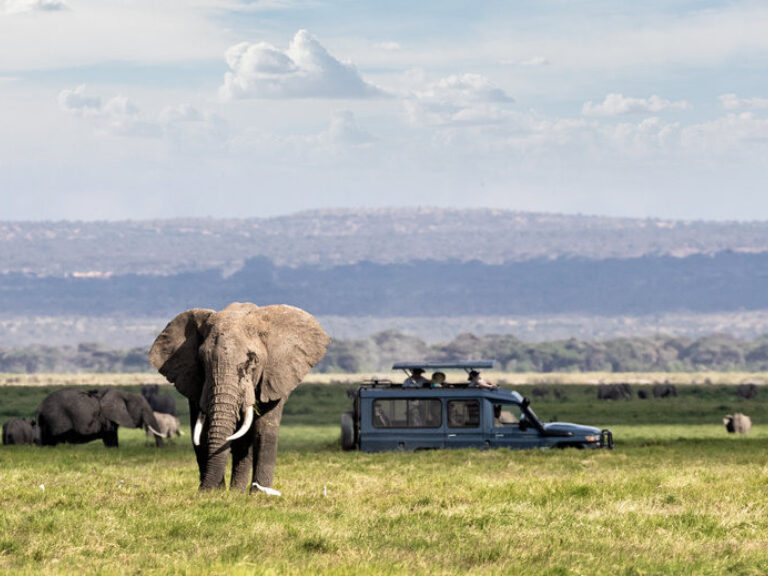
For elephants & Kilimanjaro views
Amboseli National Park is the postcard park of Kenya. This is where those photographs are taken of elephants with a backdrop of the (fast melting!) glaciers of Mt Kilimanjaro. I have spent many dreamy mornings parked under an acacia tree, a thermos of coffee in hand watching the rising sun tinge the snows of Kilimanjaro a pinky-red.
The elephants and the scenery are the real highlights of this park. In dry periods they flock here from miles around to quench their thirst in the swamps and pools that splash the dusty landscape in greens.
Another big reason to visit Amboseli is the chance to see conservation in action in the conservancies and other environmental and community projects surrounding the park.
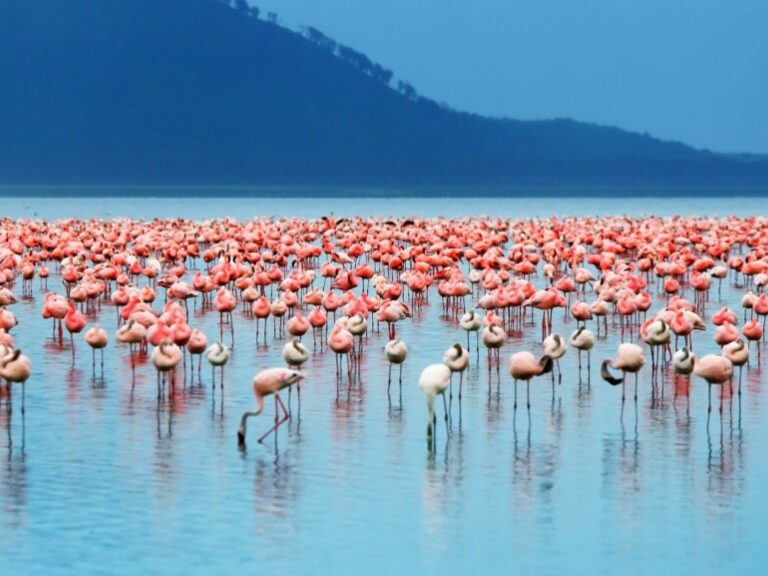
For wetland safari & birdwatching
Just 5 kilometres from the big city of Nakaru, Lake Nakuru National Park’s accessibility makes it one of the most popular Kenya safari hotspots. It’s centred on the large Rift Valley soda lake of the same name, but also encompasses fringing grasslands, acacia woodlands and rocky escarpments.
The park is best known for its sometimes huge flocks of flamingos and a large rhino population. Back in the 1990’s, Lake Nakuru was the first place where I saw a really huge flock of flamingos. I’d seen the odd handful before, but the thousands upon thousands I saw here on that day sticks in my memory. The smell (ah yes the smell!), the noise, and of course the searing pink colours; It was one of the moments that made me fall in love with Kenya.
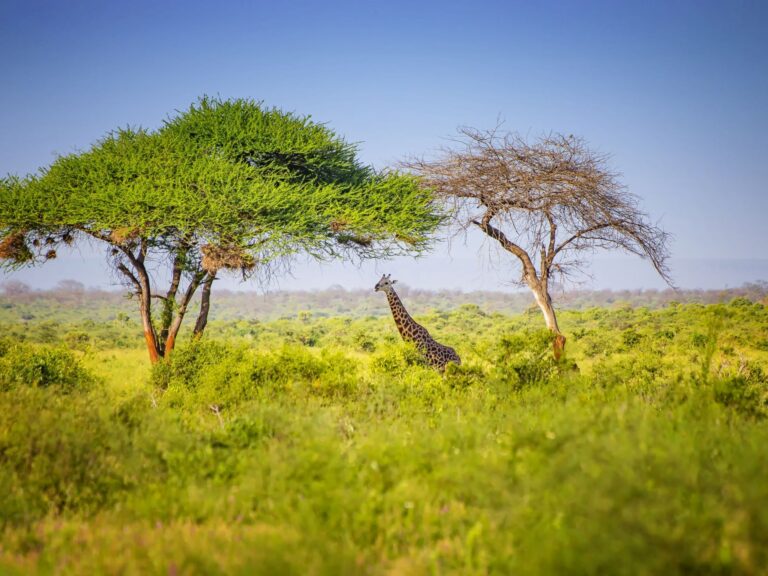
Best for wide open spaces
Combined, Tsavo East and West National Parks cover an enormous swathe of acacia scrub Kenyan wilderness. Tsavo West alone (the bigger of the two parks) covers an area greater in size than Wales, or two and half times the size of Yellowstone National Park.
The two parks are separated from each other by the Nairobi-Mombasa highway and are easy to reach from either city.
Despite being directly adjacent, the two parks are radically different from one another with the green hills of Tsavo East a marked contrast to the red soil and volcanic landscapes of Tsavo West. Because of their diversity and sheer size, I strongly recommend you devote enough time to the parks if you’re going to visit them. The rushed two-day safaris from Mombasa (or Nairobi) simply don’t allow enough time to get much out of a visit.

For world-leading conservation
The Laikipia plateau area in central Kenya is one of the most exciting places in African conservation. This isn’t a single national park or reserve, but rather a network of interlocking private and community-run conservancies where people, livestock and wildlife live together to the benefit of all.
Laikipia hosts all the classic East African safari mammals but is best known for its rhinos, including the critically endangered northern white rhino, only two of which are left alive. Both are female and so, tragically, this is a species awaiting extinction. They can be seen at the Ol Pejeta conservancy.
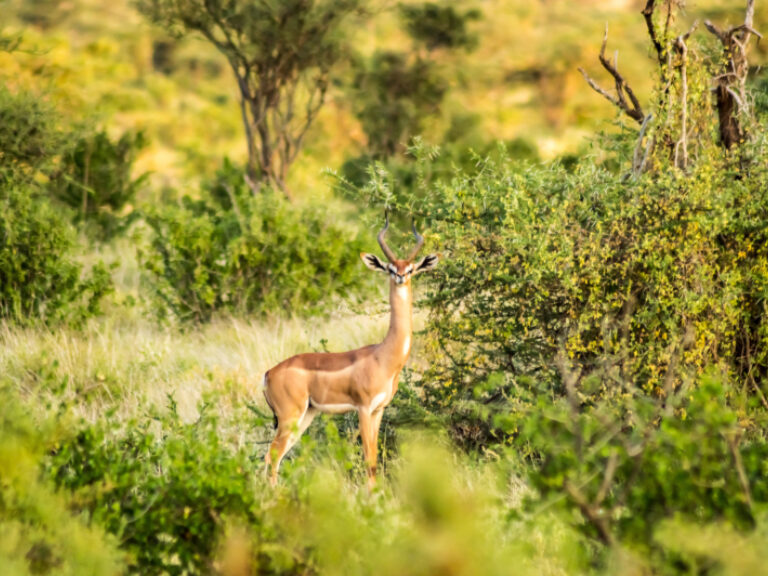
Kenya’s remote far north
Samburu, Buffalo Springs and Shaba National Reserves are three interconnected reserves on the edge of northern Kenya’s vast semi-desert wilderness.
Far removed from mainstream Kenyan life, these northern regions have a wild reputation. The landscape is harsh with endless sunburnt plains of acacia thornbush out of which rise the occasional fertile and densely forested mountain peaks, ranges, table lands and volcanic plugs.
Elephants, in particular, are the main event here. There are large herds who can migrate huge distances in search of water.
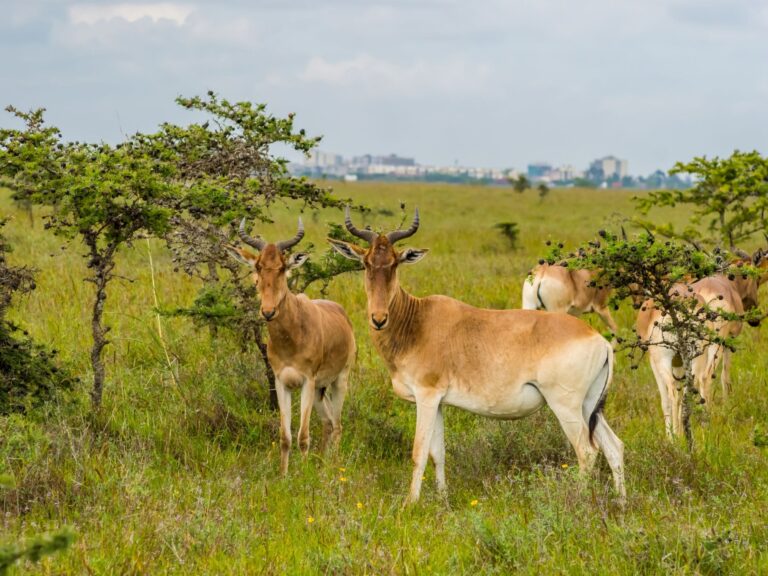
Safari in the big city
While most capital cities have their collection of ornate parks filled with neatly cut lawns, manicured flower beds and perhaps a boating lake, Nairobi has gone one step further.
Its biggest ‘park’ is in fact a 117 square kilometre swathe of undulating savannah grassland and acacia woodland. And while it doesn’t have a boating lake, it does have lions. And buffalo. And rhinos. All of which means that it’s probably not such a sensible place for an after work stroll.
It’s a fabulous safari destination but is woefully overlooked by international visitors to Kenya. This is a shame, because Nairobi National Park is an excellent safari location in its own right. I have been many times, often just for a quick half-day drive from the city. This was the place I first witnessed the thrill of a hunt: a cheetah racing, but failing, to grab dinner for her cubs.

A pair of ostrich in Meru National Park
Kenya safaris: Need to know
Everything you wish you'd known before you booked.
My first Kenya safari was in 1994 and I’ve been coming back pretty much every year since. Here’s what I’ve learned over the years about the best way to plan and book a safari in Kenya.
Mix up your itinerary
My single most important tip for Kenya safari first-timers is to avoid the mistake of non-stop game drives. Standard tour operator itineraries shuttle you from park to park with a gruelling schedule of game drives. Yes, this is the best way of seeing large mammals up close, but the bumpy tracks, early starts and long hours quickly exhaust even the most ardent wildlife-watcher. And there is so much more to safari in Kenya that you’ll miss from racing around in a jeep. Break it up. Look for operators who offer bush walks, village visits, and conservation projects. Or simply take an afternoon or two to sit back under a tree enjoying the sights, sounds and smells.
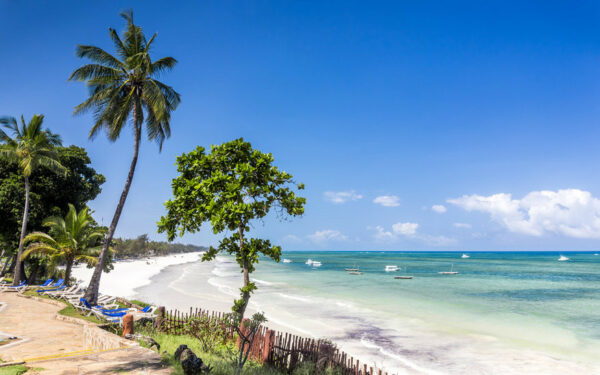
Many visitors to Kenya devote their entire trip to going on safari…
Don’t miss Kenya’s many hidden gems
Most standardised Kenya safari itineraries reduce the entire country to the blockbuster highlights: the Mara, Amboseli, Lake Nakuru… maybe Tsavo and Samburu if they’re feeling adventurous. This does a great disservice to the country’s true diversity. There’s so much more to a Kenya safari than racing around the savannah chasing the big five and I’d strongly advise you find time to visit some of Kenya’s numerous hidden gems.
For instance, out in the far west is Kakamega Forest Reserve which has more in common with the rainforests of Uganda and the Congo than the classic Kenya landscape. In my opinion this is one of the most delightful places in Kenya, yet hardly any tourists know of its existence.
Another personal favourite that’s a world away from the classic Kenya savannah is Aberdare National Park where dense tangled montane jungle gives way to a high, cold and often bleak moorland. Unusually among Kenyan national parks, you can also get out of the vehicle here and enjoy long, lonely hikes over the moorlands.
But that’s not it: Saiwa Swamp, the Chyulu Hills, Hells Gate, Ruma National Park, and many more that rarely feature on the mainstream Kenya safari circuit but are usually accessible on a self-drive safari, or with more specialist safari operators.
Get out of the safari bubble
Many safari goers, especially those on a high end tour just bounce from one heavenly safari camp to another. Sure, you live the Hollywood Africa dream but you’ve not really experienced real Kenya. Instead, hop on a bus and head out to one of the numerous small market towns where most Kenyans live. You’ll experience a totally different side of the country and it’s one that will stay with you long after the sundowner safari drinks fade from memory.
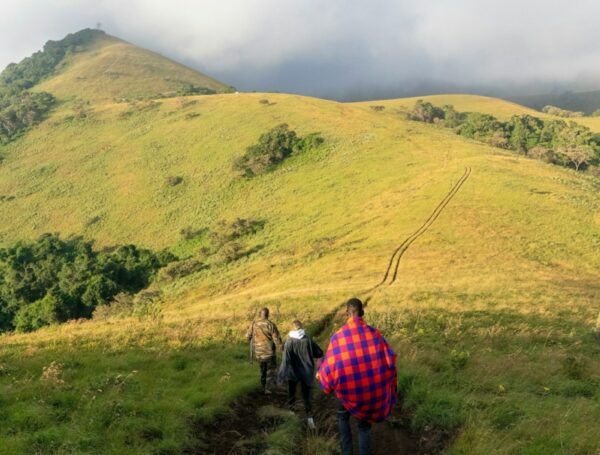
Kenya off the beaten track
The parks and reserves covered in my Kenya safari guide are only the best-known and most visited of the country's numerous protected and other natural areas…
Stay in at least one conservancy
National parks, reserves and conservancies are mentioned a lot in this guide, but just what is the difference and why does it matter?
A national park or reserve is a government or local council run protected area. Most of the best-known protected areas in Kenya fall into this category.
These areas are run solely for the benefit of wildlife and tourism, sometimes at the expense of local people. Tourism in these areas creates jobs, but locals are often forbidden from entering these protected areas other than for work reasons and communities were often (but not always) removed from their land when the parks and reserves were created. Corruption can be a problem with the money generated by these parks not always going where it should.
A conservancy is a different affair. A conservancy is normally located on either communal land owned by the community as a whole or on private ranch land and has no official government status. On a community conservancy the tourism stakeholders (i.e. the safari camps) lease the land from the local communities on the condition that the land is managed in a manner that is of benefit to both people and animals. The (normally very high) fees you pay to stay in a conservancy go toward paying the land leasing fees as well as various community and environmental projects.
Other conservancies may be located on private ranchland, in which case they have to make enough money for the landowner to financially justify turning his land over to wildlife conservation over cattle ranching.
In other words, a conservancy is run for the benefit of both wildlife conservation, tourism and the needs of local communities (in many cases local people are allowed to continue to graze their cattle on a conservancy but in a controlled and sustainable manner).
All of this means that staying in a conservancy is not just a great safari experience but it’s also very good news for conservation!
Do a homestay
For a cultural experience you’ll never forget, try spending a night at a Maasai homestay near the Masai Mara. Finding authentic, community-run homestays can be a bit of a minefield. I can recommend Sekenani Maasai Development Project (Semadep) but there are others – make sure you book with a community owned and operated outfit, and check reviews carefully.
Caution needed: "Human safaris"
In my opinion, one of the big problems with the safari industry is the way it prioritises seeing wildlife over having meaningful connections with local people. In fact, other than being served by their guides, drivers and camp employees, a typical safari-goer might not have any interaction with a local at all. To me, this is the exact opposite of how it should be done! In my experience, a good trip to Kenya isn't just about seeing wildlife: it should put intimate, authentic interactions with local people at the heart of the whole experience. You can make genuine connections and real friendships as you sit around, sharing stories, laughing and learning from each other.
On the other hand, mainstream Kenya safaris are often sold with "village tour" or even "slum tour" add-ons. These "goldfish bowl safaris" as I call them are unethical and nothing short of exploitation. They violate the privacy, integrity and dignity of local communities and undermine sustainable development by perpetuating a myth of backward, poverty-stricken people. The traveller thinks they're doing the right thing by getting some cultural interaction, but in reality it's deeply damaging. I strongly encourage visitors to avoid anything that feels contrived, and look for trips that put real people at the heart of the experience, rather than an afterthought.
How to plan & book a Kenya safari
There are three broad categories of safaris in Kenya.
The first and easiest option is to book a week(s)-long, multi-stop itinerary through a tour operator, either locally-based or international. This provides the most hand-holding and support for cautious visitors, plus more protection should things go wrong. The potential downside is getting shunted onto one of the more formulaic itineraries and simply following the crowds around the most popular parks. If you book a full tour with an operator, try to find a genuine specialist and ask about visiting some of the lesser-known locations mentioned in this guide.
Secondly you can simply show up and book a safari tour once in-country from the hundreds of operators in Nairobi. There’s nothing inherently wrong with doing it this way but I strongly advise you don’t just book something in the street. Do your homework first and find a reputable, responsible operator. Things to double check include whether park entry fees are included in the price, vehicle type (avoid cramped minibuses), and accommodation type.
Thirdly, and probably my recommendation for all but the most cautious of visitors, is to book the accommodation yourself, rent a car (or a car plus driver), and head out solo. You can take your own camping gear or book into lodges or camps (booking ahead is essential!), or mix camping with more comfortable nights in lodges. I strongly advise renting a vehicle plus driver. It’s often cheaper plus you get an unofficial local guide who knows the ropes. A good driver will become a cultural and language translator, wildlife guide, fixer, and general guardian angel.
Aim for shoulder season if possible
High season in Kenya is the peak summer months of July to September, before the rains begin. In my experience the best time to visit – especially in the busier parks – is either June before the crowds arrive or September-October as the crowds are thinning out, wildlife viewing is excellent and temperatures are ideal.
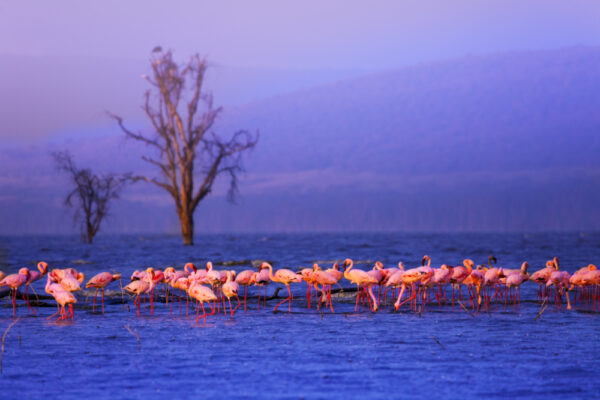
The best time to visit Kenya for safari
January & FebruaryThis is a hot and dry period…
Be prepared to splash out!
There are almost as many different ways of doing a safari as there are stripes on a zebra and how, when and where you safari makes a huge difference to what you pay. Expect to pay anything from $150 to $1,000+ per person per day.
You can find very low budget two or three day safaris to the Mara from around $250 all in, but these are generally rushed, crowded and uncomfortable. If you’re looking to shave off some costs without compromising on the experience, consider doing a DIY camping safari with your own vehicle and driver.
My other big Keny safari tip is to spend as much as your budget allows on fewer nights in better conservancies and camps. Packing more into fewer days gives you much greater bang for your buck.

Kenya safari costs
For a multi-day, mid-range safari visiting some of the big name parks and reserves then you’re looking at around USD $300-600 per person, per day…
Kenya safari FAQs
Your questions, our expert answers, is it safe / a good idea to rent a car in kenya and drive yourself around, or is it better to join a tour.
Yes, it's perfectly easy to do a self-drive Kenya safari . When you ask if it's "safe" that depends a little on what you mean. If you mean are there bandits, car jackings, dangers from wildlife, etc, then no you are quite safe. Instead the danger is from other drivers, as the driving conditions can be a little 'hectic' in places and accidents are common.
I'd recommend hiring a car with a driver, which can be a cheaper and, in my opinion, a much better option. A good driver will know the lay of the land, the driving conditions, best places to stop for lunch, etc. And they are often knowledgeable of the wildlife. A good driver will be both your driver and guide, and probably become your friend!
Almost any tour company in Nairobi or Mombasa can organise a private vehicle with a driver. Standards and prices vary hugely, so explain to the tour company exactly where you want to go and get in writing exactly what is and isn't included. Pay particular attention as to whether fuel, and the drivers food and accommodation is included in the rates. Also make sure you're booking the right vehicle: a 4WD may be needed for more remote areas.
Where’s the best place to see the big five in Kenya?
Seeing all the big five (lion, leopard, elephant, buffalo & rhino) in one park is hard. Only Lewa and some of the conservancies in Laikipia can honestly claim to offer easy sightings of all five. But, who cares! This fixation on racing around to tick off just five species is an anachronism from colonial-era big game hunting days. There’s so much more to Kenya’s wildlife and the modern safari experience.
We're visiting the Masai Mara but would like to visit another area on safari in Kenya. Can you recommend anywhere very different to the Masai Mara to see different wildlife and landscapes?
The most common combinations for a short add-on to the Masai Mara are Amboseli , Laikipia or the Samburu area.
For your requirements of a different habitat and wildlife then without doubt I would suggest Samburu National Reserve. This is a much drier and hotter area than the Mara with different vegetation and animals. And, even the animals you might have seen in the Mara are different up here with different species of giraffe, zebra and ostrich all present (and in my opinion all more beautiful than the kinds in the Mara). The park is also superb for elephants.
Samburu, though still popular, is notably quieter than the Mara and, once away from the river, it's easy to feel you have the place all to yourself (and especially if you go into the co-joined Buffalo Springs and Shaba reserves). Depending on when you are there you will find direct flights from the Mara, but otherwise will have to go via Nairobi. If you're driving it's a long way – a 10 hour non-stop drive, so flying is the better option.
Would you recommend staying at Elephant Bedroom Camp in Samburu Reserve, or at Sarara Camp in Namyunak Conservancy?
The quantity and ease of seeing the wildlife is better in Samburu Reserve than in the neighbouring Namyunak Conservancy (because the wildlife is drawn to the river running through the reserve). But there's not a huge difference in habitats or species between the two.
Elephant Bedroom Camp, in Samburu, is a fabulous, small camp. You'll see a lot of elephants and the owners are some of the worlds foremost elephant experts.
In Namyunak Conservancy, Sarara Camp is one of the most exclusive – yet low-key – camps in Kenya. There's slightly less wildlife than in the reserve but it's very close to the reserve and safaris from Sarara often enter the reserve.
The bonus with Sarara is exclusivity. You and the other camp guests will have the entire place to yourself meaning no crowding around animals (though that's rarely a problem in Samburu).
Unlike in the reserve itself you can do walking safaris in the conservancy and there will be more interaction with local people. The final plus is that by staying on a conservancy you will be actively helping to fund private/community conservation initiatives, which isn't always the case when staying only in a reserve or national park.
Overall then, I would opt for Sarara Camp, but I suspect it does cost more, so it might come down to budget!
We are travelling with a large group of 5 families with 3-4 kids per family. What are the best budget friendly safaris in Kenya in July?
If most of the children in your group are very young, your options are fairly limited as the reality is that a longer, multi-day safari can be a bit much with very young kids. I first did a safari with my kids when they were five and two years old and although it was good I probably wouldn't do it again! Past the age of about eight or nine the safari experience gets much easier, as they'll will tolerate sitting in a jeep on a bumpy road for longer.
Do be aware that some safari camps don't accept children below the age of 12. These are normally the unfenced camps and it's done for safety reasons.
You will also need to keep in mind that you will either need several safari jeeps and to travel in convoy or a bus (and these aren't always allowed in some parks). Because you will be travelling with so many children I would suggest small safari camps which you can book out for your group alone. Some of these are more child friendly than others. Some possibiltles that I believe might work well for your group are: Maji Moto Eco Camp, Loita Hills Basecamp, and if you are interested in a Maasai homestay style experience then I'd suggest Semadep Camp, who can arrange homestays around the Masai Mara.
As for specific parks and reserves the Masai Mara area is good because there's a lot of animals to see everywhere you look which keeps children interested. Also good are Nairobi and Narok national parks because of easy access and good roads. Lake Naivasha is good for families too.
It would be easy to combine all these places into a 10 day safari and then you could maybe finish up on the beach (Lamu and Watamu are both superb for families).
Can you recommend any family-friendly camps/lodges in the Masai Mara?
I would suggest rather than staying within Masai Mara proper, stay in one of the conservancies that now fringe the Mara.
In the most basic of terms these are like private, community-run wildlife reserves. Conservancy operators lease the land from local people and each local family receives a guaranteed monthly payment. The conservancy also provides employment and sets up development projects. People continue to graze their cattle but in a more controlled manner. And in return, fences are removed and the wildlife encouraged to return to the lands they were once driven out of. The conservancies have been a great success both for wildlife and local people. And, for tourists, they offer a very exclusive experience and the world's finest safaris.
Each conservancy has only a handful of very discreet high end camps and only guests of those camps can go on a safari in the conservancy, which means crowds of vehicles around a lion are non-existent.
The conservancies also allow activities not permitted within the reserve such as walking (highly recommended), bush camping, night safaris, etc. This makes them ideal for kids because it breaks up the routine and allows a little more freedom.
The safari vehicles and guides used in the conservancies are absolutely the best in the game and the wildlife populations are the equal of the actual reserve. However, there's a catch (of course...), conservation like this doesn't come cheap. All of the conservancies are superb but some names are Naboisho, Mara North and Nashulai Maasai Conservancy (this last one being slightly cheaper than the others and lots of focus on meeting local people). As for actual camps you cannot go wrong with any of them. All the conservancy camps are superb. I'm a big fan of the Basecamp offerings, Off-Beat and Kicheche. All are a little less extravagant than some of the other camps.
If you want to only visit the reserve and not a conservancy then I suggest either Basecamp Mara, Oldarpoi or you could go for a Maasai homestay in Sekenani village. Expect basic but perfectly comfortable rooms but an amazing experience. Your kids would really enjoy this.
Is February a good time to visit the Masai Mara, or would June-July be better? What would be the differences?
February is a very good time for safari in the Masai Mara , but also very different to the experience in June and July.
It's hotter and drier in February and generally there are fewer other tourists. There will still be plenty of zebra and wildebeest around but these are the non-migrating resident herds, so they don't form the massive iconic herds that you might see on TV.
July is good because the migrant wildebeest are all normally in the Mara by then, but its also absolute peak high season so can be busy and expensive. June is perhaps my overall favourite month. Everything is green after the rains and it's nice and cool with far fewer tourists than July, but the first migrant wildebeest might start to arrive (it all depends on rains and the state of the grass).
In short, all three months are excellent but each is different so it might be best to go with whatever just suits your timings better.
I will be in Kenya in early March and am looking for a five day safari for wildlife photography and birdwatching. Where would you recommend for me noting it is the start of the rainy season?
Early March is still a bit early for the rainy season so you might just get the odd thunderstorm. If birds are your real interest and you only have five days then probably the easiest is to go down to the Masai Mara via the Rift Valley lakes of Naivasha and Elementia or Nakuru. This would give you a good range of avian habitats and species in a short space of time. Don't forget as well that Nairobi itself has some excellent birding in the various forests and parklands in and around the city. Plus of course, there's the superb Nairobi National Park where you will see a lot of wildlife and birds.
We can't travel during the migration river crossings, are there other impressive spectacles at other times of year?
Yes! I think calving season during the wildebeest migration is just as spectacular as the more famous river crossing period.
This period runs from December to March around the Ndutu Plains to the south of Serengeti. During this time the wildebeest and zebra stampede over the plains preparing to give birth to thousands of calves. At the same time the big cats are on the lookout for an easy snack. With vast numbers of animals, their sounds and smells, all of the little calves, and the big cats on the lookout... it's theatre on an epic scale and you cannot be disappointed. And the extra benefit is that it's a much shorter drive here than to see the river crossings.
Robbin Meulemans
In this guide:, typical prices for a safari in kenya, when to go on safari in kenya, things to do in kenya other than safari, best safari camps and lodges in the masai mara, about the author.
Stuart is an award-winning travel journalist covering safari, trekking and conservation in Africa for the Lonely Planet, Rough Guides, BBC, Bradt Travel Guides, amongst many others. He is the author of Walking With The Maasai , a journey through some of Kenya's lesser-visited Maasai lands.
Featured tours

Kenya & Tanzania East African Adventure
21 day small group tour.

Other guides you might like
Gorilla safaris, an expert guide to seeing gorillas in the wild.
Philip Briggs
South africa safari, an expert guide to safaris in south africa.
Anthony Ham
Wildebeest migration safaris, an essential guide to planning a migration safari in tanzania and kenya.
Hans Cosmas Ngoteya
Safari in zambia, an expert guide to zambia's best safari parks, camps & lodges.
Sarah Kingdom
Safari in tanzania, an expert guide to tanzania's best safari parks & camps, safari in botswana, an expert guide to botswana's best safari reserves, camps and experiences, where and how to see the big 5 on safari in africa, safari in africa, our travel writers' top africa safari picks, zimbabwe safaris, an expert guide to the best safari camps in zimbabwe, chimpanzee trekking, an expert guide to seeing chimpanzees in the wild, namibia safari, an expert guide to the best safaris in namibia.
Melanie van Zyl
Featured tours view all.

Why Horizon Guides?

Impartial travel guides
Our guides are written by the leading experts in their destinations. We never take payment for positive coverage so you can count on us for impartial travel advice.

Expert itineraries
Suggested itineraries and routes to help you scratch beneath the surface, avoid the tourist traps, and plan an authentic, responsible and enjoyable journey.

Specialist advice
Get friendly, expert travel advice and custom itineraries from some of the world's best tour operators, with no spam, pressure or commitment to book.
Our guides are 100% impartial and are written by independent, professional travel journalists. We make money by charging carefully-screened travel companies to list their business on our website. Our advertisers have no influence on our editorial content and we never accept payment for positive coverage.
Read more about how we work and what we believe in here .
- Travel guides
- Work with us
Sitemap , Privacy Copyright © 2024 Horizon Guides

Safaris in Kenya worth visiting
Are you an animal lover and want to see your favourite beasts wandering in their natural habitat? Or maybe you just love the planet we live on and want to see more of it? Whatever your reason for wanting to go on a safari, you’ll not be disappointed when you do.

Kenya is home to a range of different kinds of safari and many of them have a focus on conservation, so you know your holiday destination is doing good too! As well as variety, Kenya also has a deep history of safaris and is considered the home of the ‘original’ safari.
So, while you’re filling out your Kenya eVisa application and booking flights and accommodation, why not take a look below and find out more about Kenyan safaris. We’ve covered how many safaris there are in Kenya, what the best safaris are in Kenya and how to choose a safari in Kenya.
Check it all out below to find out more.
How many safaris are there in Kenya?
So, how many safaris are there in the home of the ‘original’ safari?
Kenya is home to 54 national parks and game reserves each with its own safari trips and tours, offering different experiences to different customers. You are absolutely spoiled for choice when it comes to safaris in Kenya.

From big cats and wild dogs to rhinos, the Great Migrations, and a mix of wildlife and beaches, you can take your pick of the kind of animals you would like to see in Kenya. To find out more about how to pick a safari in Kenya, keep reading now.
How to pick a safari in Kenya?
Now you know how many choices you have for safaris in Kenya, you’re probably wondering how you’re supposed to pick one! Well, we’ve got you covered.
First of all, we’ve got some general advice for choosing safaris below:
- What you want to see – the first thing you’ve got to know when picking a safari is the kind of wildlife you want to see. This varies across Kenya and we have more information on that below!
- Transport – this is a big one for some people. While many tourists choose to go on a safari in the well-known doorless 4×4, there are other options like walking tours and boat safaris.
- Independence – the level of independence you want on your safari is important to your experience. You can join a large group where you may share your time with strangers, book into a private safari, or even go on a self-drive tour.
If you’re trying to decide where to go in Kenya based on what kind of wildlife you can see, check out our summaries of each part of Kenya to find out more.
- Central Kenya: with lots of conservation areas and geographical diversity from lakes to mountains, this part of Kenya is a great place to see all kinds of birds and other wildlife.
- Western Kenya: this part of Kenya is home to big game which you can see year-round and is the only place you’ll see the Wildebeest Migration.
- Northern Kenya: the north is drier than other parts of Kenya and has more hills. It is also the best place to consistently see rhinos.
- Southern Kenya: to get a peek at the great Mount Kilimanjaro, you should head south. With wetter terrain, the wildlife here is diverse and you may be able to pair your safari up with some beach trips too!
Which are the best safaris in Kenya?
Now we know how to pick a safari, let’s take a look at some of the best safari parks in Kenya. We’ve listed a few below and have briefly summarised what you’ll see when you visit. Check it out now.
Masai Mara National Reserve
A world-renowned park and an incredibly popular tourist destination, the Masai Mara National Reserve is home to tonnes of wildlife and is known for its great plains.
What you’ll see: this incredible park is home to everything from Masai lions, cheetahs, and African leopards to wildebeests, zebra and gazelle. You’ll also see elephants and a whole load of other wildlife.

Lake Nakuru National Park
This stunningly picturesque park is located on the floor of the Great Rift Valley and is home to a huge diversity of wildlife.
What you’ll see: this beautiful landscape is home to flamingoes, hundreds of other water and terrestrial birds, rhinos and waterbuck, as well as waterfalls and unique plant life.

Tsavo National Park
Split into two national parks, the Tsavo is the largest national park in Kenya. Nicknamed the ‘ theatre of the wild ,’ this national park lives up to the hype with hundreds of species for you to see.
What you’ll see: the park is renowned for sightings of red elephants, along with rhinos, buffalo, lions, pods of hippo, crocodiles, and 500 different species of bird.

Conclusion: safari parks in Kenya
Home to 54 national parks and game reserves, there is so much to choose from when looking at safaris in Kenya you won’t know where to start. We have briefly summarised some of the key aspects of safaris in Kenya and hopefully, we’ve made your decision a little easier.
Make sure you have everything you need
What to pack for your next trip.
Make your next trip as simple and as enjoyable as possible by packing smart. It’s amazing how much stress top travel items can save you, so choose carefully. Things like lightweight travel backpacks, for example, are ideal for short trips and allow you to move around with ease, and a passport holder will make sure you keep your documents safe at all times. Check our travel checklist guide for 2021 to make sure you haven’t missed anything, and travel to your next destination in style and with maximum comfort.
Related posts:
Leave a reply cancel reply.
Your email address will not be published. Required fields are marked *
Save my name, email, and website in this browser for the next time I comment.
Notify me of follow-up comments by email.
Notify me of new posts by email.

IMAGES
COMMENTS
8-Day Mara-Nakuru-Amboseli Unlimited Kenya Budget Safari. $1,005 to $1,305 pp (USD) Kenya: Shared tour (max 7 people per vehicle) Budget Tented Camp & Hotel. You Visit: Nairobi (Start), Masai Mara NR, Lake Nakuru NP, Hell's Gate NP, Amboseli NP, Nairobi (End) Inspired Feet Safaris. 5.0 /5 - 46 Reviews.
SAFARI CON JEEP. Costo Safari in Kenya di 3 giorni (2 notti) con Lodge di Categoria Superiore: 400€ a persona (4 stelle o più) Costo Safari in Kenya di 3 giorni (2 notti) con Lodge di Categoria Inferiore: 380€ a persona (3-4 stelle) SAFARI CON PULMINO.
Vedi anche: Safari allo Tsavo National Park, Kenya: quando andare e cosa vedere. Periodo migliore da luglio a ottobre; Durata consigliata 1 notte e 2 giorni / Park Est + Ovest consiglio 2 notti e 3 giorni; Prezzo medio a partire da €200,00 / Tsavo Est + Ovest da €400,00; Safari consigliato Quattro giorni di safari a Amboseli e Tsavo da € ...
6+ hours. Amboseli is set on the Kenyan plains with Mt Kilimanjaro as a backdrop in the distance, the park is world-famous for its…. Free cancellation. Recommended by 100% of travelers. from. $280. per adult. 2. Nairobi National Park, Baby Elephant Orphanage and Giraffe Center.
Comparably, Kenya does charge high prices for visiting its national parks. Average costs can expect to be around £36/$50 to visit many of Kenya's national parks. Maasai Mara charges USD $80 per person entry fee per day (24 hrs). Visitors staying at a safari camp or lodge within national reserve boundaries pay USD $70 per person (per 24 hours).
Find the best Kenya Safari tours in 2024/2025 with TourRadar. Choose from 851 safaris with 1331 tour reviews. Book now and save up to 49% with TourRadar.com! Deals of the Week Green Hikes & Treks Up to 50% OFF. Deals end: 0d 10h 37m 10s. 0. Destinations. Destinations.
6-Day Safari to Basecamp Masai Mara and Leopard Hill. $3,190 to $3,654 pp (USD) Kenya: Shared tour (max 6 people per vehicle) Mid-range Tented Camp & Tented Bush Camp. You Visit: Nairobi (Start), Masai Mara NR, Naboisho (Greater Masai Mara), Nairobi (End) Kevic Tours and Travel. 5.0 /5 - 40 Reviews.
5-Day Masai Mara and Lake Nakuru Luxury Adventure. $3,058 to $4,202 pp (USD) Kenya: Shared tour (max 7 people per vehicle) Luxury Tented Camp. You Visit: Nairobi (Start), Masai Mara NR, Lake Nakuru NP, Carnivore Restaurant (Nairobi), Nairobi (End) Creek Tours and Travels. 5.0 /5 - 6 Reviews.
For a trip to Kenya, travellers are required to apply for a visa. The easiest, most commonly used visa for going on a safari in Kenya, is the Kenya e-visa . It is valid for 90 days, and can even be extended once to 180 days once you arrive in Kenya. The visa can easily be applied for online and will save you the hassle of having to apply at an ...
This 10-day safari, visiting Kenya and Tanzania, is ideal for travelers aged 4 to 85 years old. And priced at only $360 per day, it's a great value, too. This extraordinary adventure also revolves around wildlife, family-friendly activities, and safaris. This trip visits 7 destinations, including Ngorongoro Conservation Area, Serengeti National ...
The Kenya Safari Cost for mid-range Luxury Safaris is approximately $290 - $500 per person per day. In these safari packages, we recommend Kenya Honeymoons Safaris, Kenya Safari Landcruiser, or Kenya Wildlife Safaris that you can plan with your family. The accommodation type on these packages is 4 to 5-star accommodation stays.
Family friendly; Honeymoon in Kenya; Nairobi Safari Tours; Wildebeest Migration Safaris; This is the best One-week safari in Kenya you can take! The 7 days Kenya safari takes you to the most iconic national parks and reserves in Kenya. From the prominent Masai Mara Game Reserve where you can spot the Big Five and watch the Great Wildebeests Migration, to the Rhino watching at Ol Pejeta and ...
These are a typical price per night for the safari including the cost of getting there, the park fees, game drives and many activities. But they exclude the international flights. So if you want to come for 10 nights in Shoulder season, staying in premier camps, you'll be looking at around $7,500 to $10,000 per person.
For a budget private safaris with two adults in low season (January to June), the costs start from $260 per person per day (full board but excluding external flights, visas, tips, alcohol) so that would equate to $1,300 per person for a 5 day safari. In high season this will go up to $300 per person per day.
Per info. +39 0232060101. [email protected]. VIAGGI E SAFARI IN KENYA. Home. Destinazioni. Fare un safari in Kenya significa vivere la vera Africa dei safari, quella che regala emozioni uniche al mondo. Scoprire il Kenya con un safari esclusivo di African Explorersignifica vivere tutti gli aspetti di questo fantastico paese.
9-Day Luxury Big Kenya Safari. This nine-day safari takes you to the best sites in Kenya: Tsavo West (two nights), Amboseli National Park (two nights), Lake Nakuru (two nights) and Masai Mara (two nights). All of our tours are customizable and we can increase or decrease the number of days, mix accommodation levels, and more.
Average Kenya Safari Cost for a Budget Trip. For as little as USD 180 - USD 250 dollars per day, you could be off to a budget safari in Kenya with zero compromises on quality and safety. This amount covers everything from transport costs to accommodation and everything in between. The budget does not cover international flights.
For example, you can visit the traditional tribes (the Maasai or the Samburu), do a bike ride in the midst of African wildlife or go on a boat safari on a lake full of hippo's. The cost of the excursion will depend on the type of excursion of course, but the prices will be between 40 and 100 euros per person, per excursion.
1. 128. Full-day Tours. 6+ hours. Amboseli is set on the Kenyan plains with Mt Kilimanjaro as a backdrop in the distance, the park is world-famous for its…. Free cancellation. Recommended by 100% of travellers. from. £225.
Providing authentic Kenya and Tanzania safari holidays for the last 16 years. Address : Ridgeways Road 11646. Nairobi, Kenya Phone : +254778170650 WhatsApp +254778170650 [email protected] www.explorerkenya.com Kenya Safari Holidays | Safari In Kenya
6-Day Luxury Adventure in Kenya. Offered By: Kameraz of Afrika 4.8 /5 (97 Reviews) Overview Day by Day Rates Inclusions Getting There Offered By. This Kenya safari gives you a chance to experience several parks in Kenya. We have chosen luxury accommodation, and it is an excellent deal for a 6-day stay in Kenya.
By Stuart Butler. Meru, the country's forgotten national park, is easily one of my favourite of all Kenya's safari parks. This was once one of the most popular parks in the country but during the 1980s, when Kenya was going through a rough political patch and instability overwhelmed some parts of the country, Meru turned into a hotbed of ...
You are absolutely spoiled for choice when it comes to safaris in Kenya. Tsavo National Park. From big cats and wild dogs to rhinos, the Great Migrations, and a mix of wildlife and beaches, you can take your pick of the kind of animals you would like to see in Kenya. To find out more about how to pick a safari in Kenya, keep reading now.